
The University of the State of New York
REGENTS HIGH SCHOOL EXAMINATION
ALGEBRA II
Friday, June 21, 2019 — 1:15 to 4:15 p.m., only
MODEL RESPONSE SET
Table of Contents
Question 25. . . . . . . . . . . . . . . . . . 2
Question 26. . . . . . . . . . . . . . . . . . 7
Question 27. . . . . . . . . . . . . . . . . 12
Question 28. . . . . . . . . . . . . . . . . 16
Question 29. . . . . . . . . . . . . . . . . 20
Question 30. . . . . . . . . . . . . . . . . 25
Question 31. . . . . . . . . . . . . . . . . 31
Question 32. . . . . . . . . . . . . . . . . 36
Question 33. . . . . . . . . . . . . . . . . 41
Question 34. . . . . . . . . . . . . . . . . 50
Question 35. . . . . . . . . . . . . . . . . 57
Question 36. . . . . . . . . . . . . . . . . 64
Question 37. . . . . . . . . . . . . . . . . 71
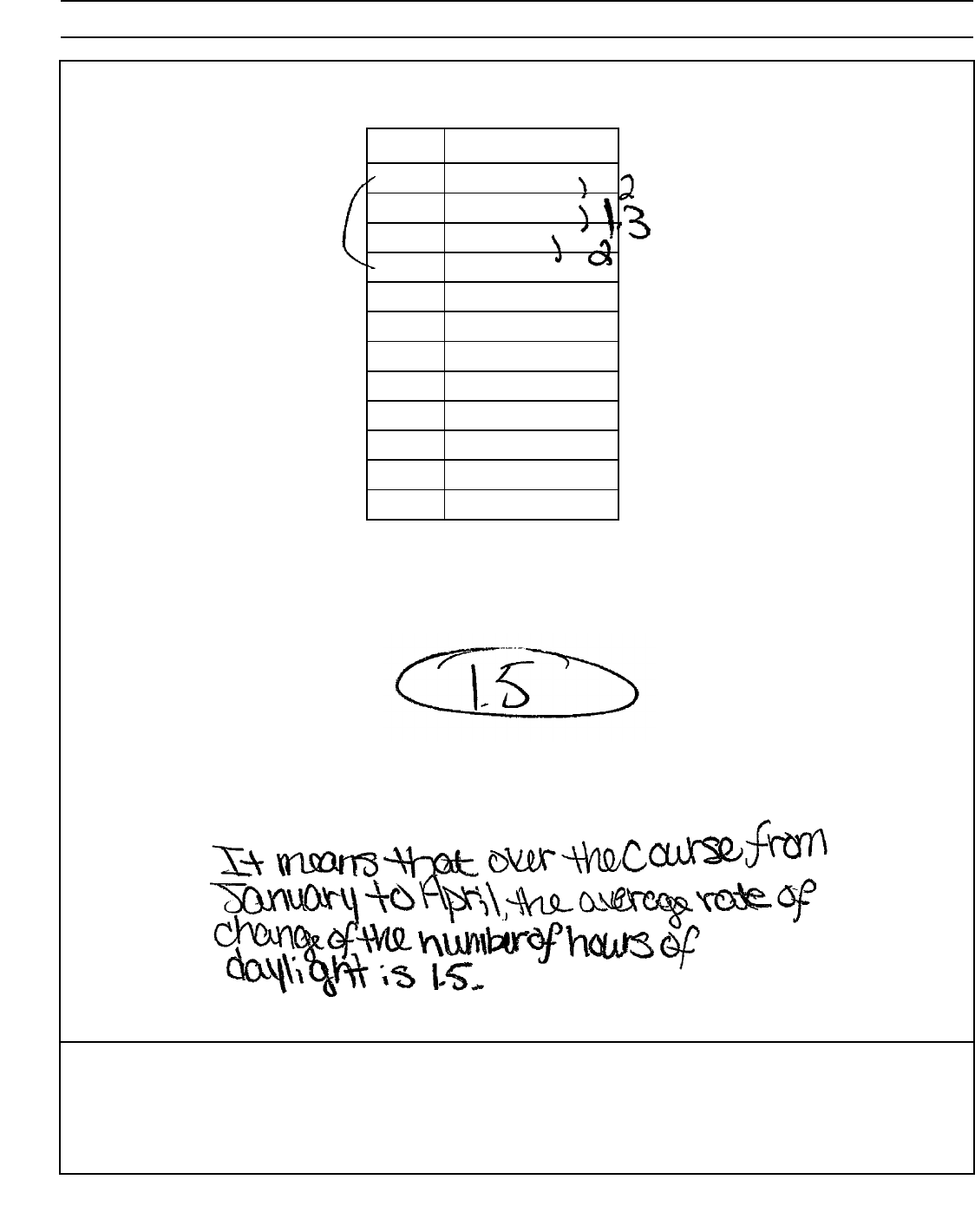
Algebra II – June ’19 [2]
Question 25
Month Hours of Daylight
Jan. 9.4
Feb. 10.6
March 11.9
April 13.9
May 14.7
June 15.4
July 15.1
Aug. 13.9
Sept. 12.5
Oct. 11.1
Nov. 9.7
Dec. 9.0
Score 2: The student gave a complete and correct response.
25 The table below shows the number of hours of daylight on the first day of each month in
Rochester
,
NY.
Given the data, what is the average rate of change in hours of daylight per month from January 1st
to April 1st?
Interpret what this means in the context of the problem. Interpret what this means in the context of the problem.
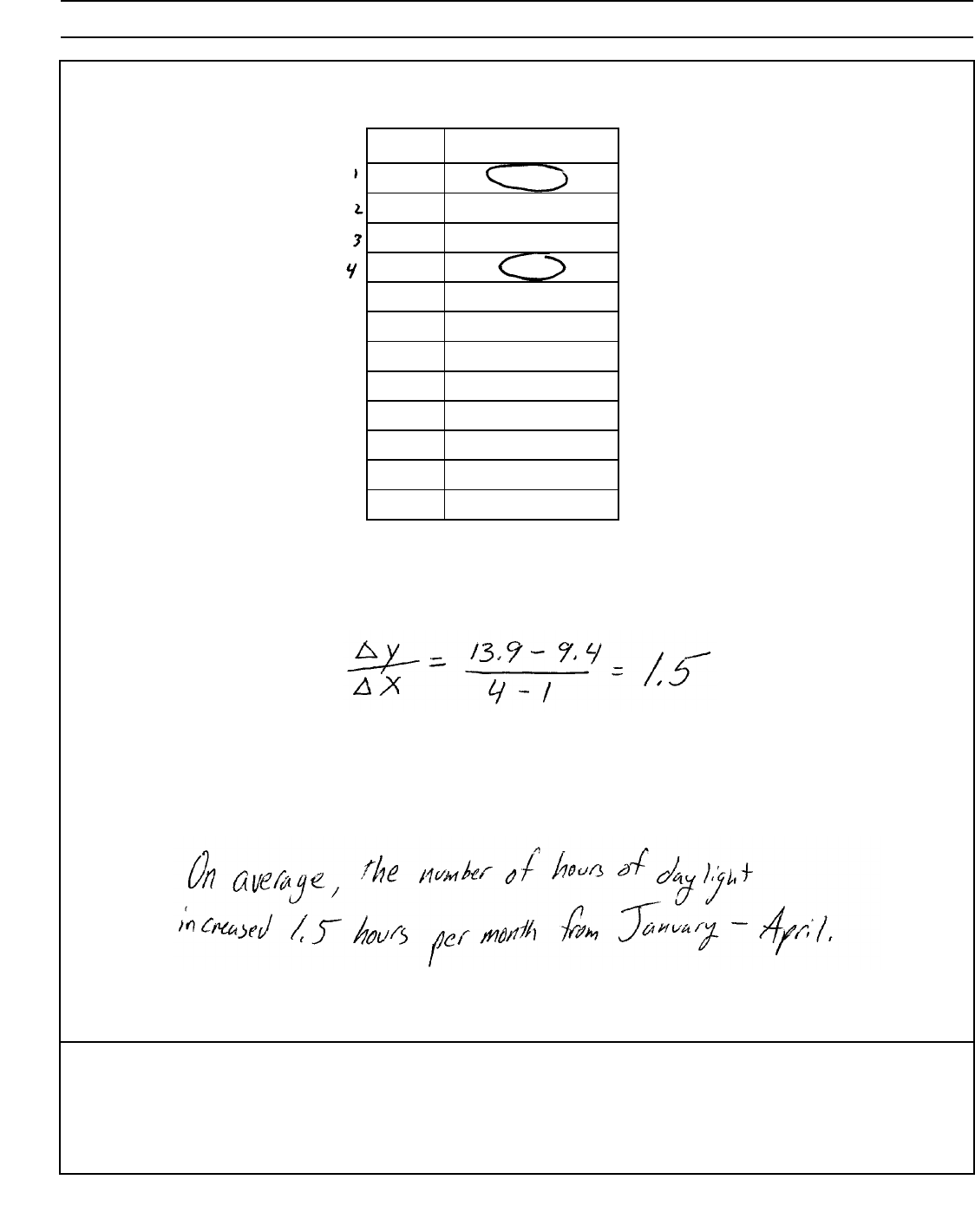
Algebra II – June ’19 [3]
Question 25
Month Hours of Daylight
Jan. 9.4
Feb. 10.6
March 11.9
April 13.9
May 14.7
June 15.4
July 15.1
Aug. 13.9
Sept. 12.5
Oct. 11.1
Nov. 9.7
Dec. 9.0
Score 2: The student gave a complete and correct response.
25 The table below shows the number of hours of daylight on the first day of each month in
Rochester
,
NY.
Given the data, what is the average rate of change in hours of daylight per month from January 1st
to April 1st?
Interpret what this means in the context of the problem.
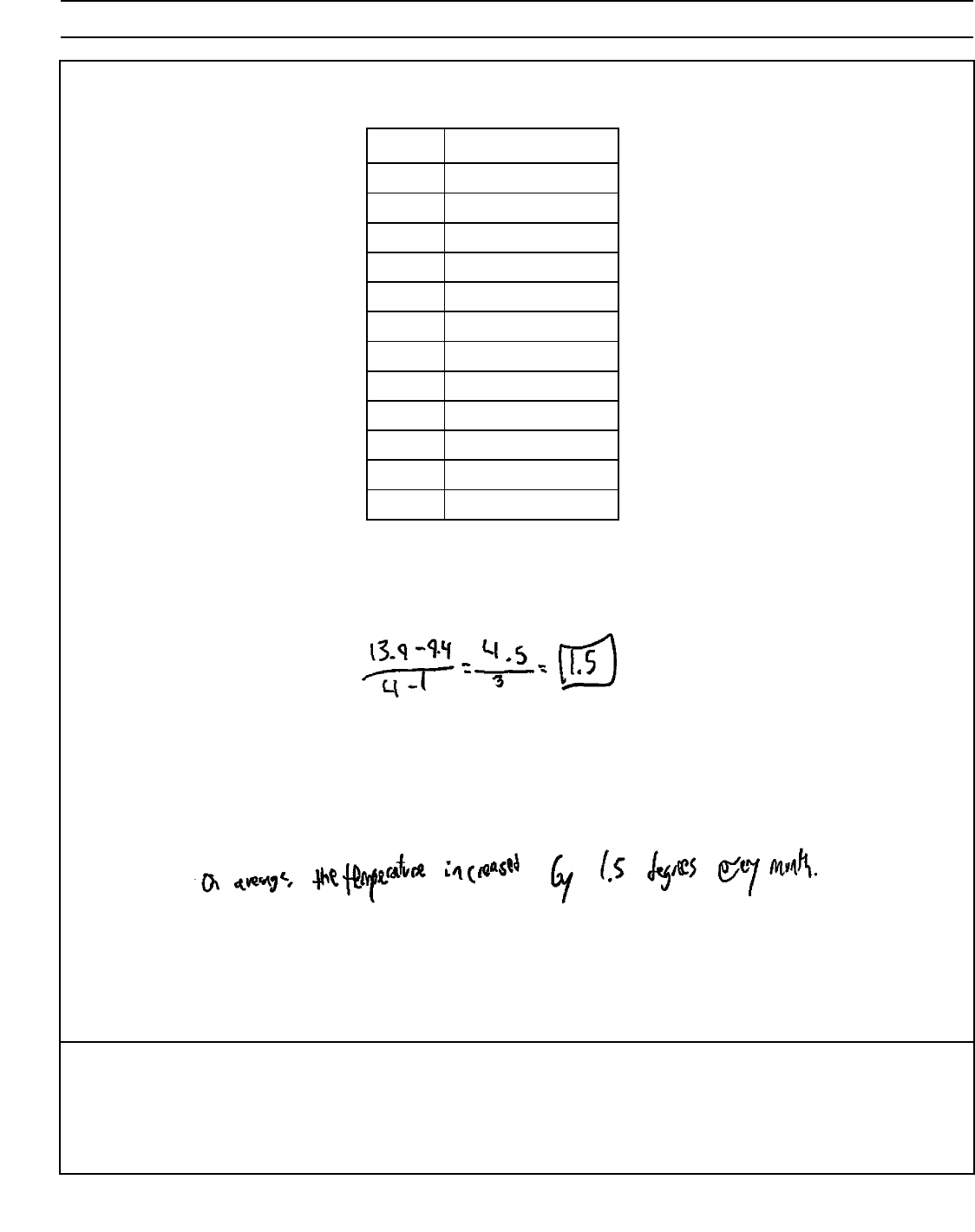
Algebra II – June ’19 [4]
Question 25
Month Hours of Daylight
Jan. 9.4
Feb. 10.6
March 11.9
April 13.9
May 14.7
June 15.4
July 15.1
Aug. 13.9
Sept. 12.5
Oct. 11.1
Nov. 9.7
Dec. 9.0
Score 1: The student gave an incorrect interpretation.
25 The table below shows the number of hours of daylight on the first day of each month in
Rochester
,
NY.
Given the data, what is the average rate of change in hours of daylight per month from January 1st
to April 1st?
Interpret what this means in the context of the problem.
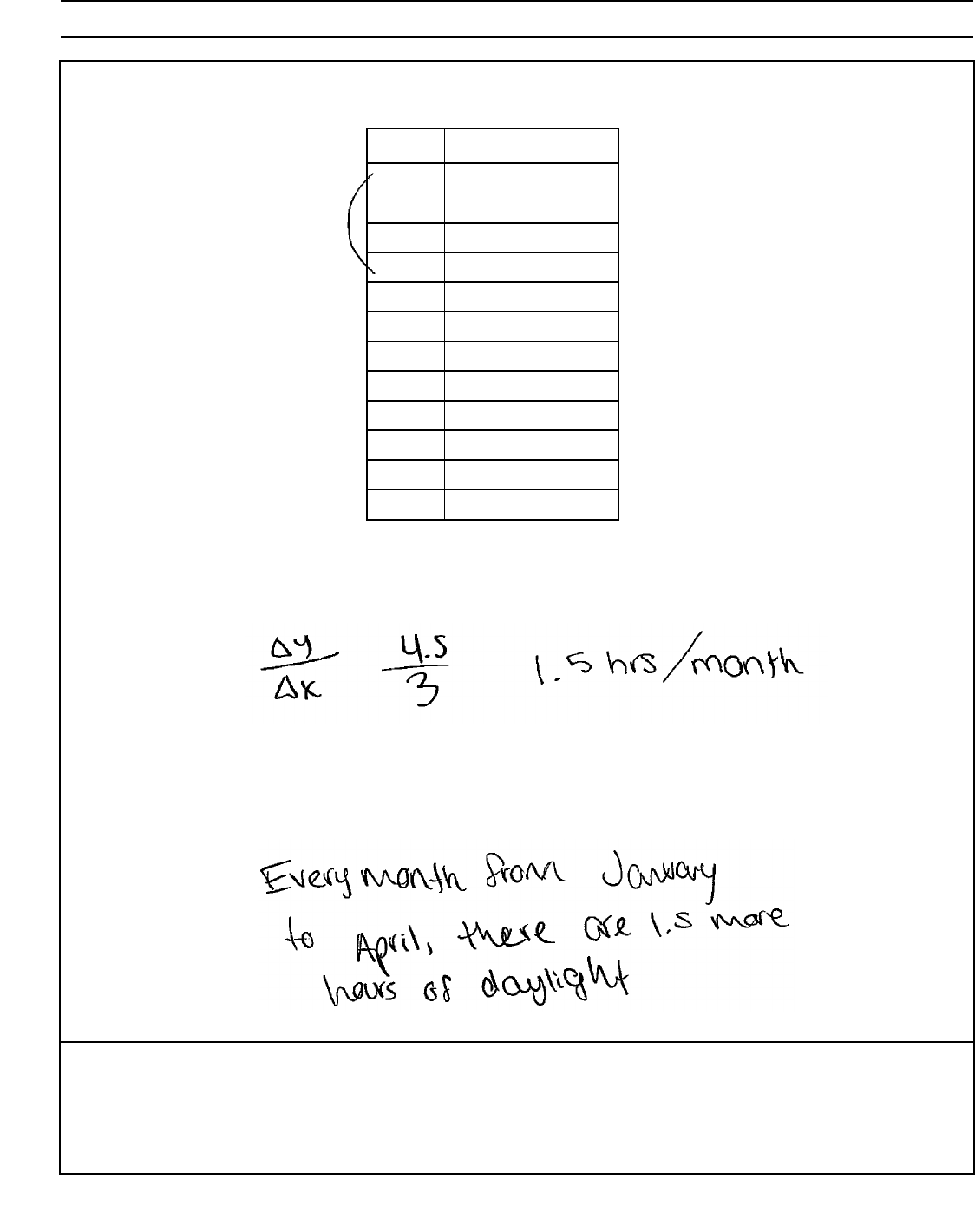
Algebra II – June ’19 [5]
Question 25
Month Hours of Daylight
Jan. 9.4
Feb. 10.6
March 11.9
April 13.9
May 14.7
June 15.4
July 15.1
Aug. 13.9
Sept. 12.5
Oct. 11.1
Nov. 9.7
Dec. 9.0
Score 1: The student gave an incomplete interpretation.
25 The table below shows the number of hours of daylight on the first day of each month in
Rochester
,
NY.
Given the data, what is the average rate of change in hours of daylight per month from January 1st
to April 1st?
Interpret what this means in the context of the problem.
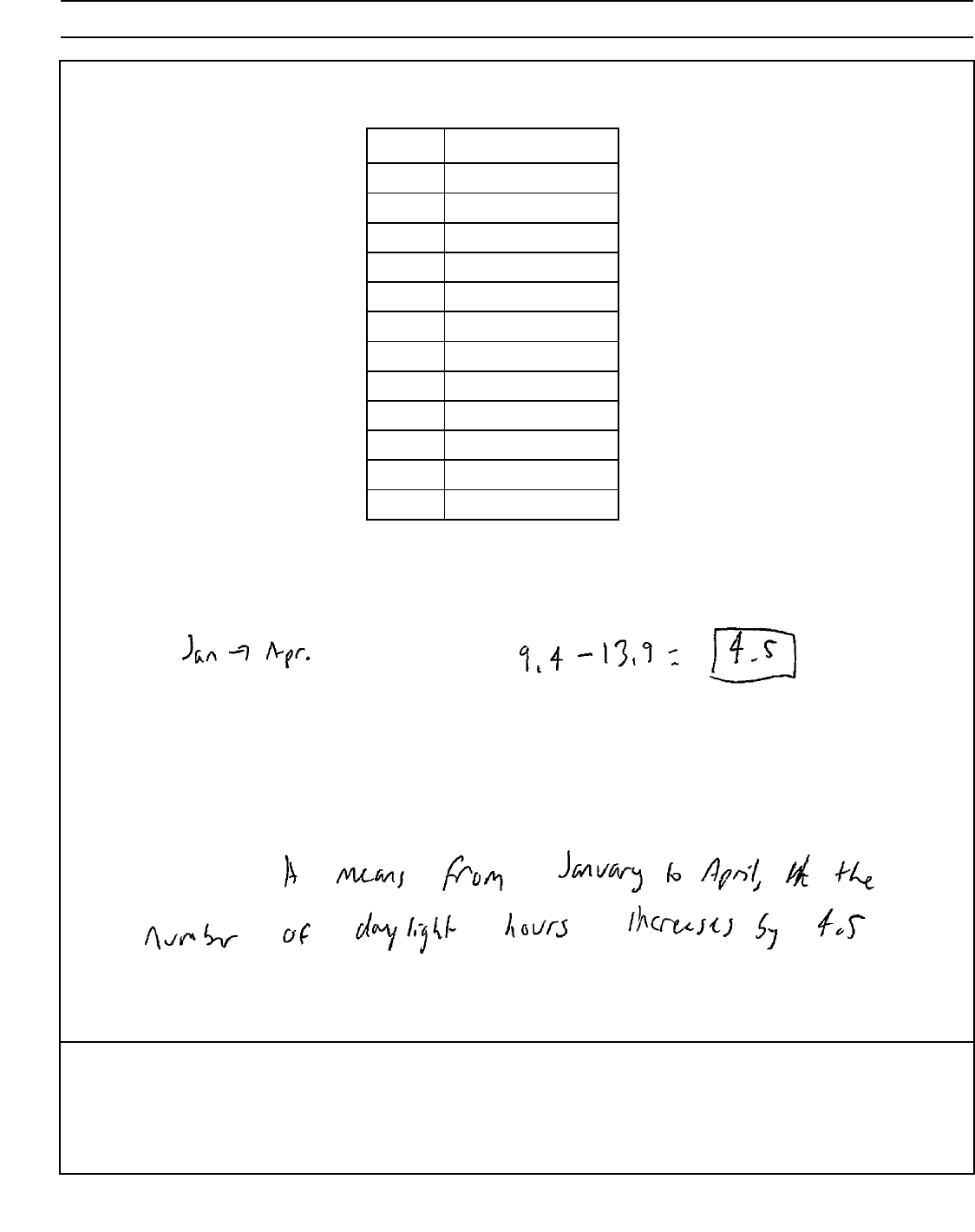
Algebra II – June ’19 [6]
Question 25
Month Hours of Daylight
Jan. 9.4
Feb. 10.6
March 11.9
April 13.9
May 14.7
June 15.4
July 15.1
Aug. 13.9
Sept. 12.5
Oct. 11.1
Nov. 9.7
Dec. 9.0
Score 0: The student found an incorrect average rate of change and wrote an incomplete
interpretation.
25 The table below shows the number of hours of daylight on the first day of each month in
Rochester
,
NY.
Given the data, what is the average rate of change in hours of daylight per month from January 1st
to April 1st?
Interpret what this means in the context of the problem.
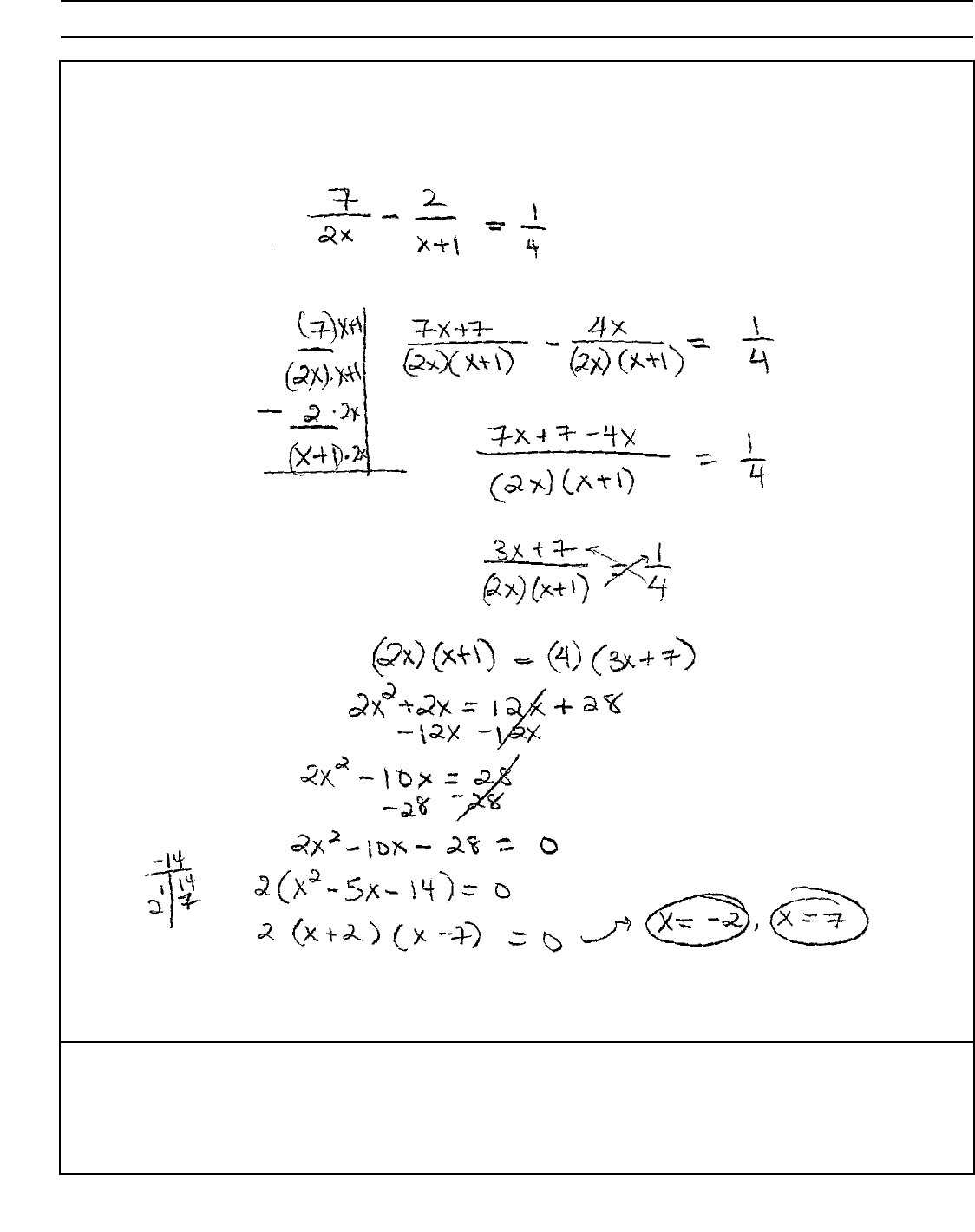
Algebra II – June ’19 [7]
Question 26
Score 2: The student gave a complete and correct response.
26 Algebraically solve for x:
7
___
2x
2
_____
x 1
1
__
4
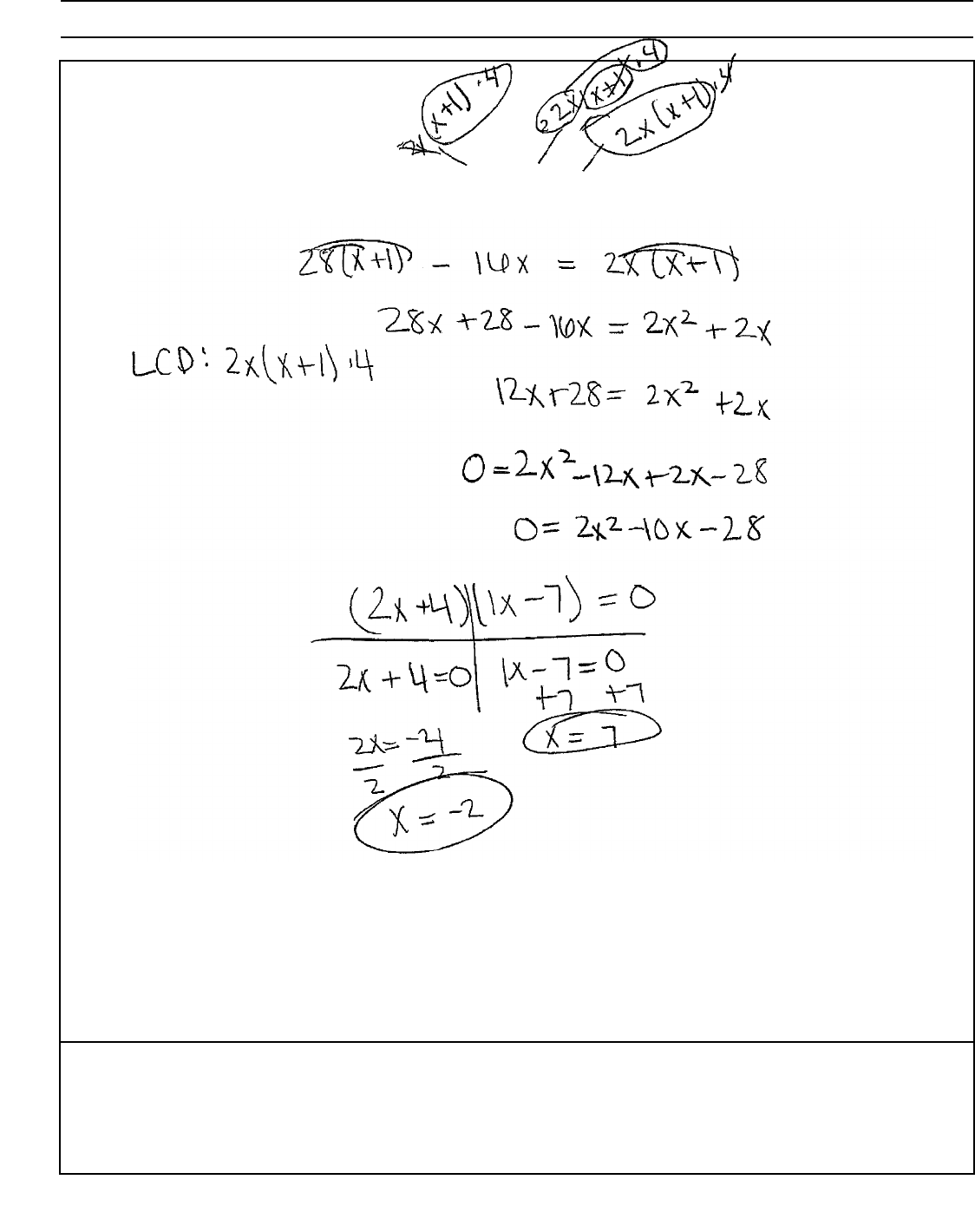
Algebra II – June ’19 [8]
Question 26
Score 2: The student gave a complete and correct response.
26 Algebraically solve for x:
7
___
2x
2
_____
x 1
1
__
4
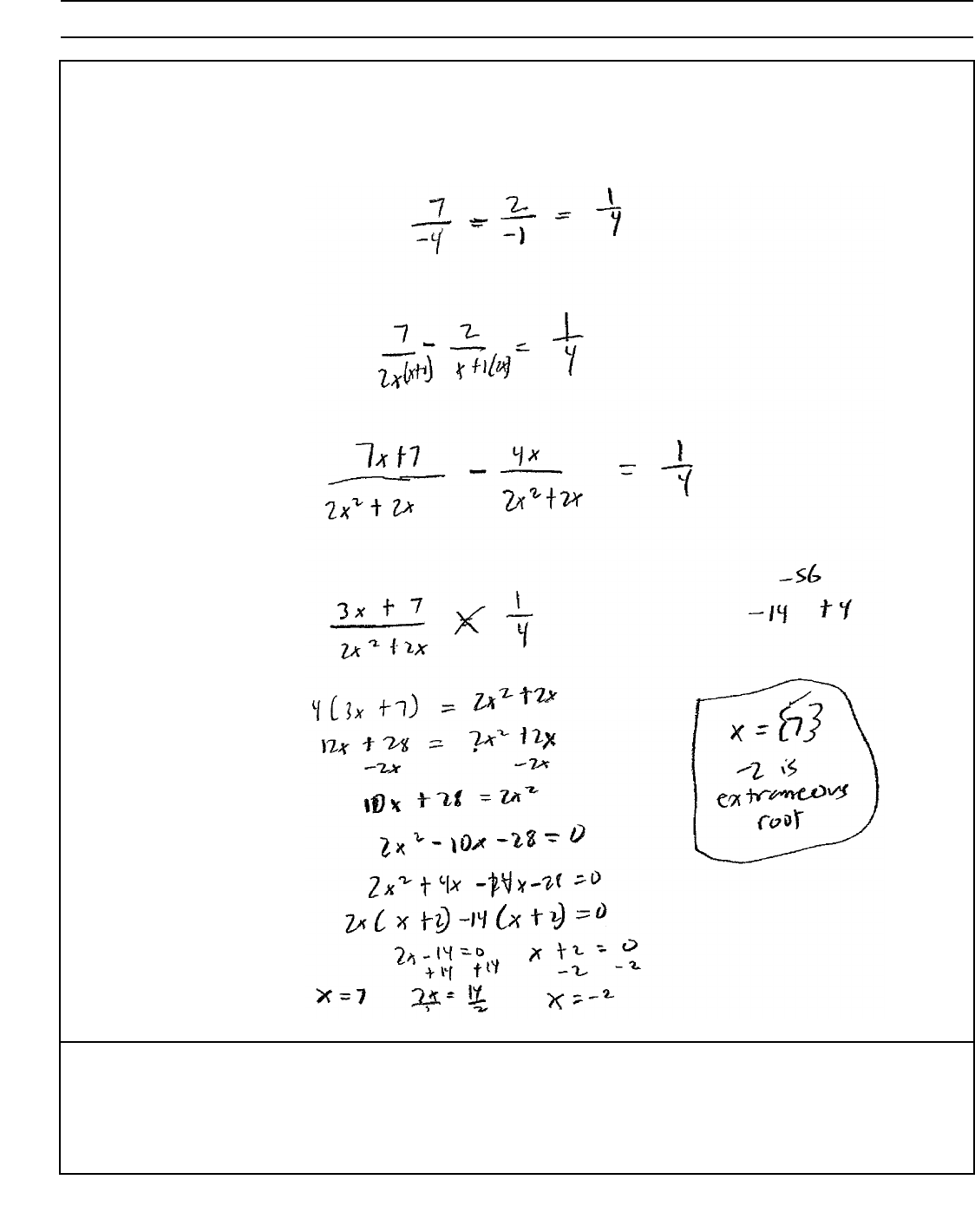
Algebra II – June ’19 [9]
Question 26
Score 1: The student incorrectly identified 2 as an extraneous root.
26 Algebraically solve for x:
7
___
2x
2
_____
x 1
1
__
4
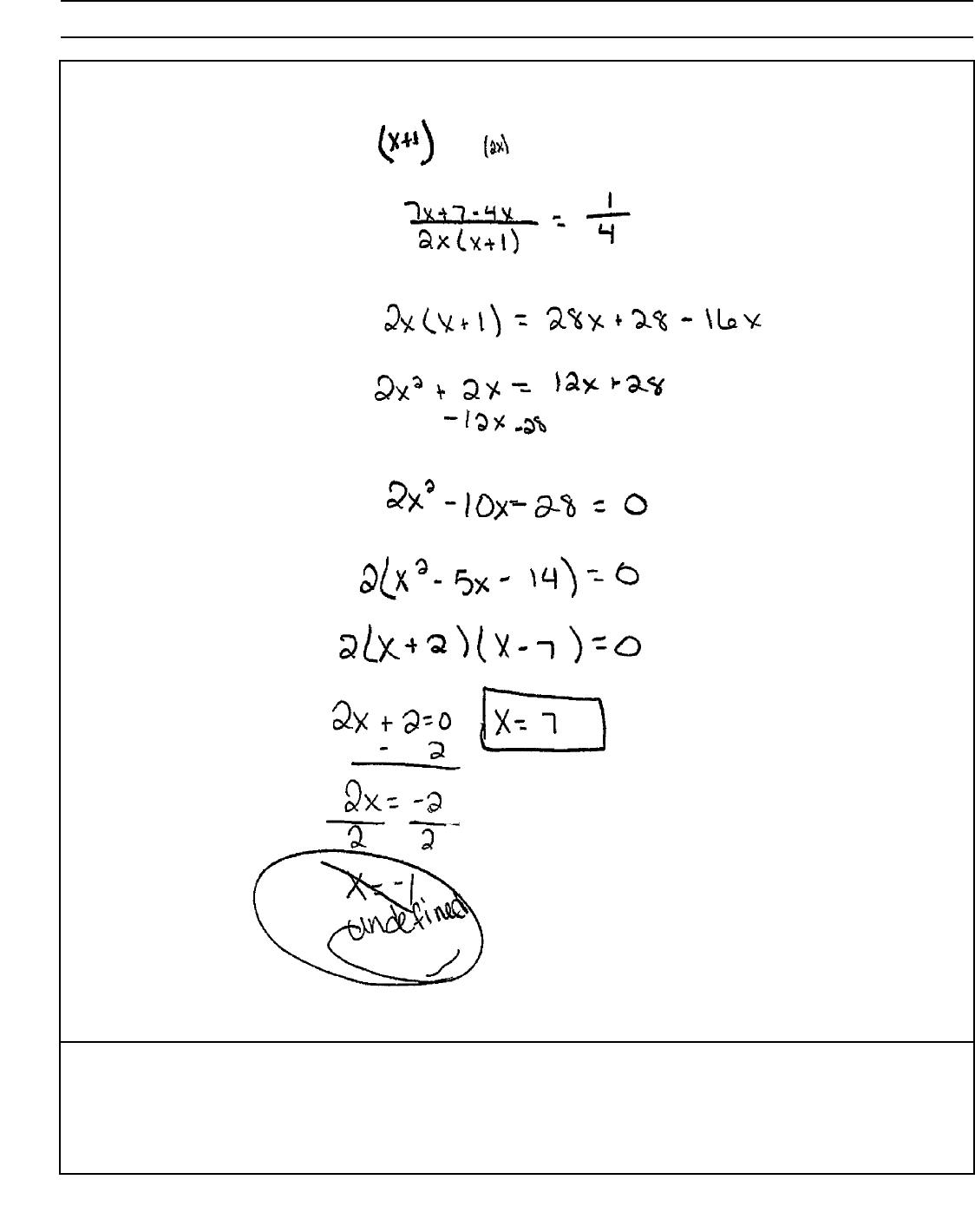
Algebra II – June ’19 [10]
Question 26
Score 1: The student made a computational error by not distributing the 2 correctly.
26 Algebraically solve for x:
7
___
2x
2
_____
x 1
1
__
4
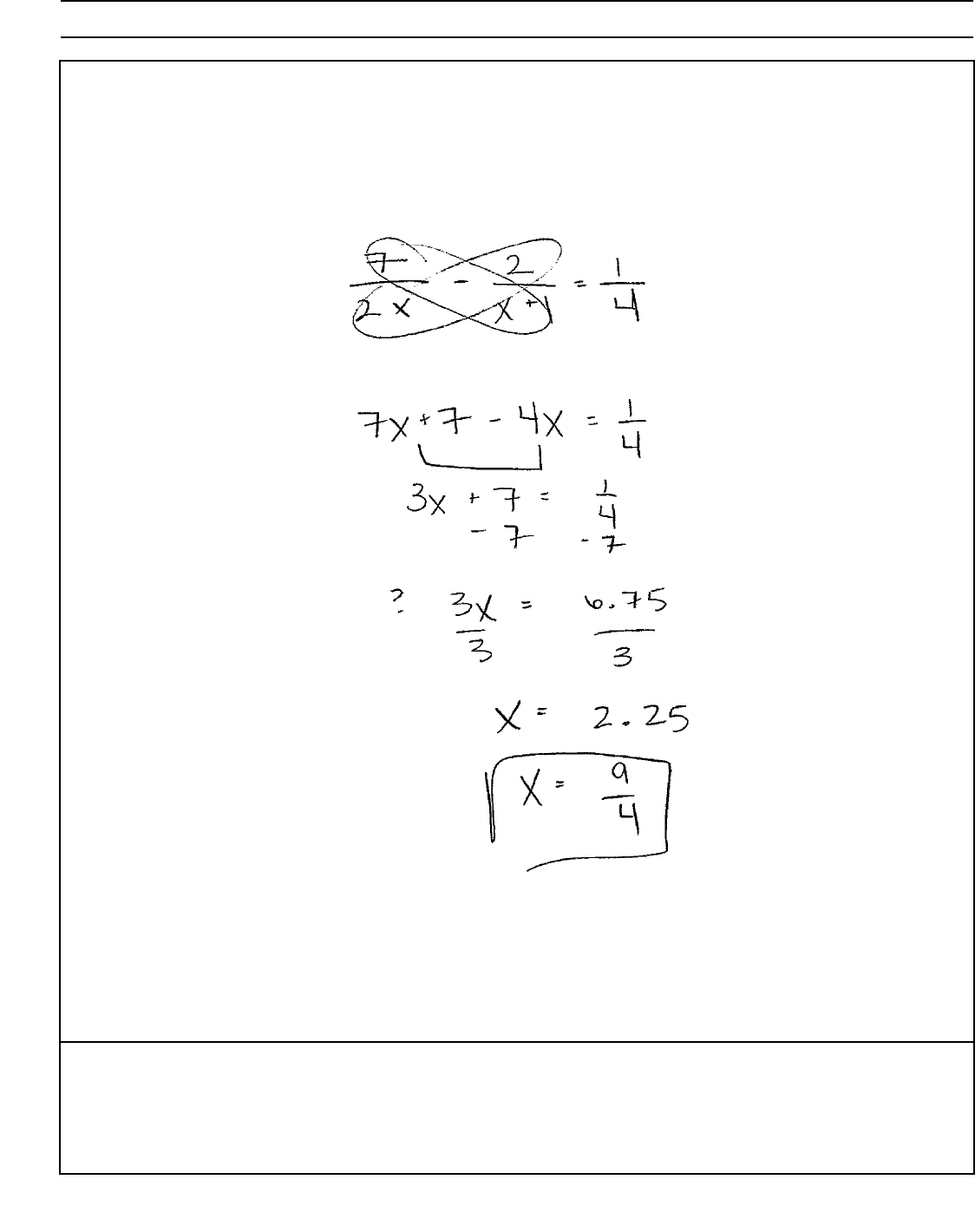
Algebra II – June ’19 [11]
Question 26
Score 0: The student made a conceptual error and a computational error.
26 Algebraically solve for x:
7
___
2x
2
_____
x 1
1
__
4
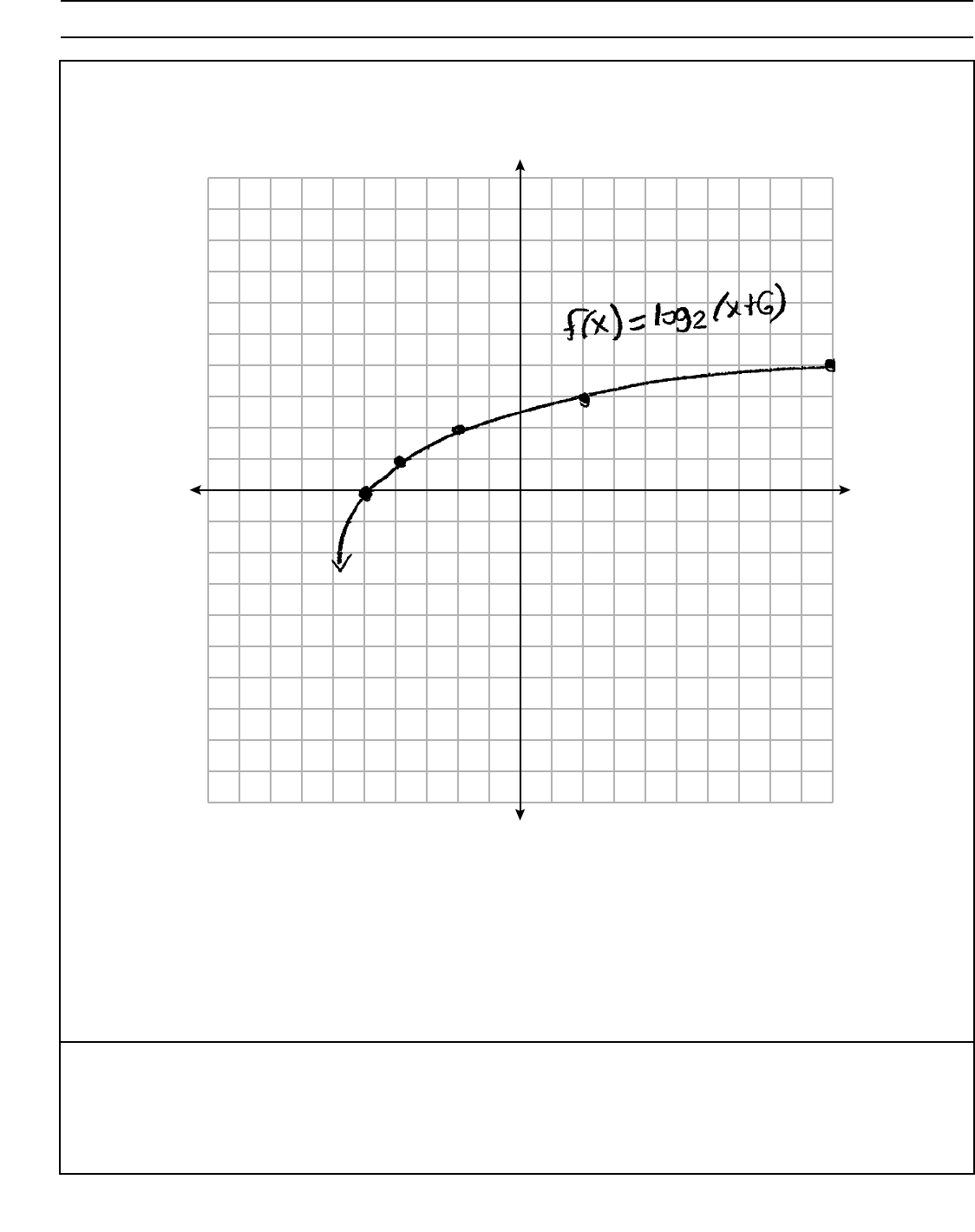
Algebra II – June ’19 [12]
Question 27
Score 2: The student gave a complete and correct response.
27 Graph f(x) log
2
(x 6) on the set of axes below.
f(x)
x
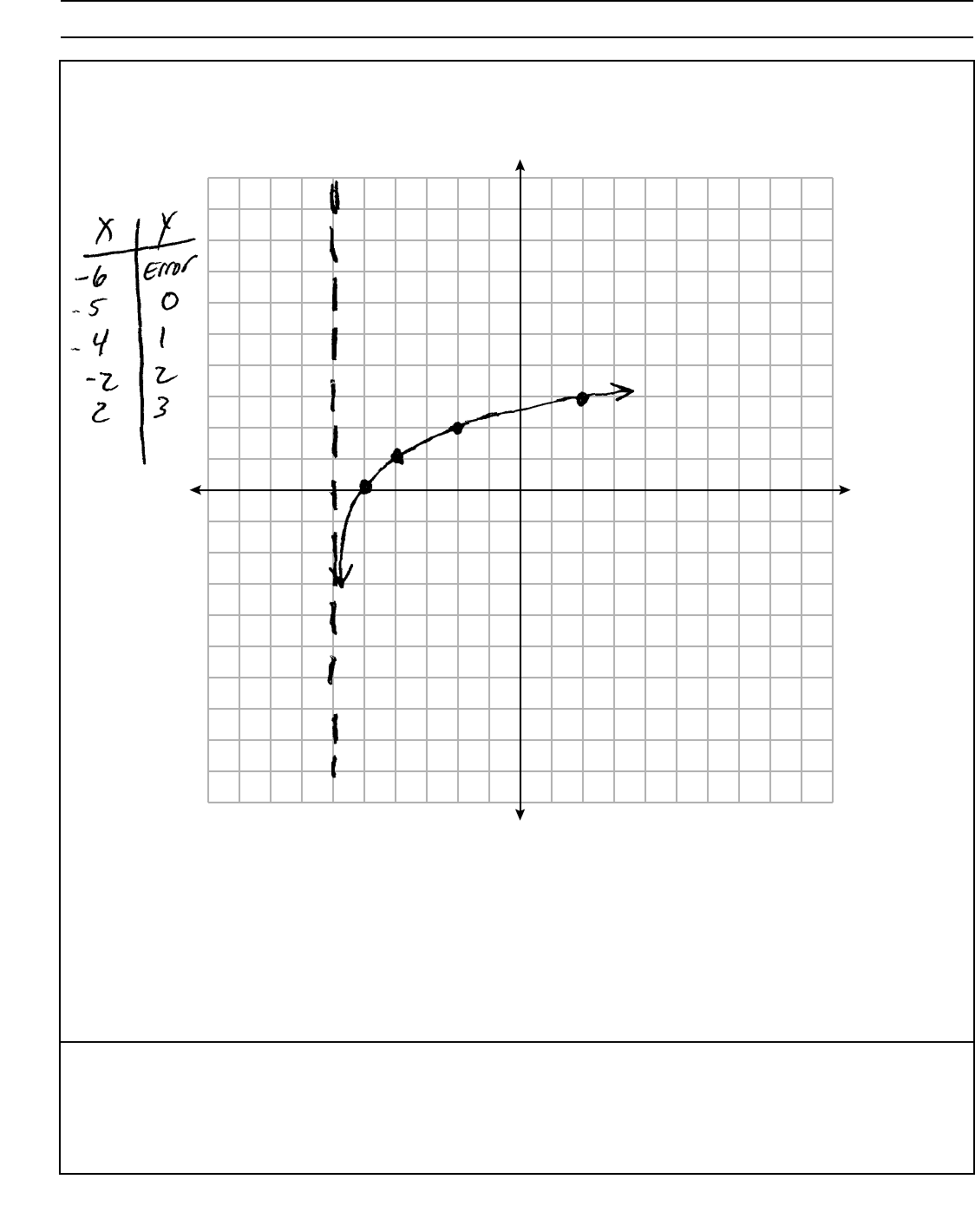
Algebra II – June ’19 [13]
Question 27
Score 2: The student gave a complete and correct response.
27 Graph f(x) log
2
(x 6) on the set of axes below.
f(x)
x
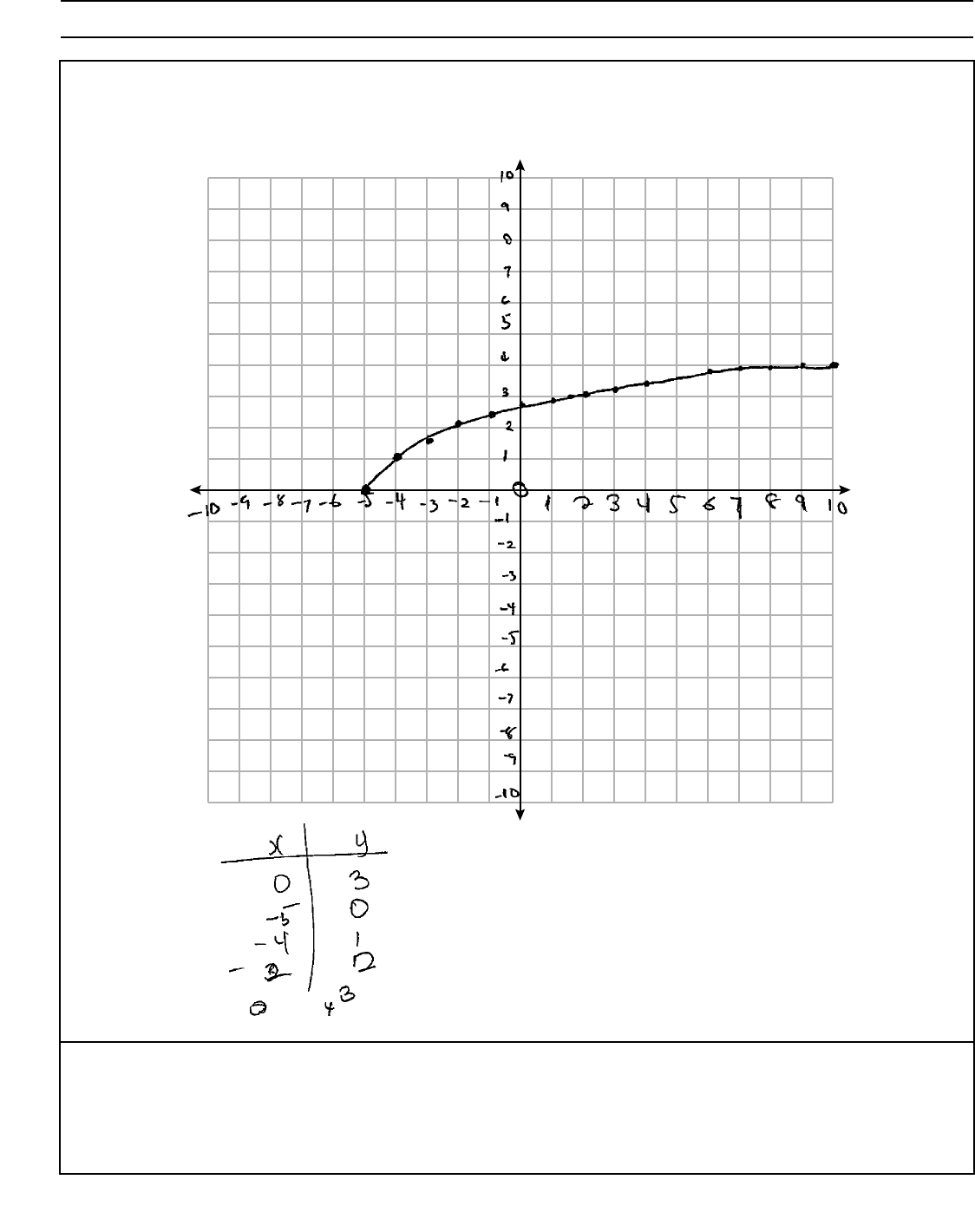
Algebra II – June ’19 [14]
Question 27
Score 1: The student made an error graphing the end behavior as x → 6.
27 Graph f(x) log
2
(x 6) on the set of axes below.
f(x)
x
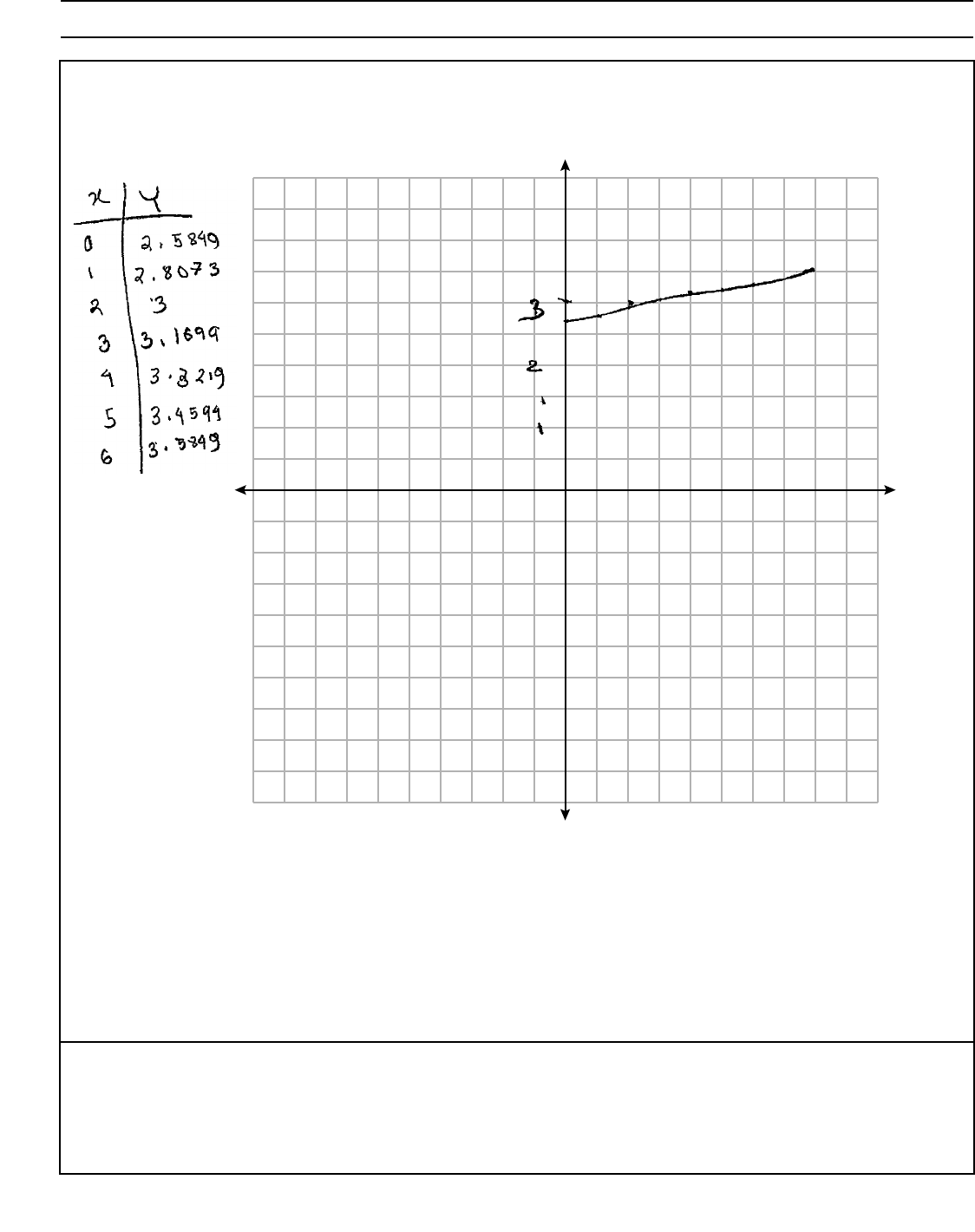
Algebra II – June ’19 [15]
Question 27
Score 0: The student made multiple graphing errors.
27 Graph f(x) log
2
(x 6) on the set of axes below.
f(x)
x
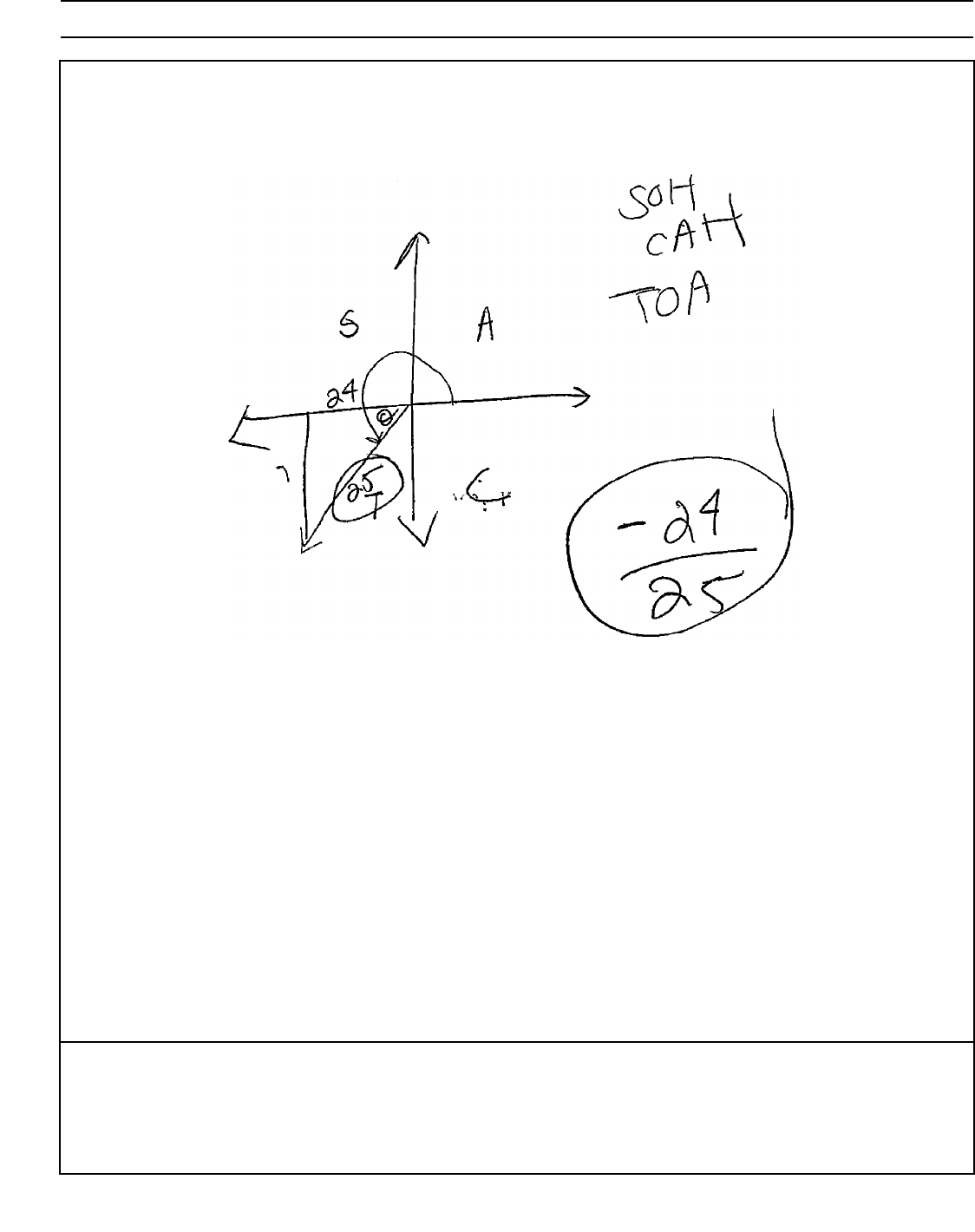
Algebra II – June ’19 [16]
Question 28
Score 2: The student gave a complete and correct response.
28 Given tan
7
___
24
, and terminates in Quadrant III, determine the value of cos .
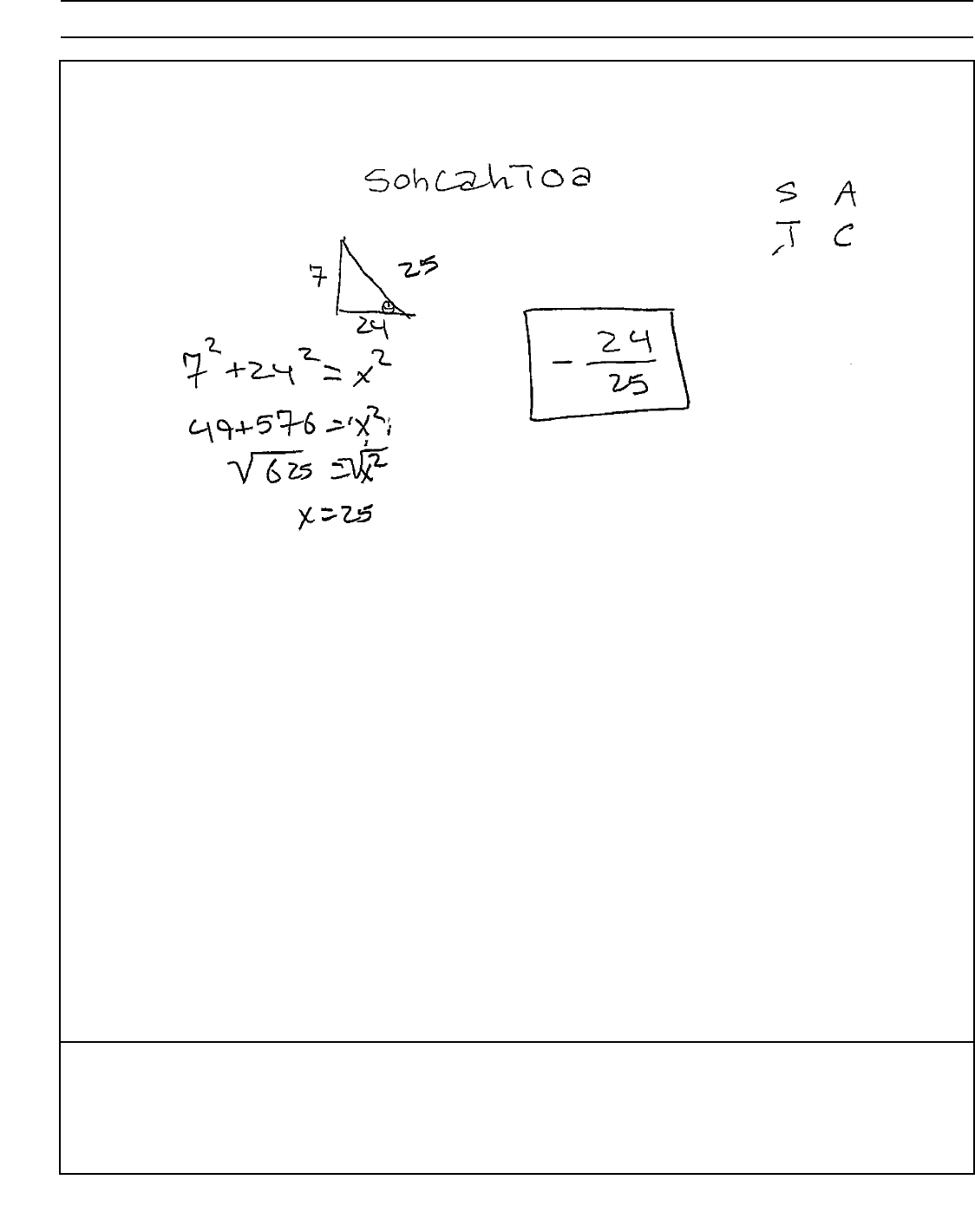
Algebra II – June ’19 [17]
Question 28
Score 2: The student gave a complete and correct response.
28 Given tan
7
___
24
, and terminates in Quadrant III, determine the value of cos .

Algebra II – June ’19 [18]
Question 28
Score 1: The student did not consider the quadrant.
28 Given tan
7
___
24
, and terminates in Quadrant III, determine the value of cos .
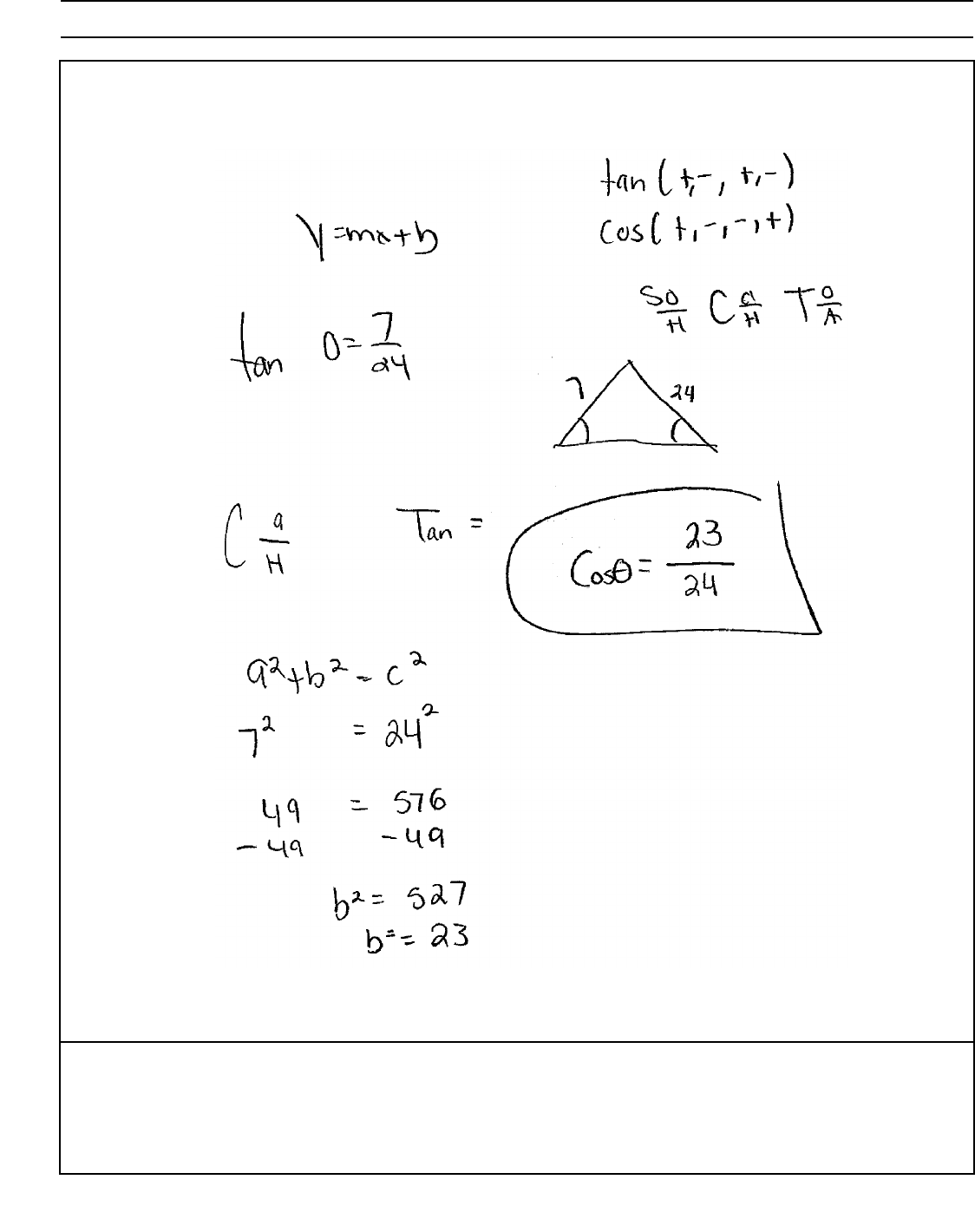
Algebra II – June ’19 [19]
Question 28
Score 0: The student did not show enough correct work to receive any credit.
28 Given tan
7
___
24
, and terminates in Quadrant III, determine the value of cos .
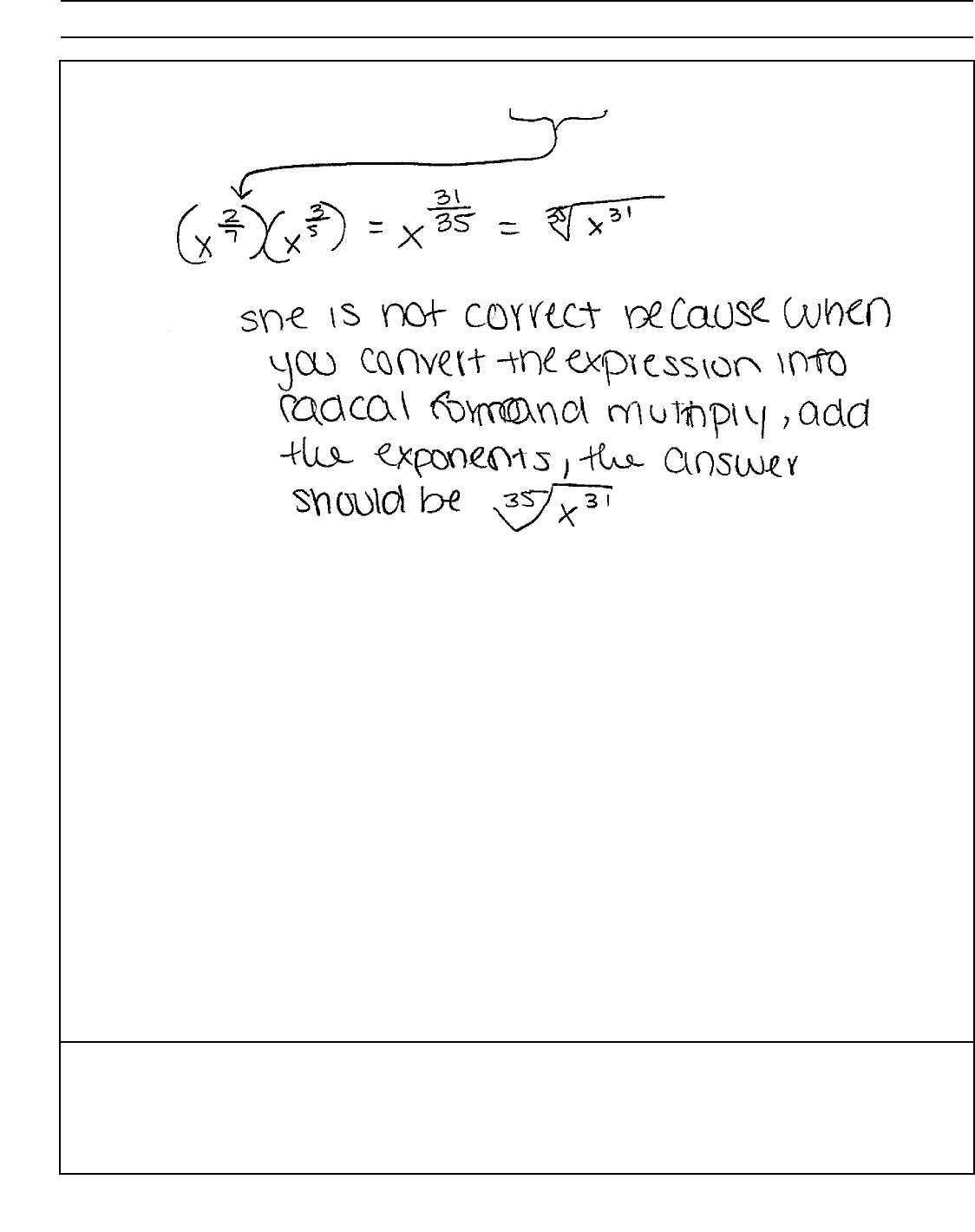
Algebra II – June ’19 [20]
Question 29
Score 2: The student gave a complete and correct response.
29 Kenzie believes that for x
0, the expression
(
7
兹
苵苵
x
2
)(
5
兹
苵苵
x
3
)
is equivalent to
35
兹
苵苵
x
6
. Is she correct?
Justify your response algebraically.
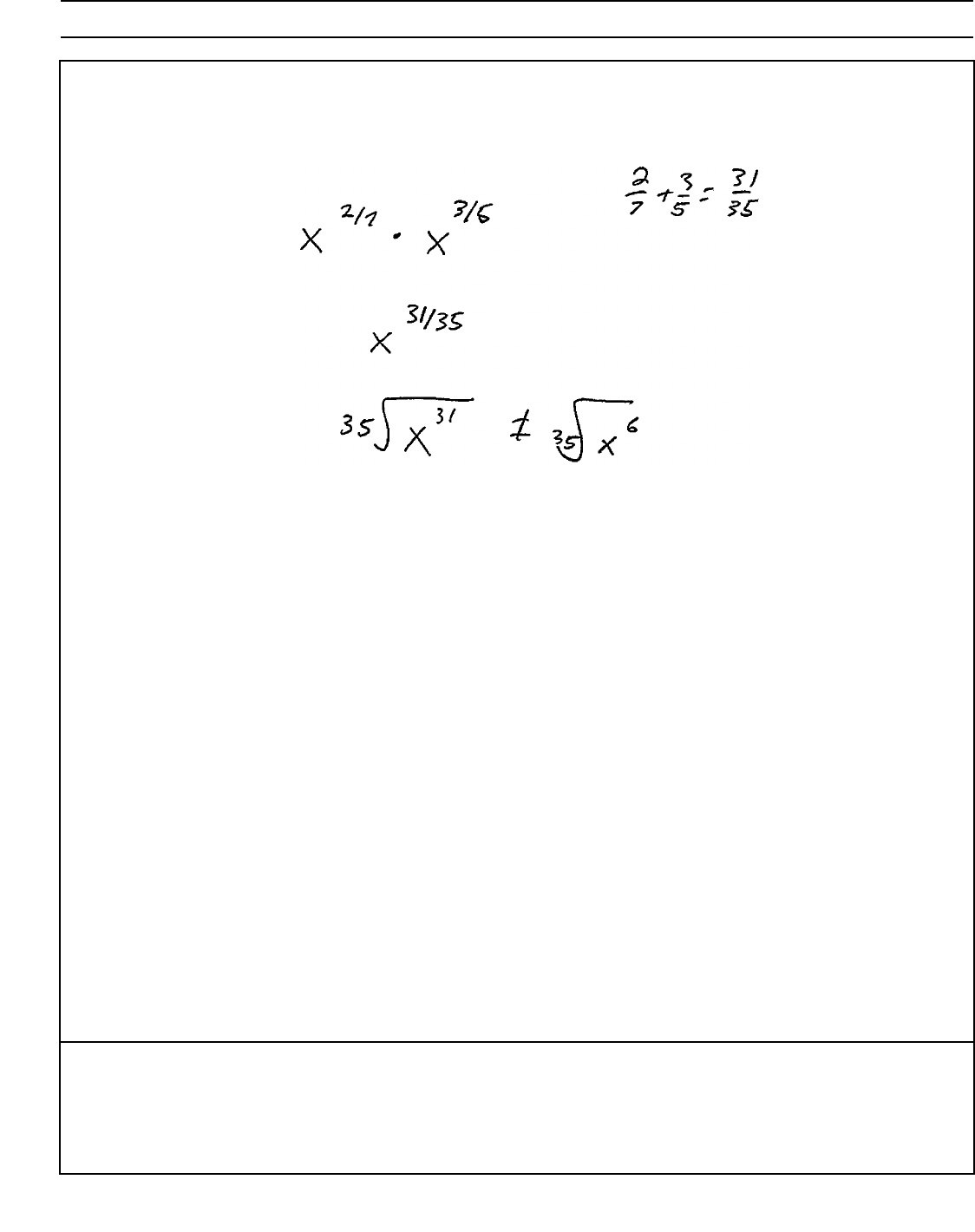
Algebra II – June ’19 [21]
Question 29
Score 2: The student gave a complete and correct response. It is indicated that Kenzie is
incorrect.
29 Kenzie believes that for x
0, the expression
(
7
兹
苵苵
x
2
)(
5
兹
苵苵
x
3
)
is equivalent to
35
兹
苵苵
x
6
. Is she correct?
Justify your response algebraically.
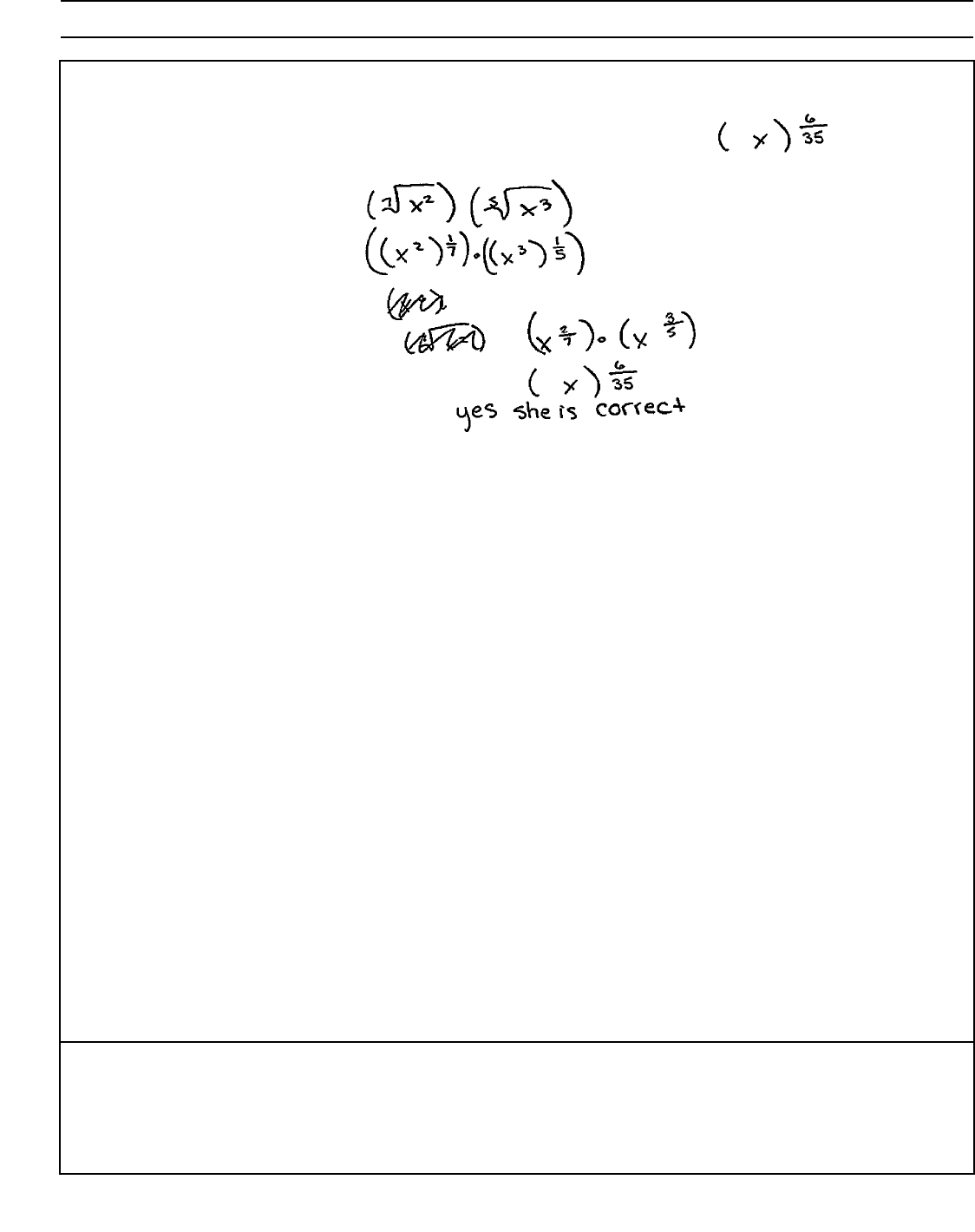
Algebra II – June ’19 [22]
Question 29
Score 1: The student applied exponent properties incorrectly.
29 Kenzie believes that for x
0, the expression
(
7
兹
苵苵
x
2
)(
5
兹
苵苵
x
3
)
is equivalent to
35
兹
苵苵
x
6
. Is she correct?
Justify your response algebraically.
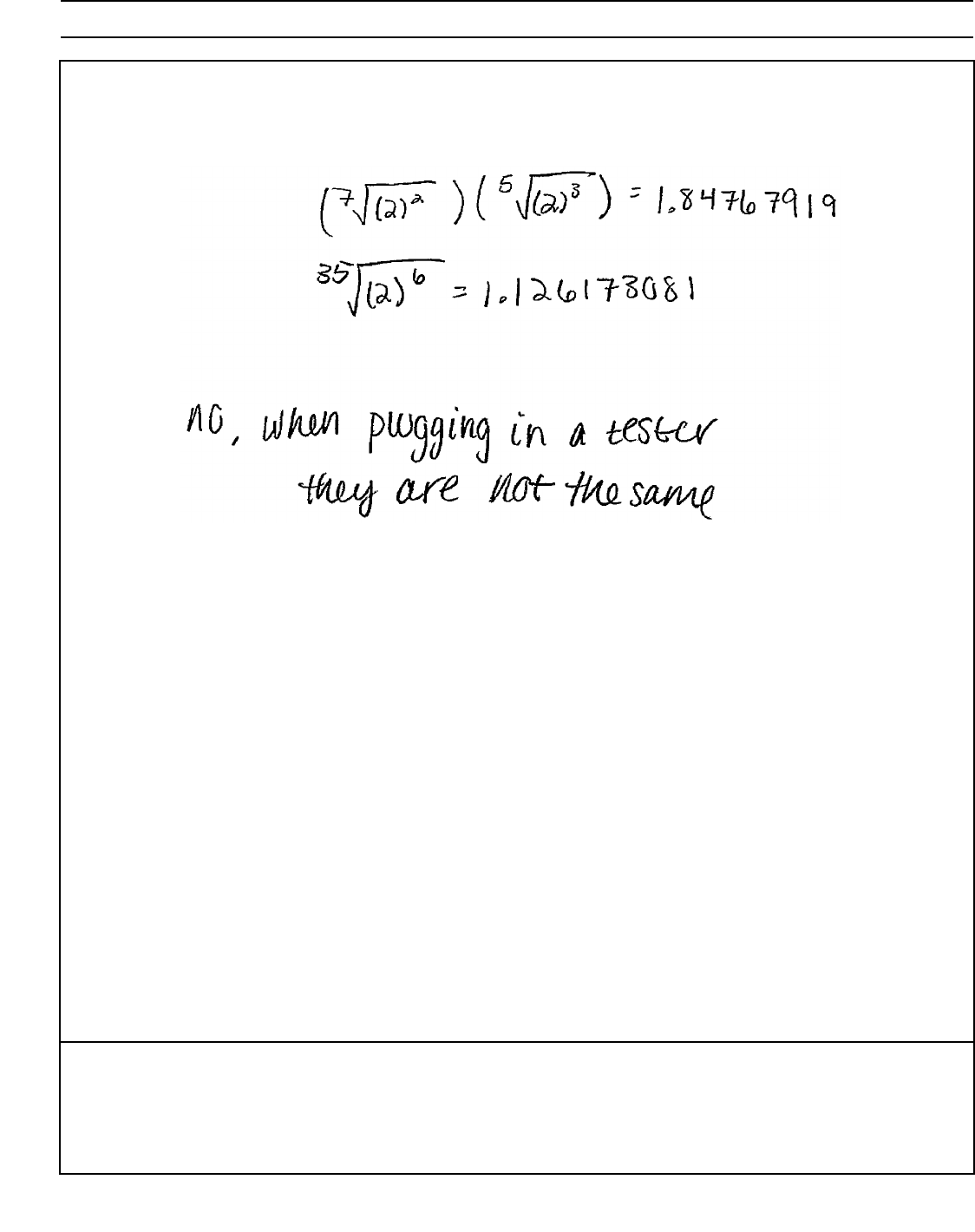
Algebra II – June ’19 [23]
Question 29
Score 1: The student used a method other than algebraic by showing a contradiction.
29 Kenzie believes that for x
0, the expression
(
7
兹
苵苵
x
2
)(
5
兹
苵苵
x
3
)
is equivalent to
35
兹
苵苵
x
6
. Is she correct?
Justify your response algebraically.
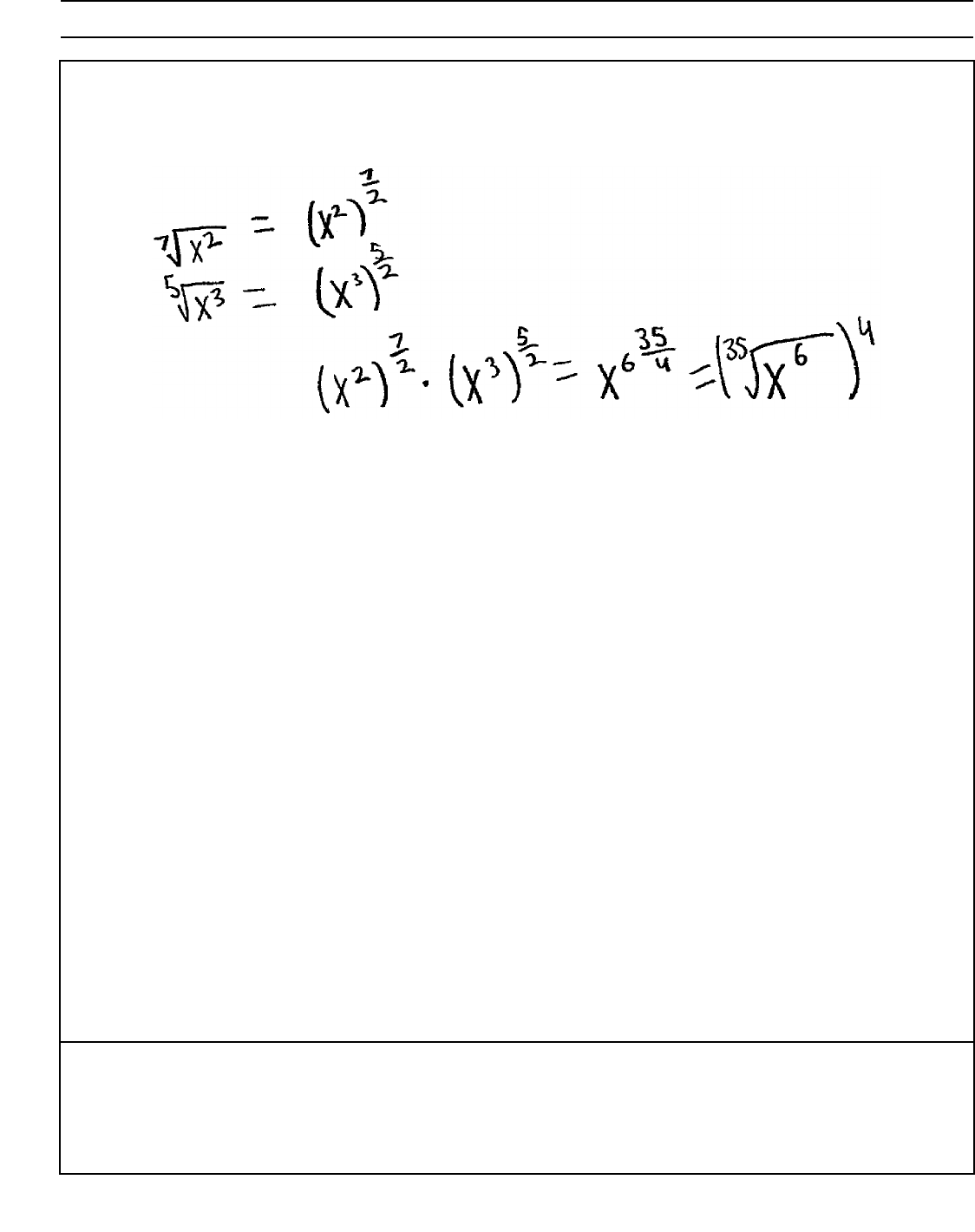
Algebra II – June ’19 [24]
Question 29
Score 0: The student made multiple errors.
29 Kenzie believes that for x
0, the expression
(
7
兹
苵苵
x
2
)(
5
兹
苵苵
x
3
)
is equivalent to
35
兹
苵苵
x
6
. Is she correct?
Justify your response algebraically.
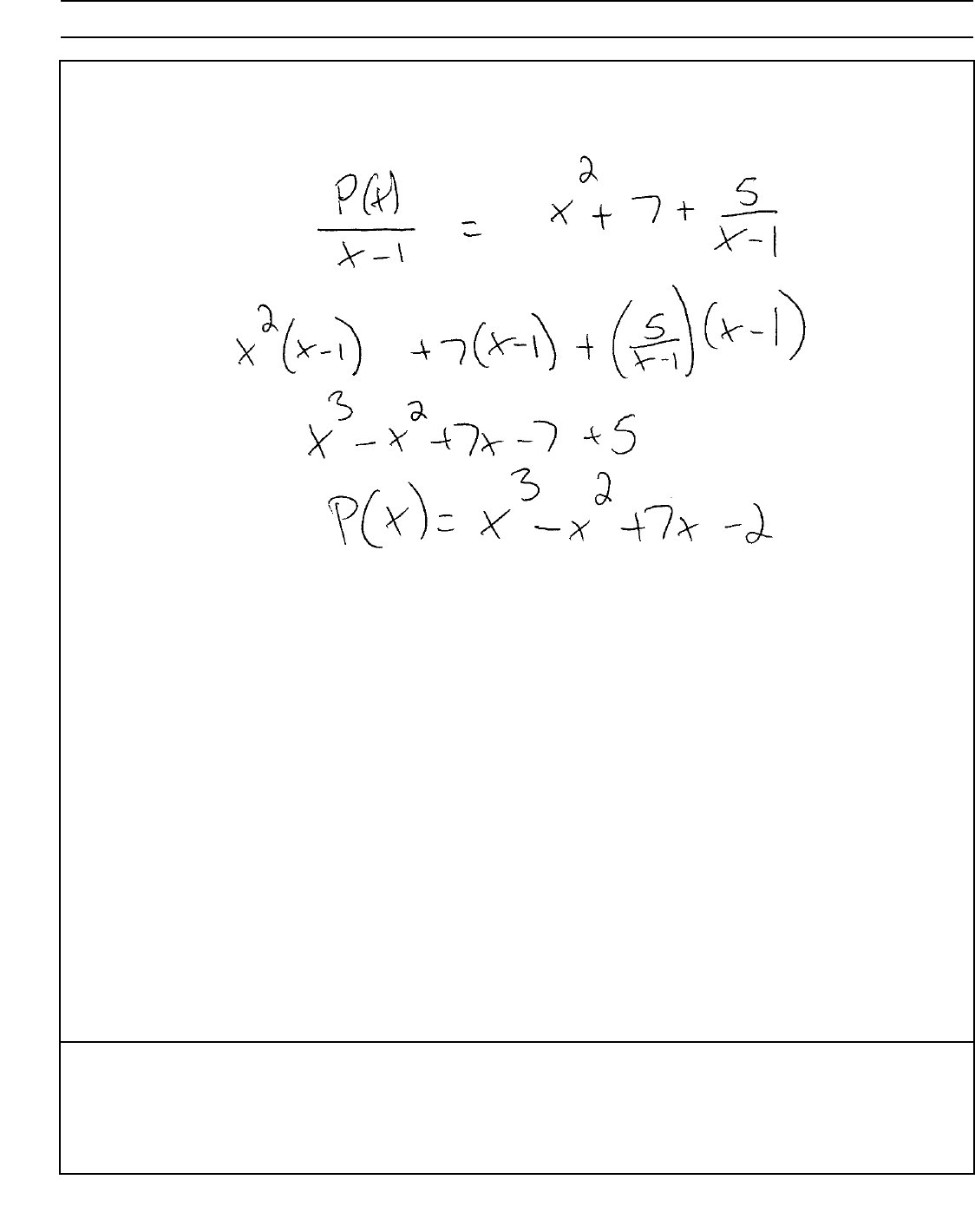
Algebra II – June ’19 [25]
Question 30
Score 2: The student gave a complete and correct response.
30 When the function p(x) is divided by x 1 the quotient is x
2
7
5
_____
x 1
. State p(x) in standard
form.
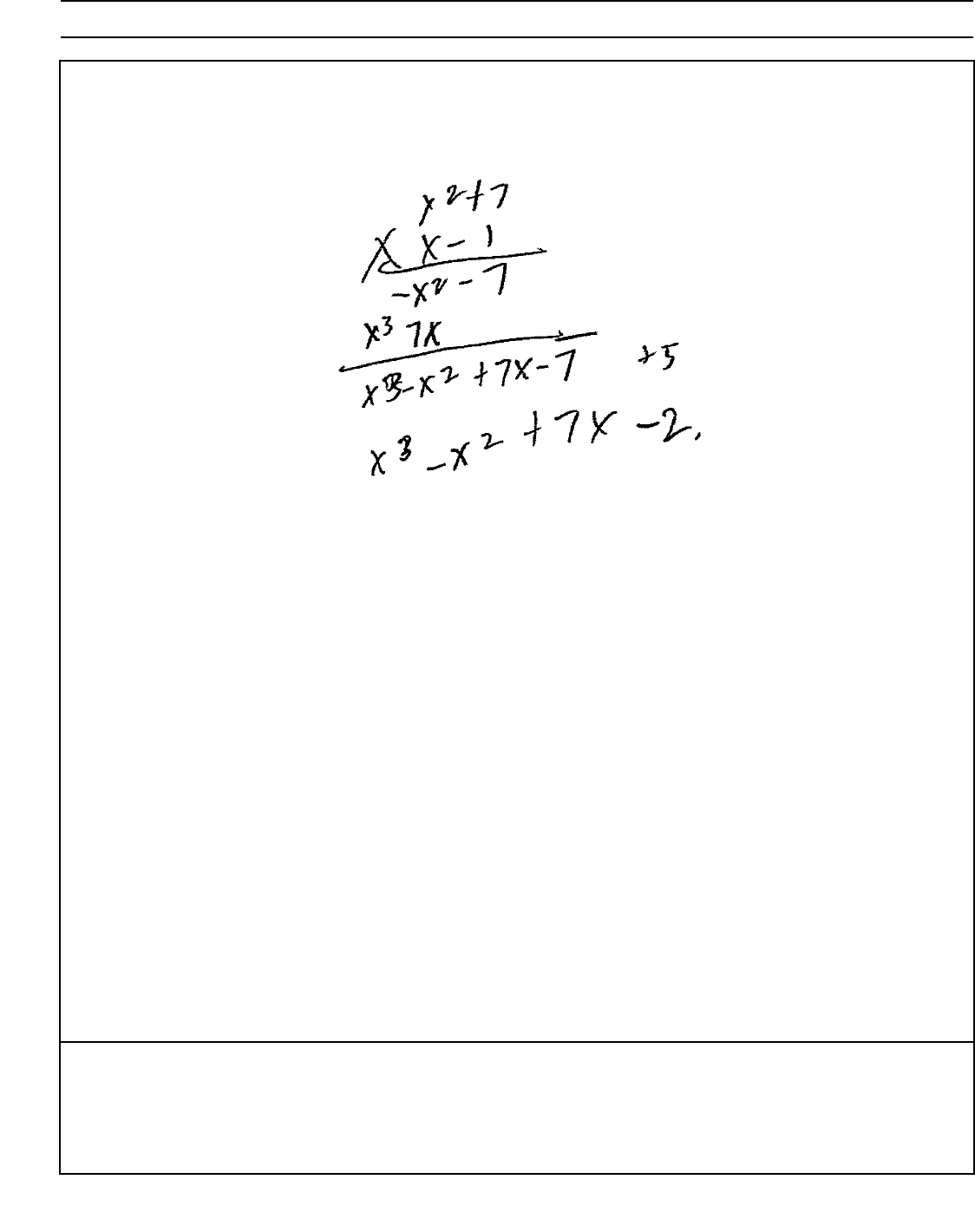
Algebra II – June ’19 [26]
Question 30
Score 2: The student gave a complete and correct response.
30 When the function p(x) is divided by x 1 the quotient is x
2
7
5
_____
x 1
. State p(x) in standard
form.
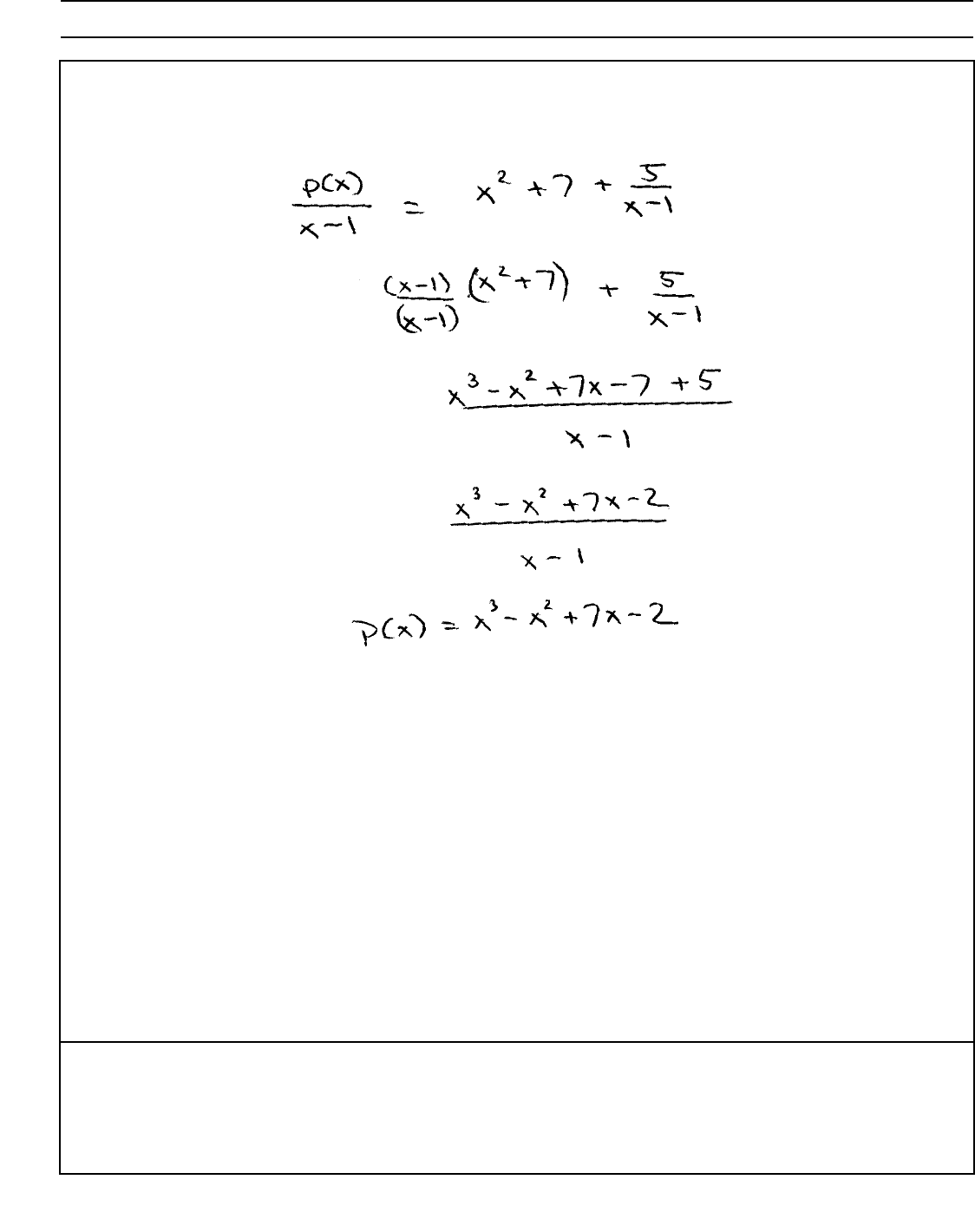
Algebra II – June ’19 [27]
Question 30
Score 2: The student gave a complete and correct response.
30 When the function p(x) is divided by x 1 the quotient is x
2
7
5
_____
x 1
. State p(x) in standard
form.
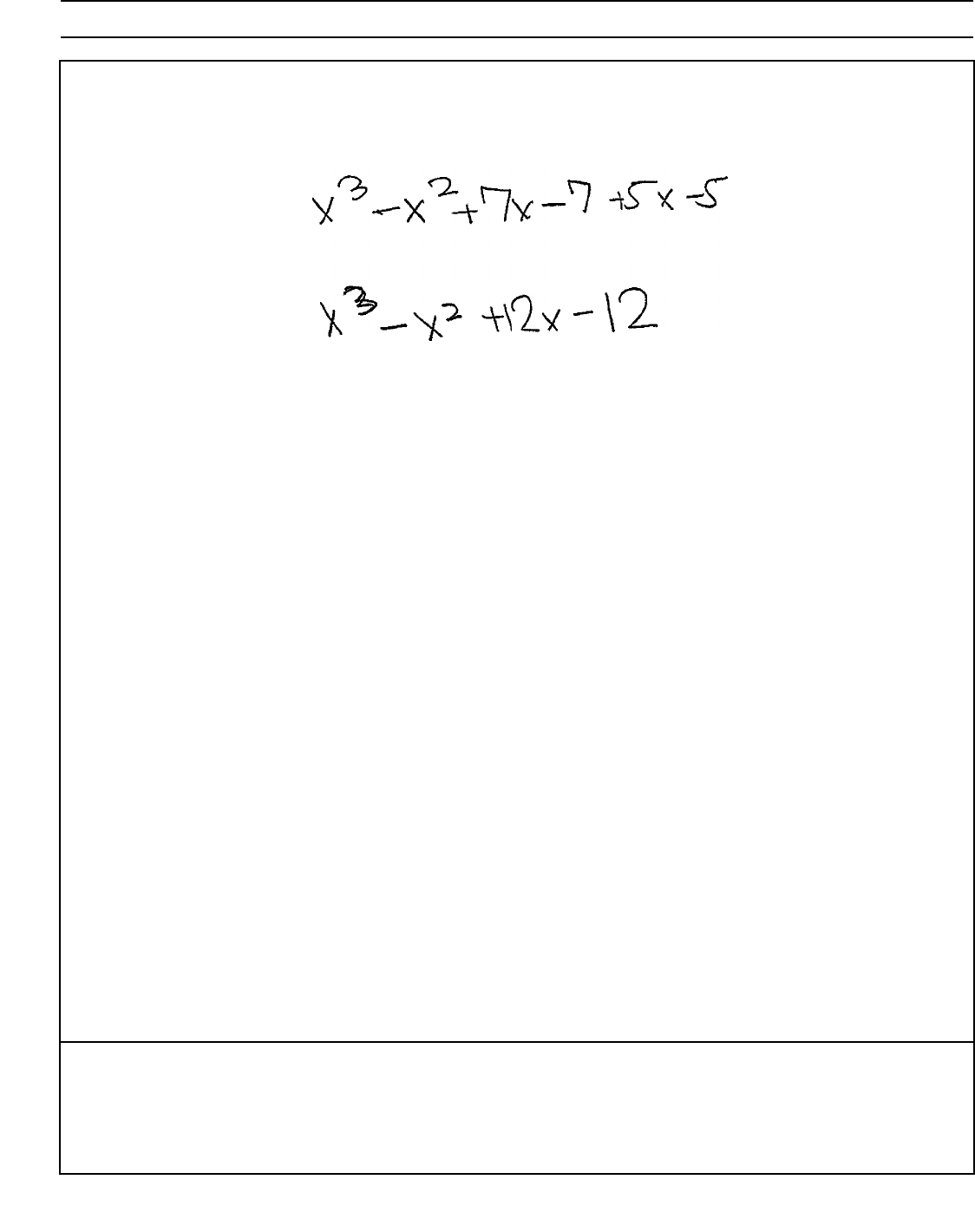
Algebra II – June ’19 [28]
Question 30
Score 1: The student incorrectly distributed the x 1 to the rational term.
30 When the function p(x) is divided by x 1 the quotient is x
2
7
5
_____
x 1
. State p(x) in standard
form.
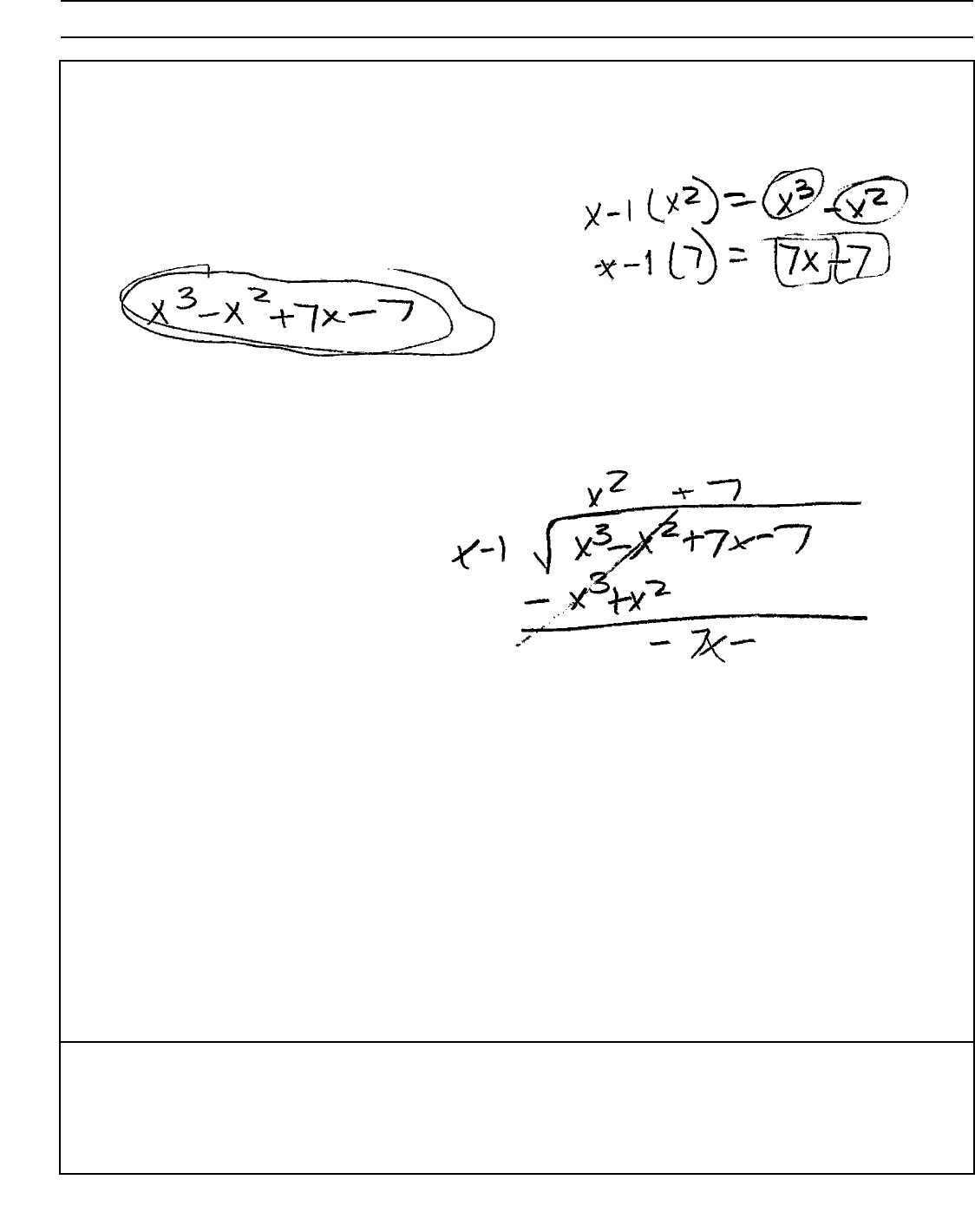
Algebra II – June ’19 [29]
Question 30
Score 1: The student excluded the remainder.
30 When the function p(x) is divided by x 1 the quotient is x
2
7
5
_____
x 1
. State p(x) in standard
form.
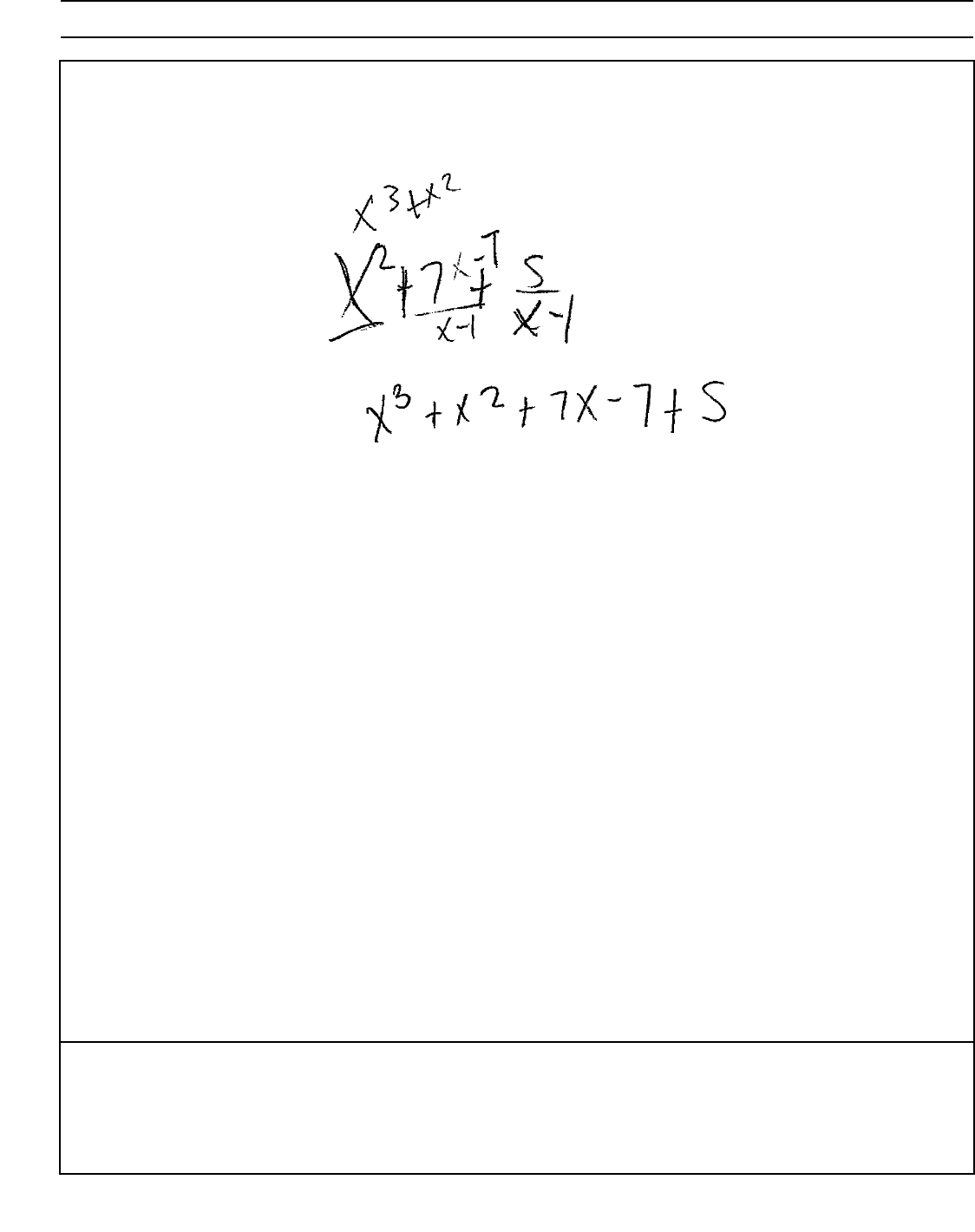
Algebra II – June ’19 [30]
Question 30
Score 0: The student made an error distributing the x
2
and did not state p(x) in standard form.
30 When the function p(x) is divided by x 1 the quotient is x
2
7
5
_____
x 1
. State p(x) in standard
form.
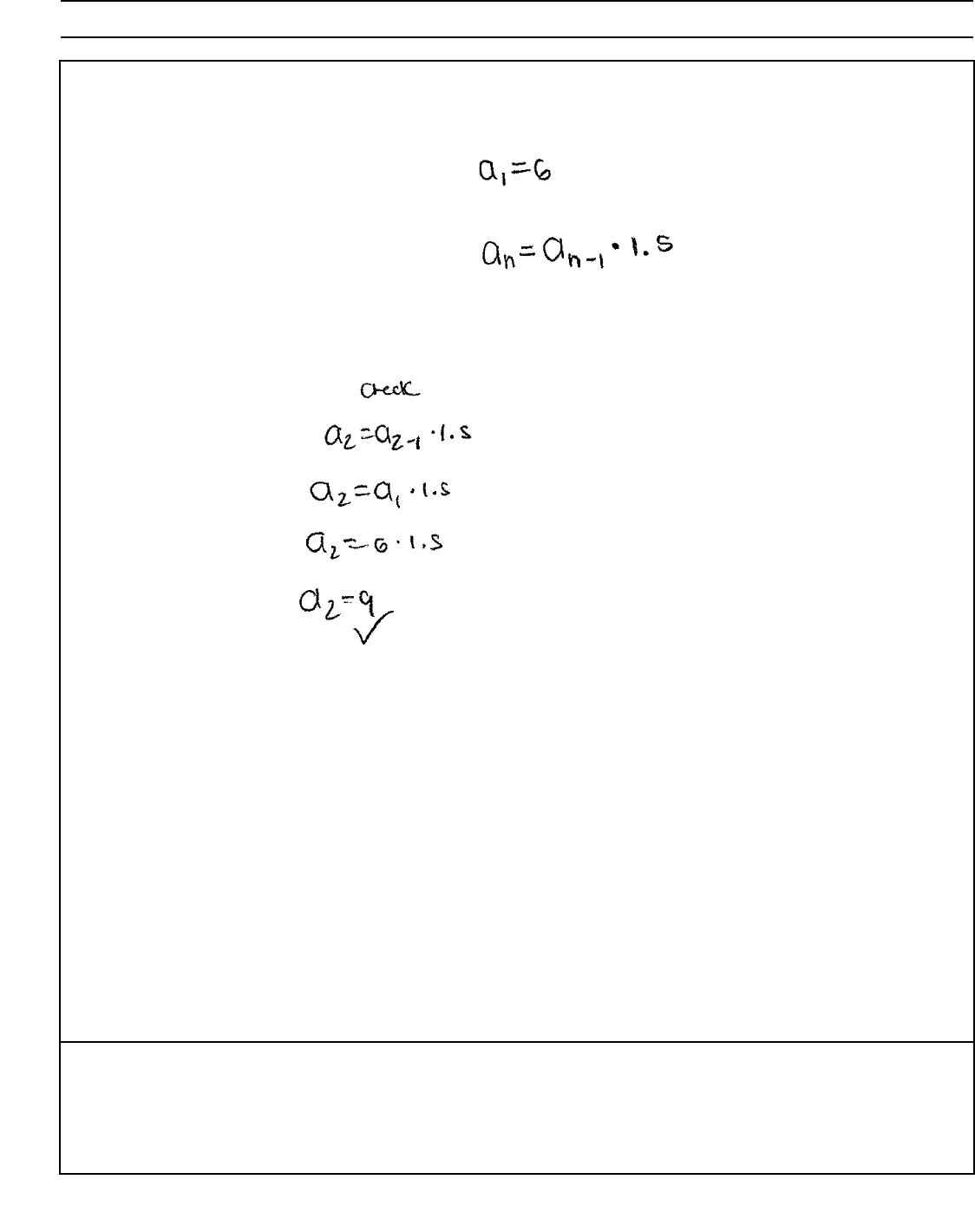
Algebra II – June ’19 [31]
Question 31
Score 2: The student gave a complete and correct response.
31 Write a recursive formula for the sequence 6, 9, 13.5, 20.25, . . .
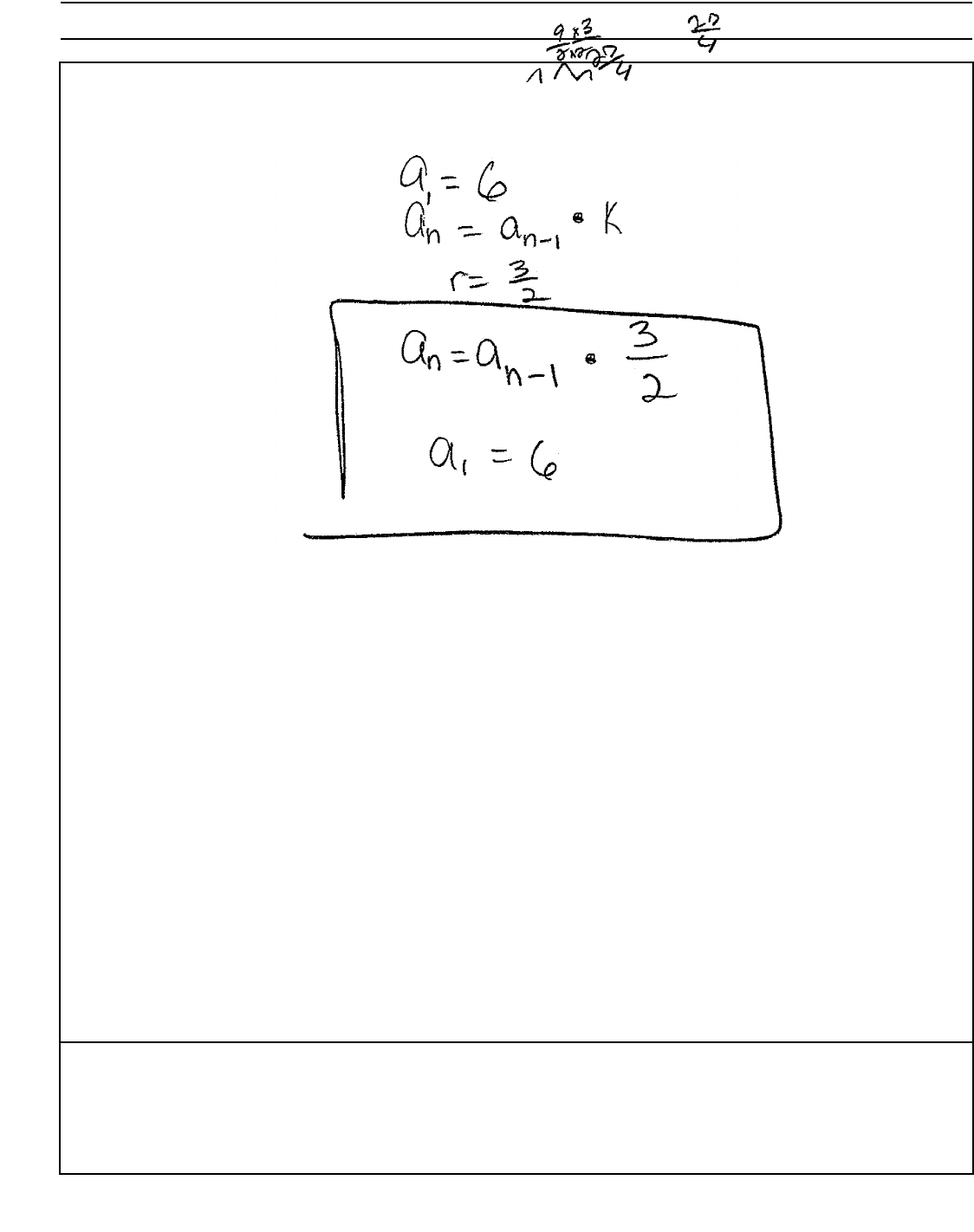
Algebra II – June ’19 [32]
Question 31
Score 2: The student gave a complete and correct response.
31 Write a recursive formula for the sequence 6, 9, 13.5, 20.25, . . .
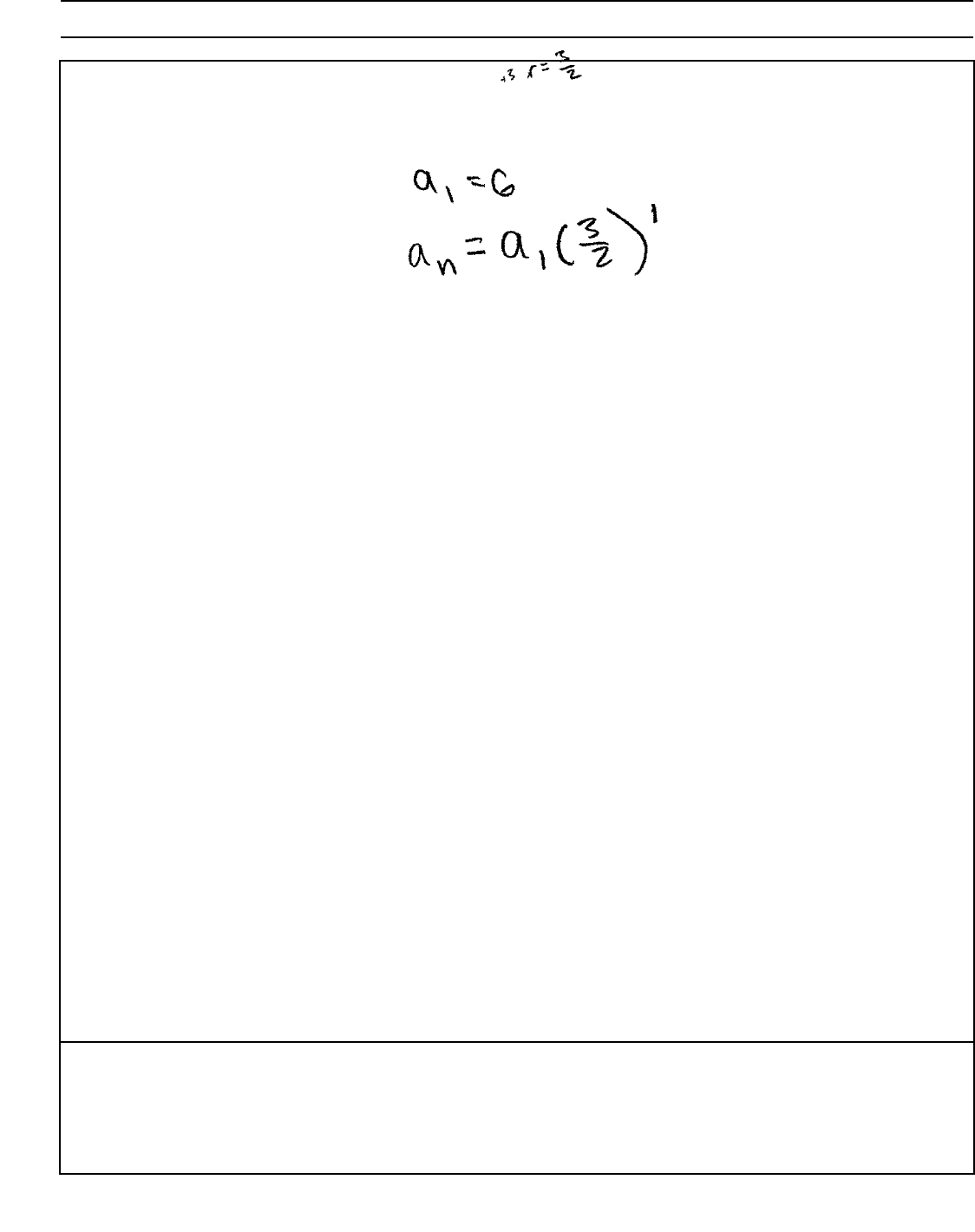
Algebra II – June ’19 [33]
Question 31
Score 1: The student received credit for writing a
1
6.
31 Write a recursive formula for the sequence 6, 9, 13.5, 20.25, . . .
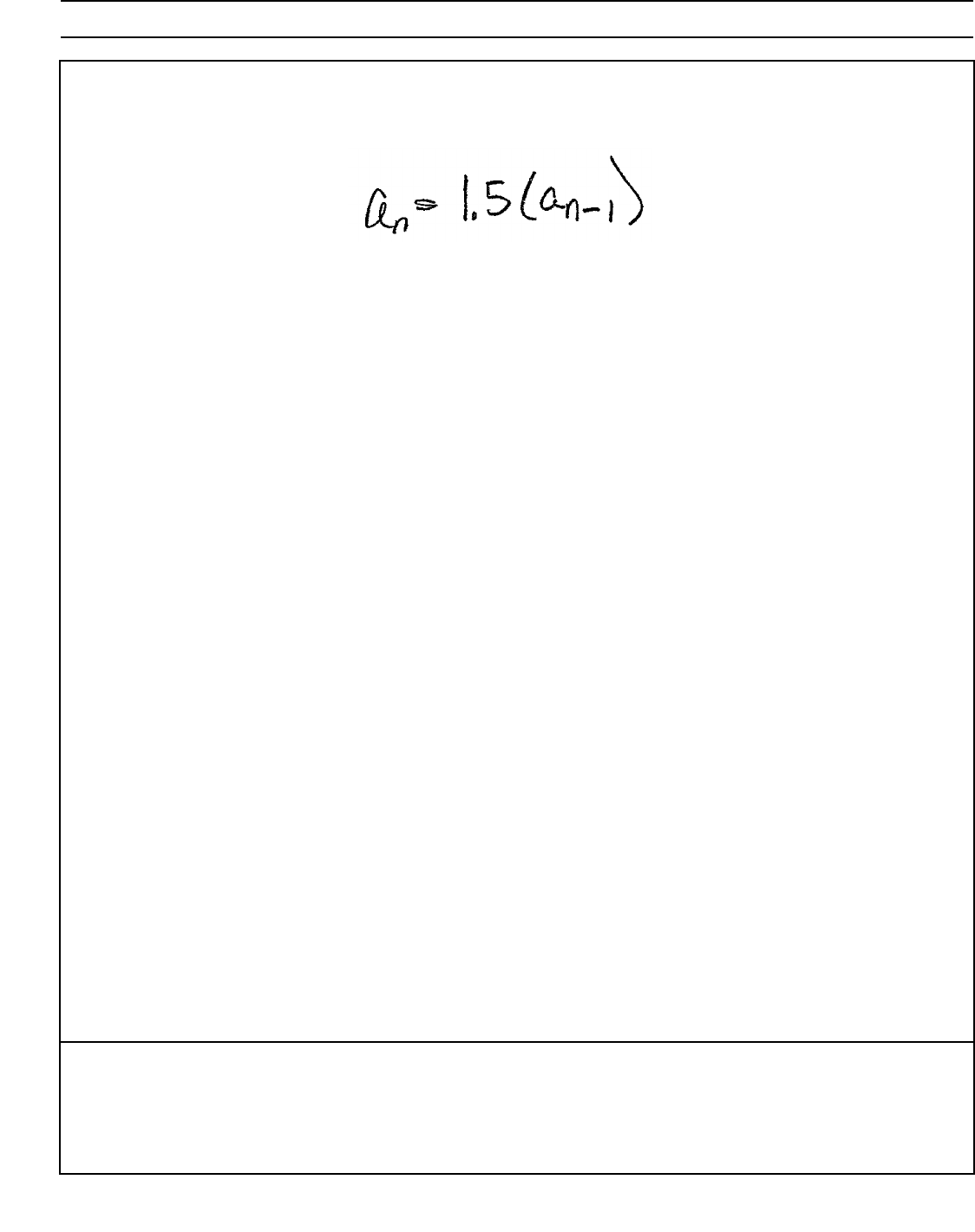
Algebra II – June ’19 [34]
Question 31
Score 1: The student did not write the initial term.
31 Write a recursive formula for the sequence 6, 9, 13.5, 20.25, . . .

Algebra II – June ’19 [35]
Question 31
Score 0: The student did not show enough correct work to receive any credit.
31 Write a recursive formula for the sequence 6, 9, 13.5, 20.25, . . .
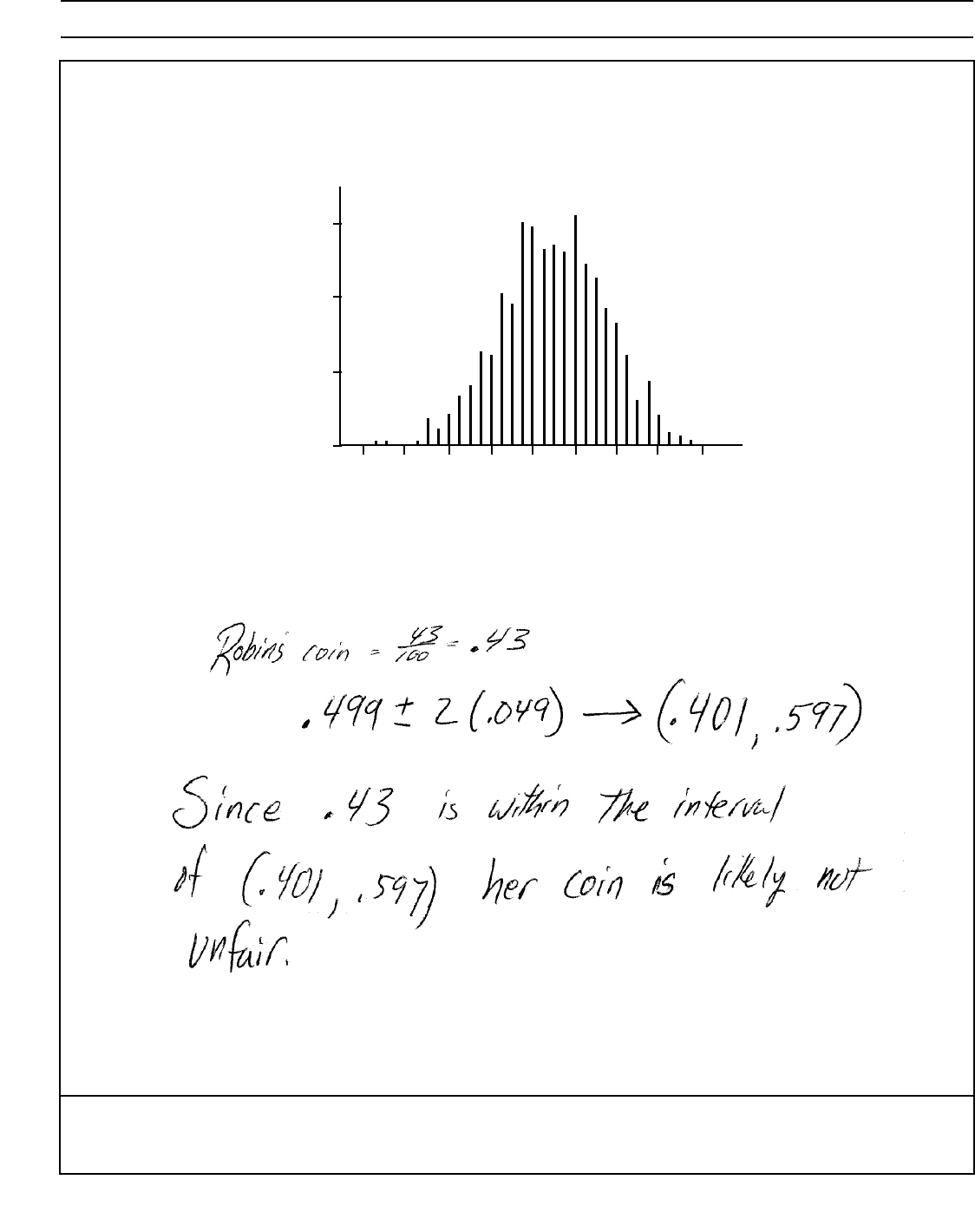
Algebra II – June ’19 [36]
Question 32
Score 2: The student gave a complete and correct response.
Do the results of the simulation provide strong evidence that Robin’s coin is unfair? Explain your
answer.
32 Robin flips a coin 100 times. It lands heads up 43 times, and she wonders if the coin is unfair.
She runs a computer simulation of 750 samples of 100 fair coin flips. The output of the proportion
of heads is shown below.
Mean 0.499
SD 0.049
0
20
40
60
0.32
0.36 0.40 0.44 0.48 0.52 0.56 0.60 0.64
Proportion of Heads
Frequency
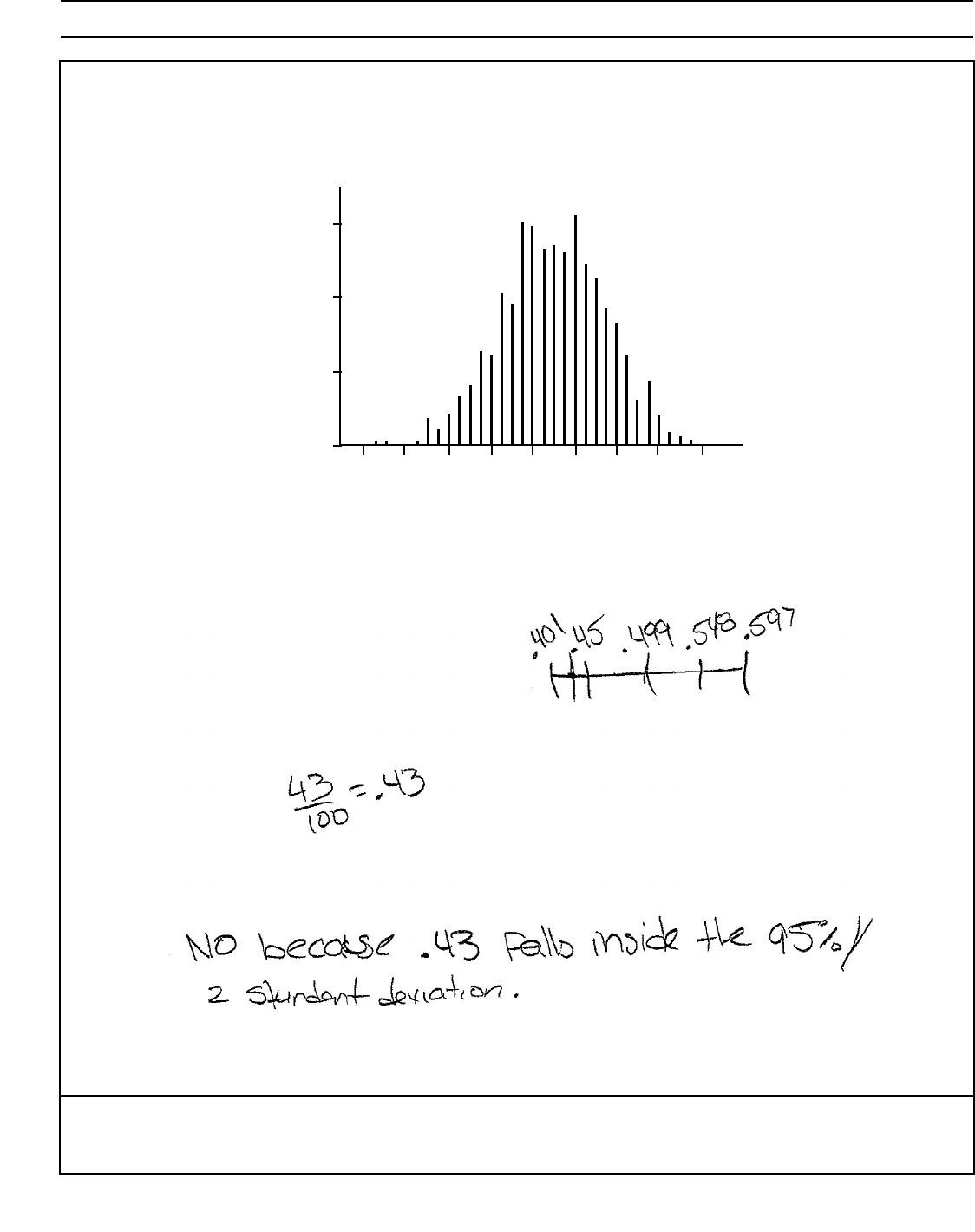
Algebra II – June ’19 [37]
Question 32
Score 2: The student gave a complete and correct response.
Do the results of the simulation provide strong evidence that Robin’s coin is unfair? Explain your
answer.
32 Robin flips a coin 100 times. It lands heads up 43 times, and she wonders if the coin is unfair.
She runs a computer simulation of 750 samples of 100 fair coin flips. The output of the proportion
of heads is shown below.
Mean 0.499
SD 0.049
0
20
40
60
0.32
0.36 0.40 0.44 0.48 0.52 0.56 0.60 0.64
Proportion of Heads
Frequency
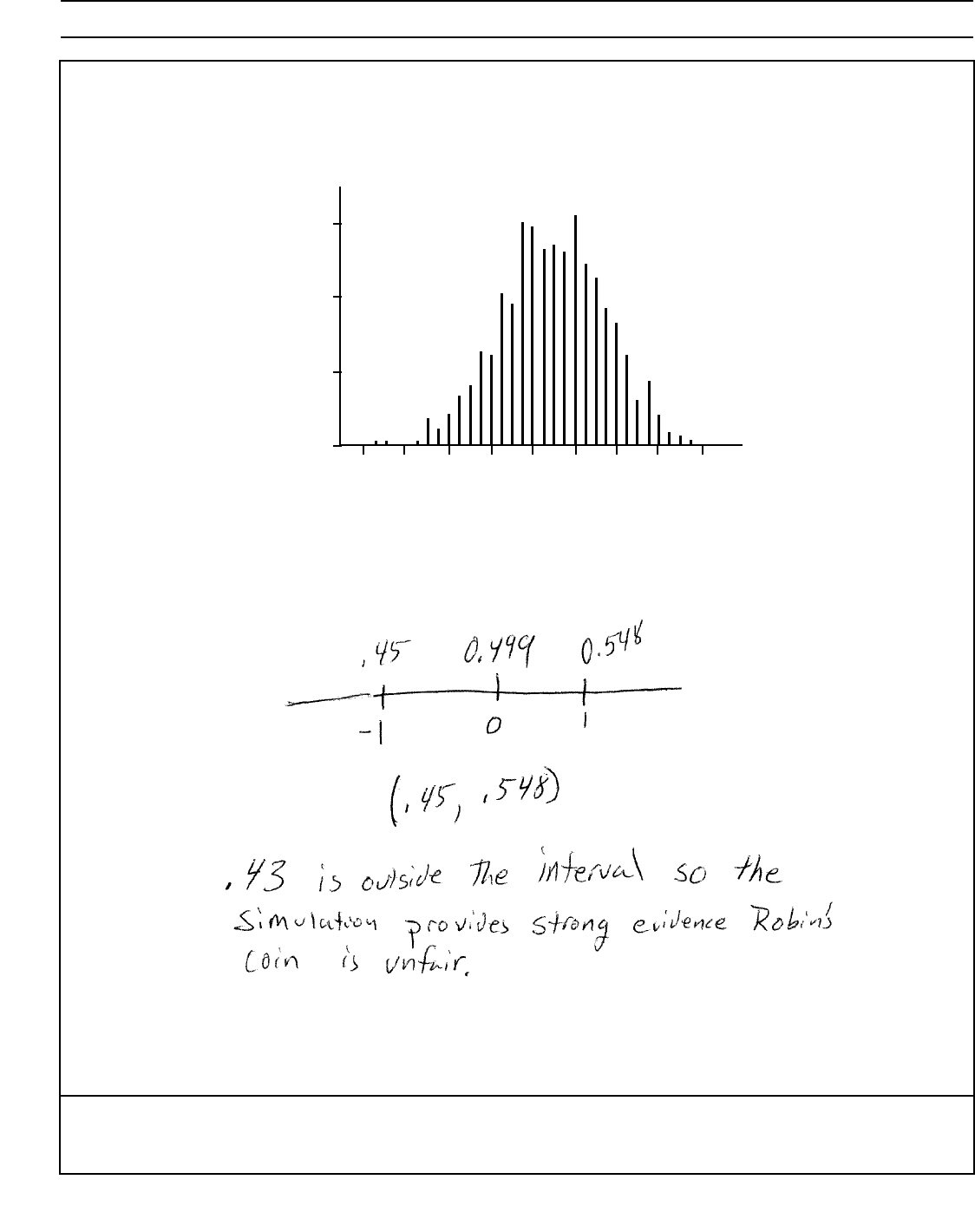
Algebra II – June ’19 [38]
Question 32
Score 1: The student gave a correct explanation based on an inappropriate interval.
Do the results of the simulation provide strong evidence that Robin’s coin is unfair? Explain your
answer.
32 Robin flips a coin 100 times. It lands heads up 43 times, and she wonders if the coin is unfair.
She runs a computer simulation of 750 samples of 100 fair coin flips. The output of the proportion
of heads is shown below.
Mean 0.499
SD 0.049
0
20
40
60
0.32
0.36 0.40 0.44 0.48 0.52 0.56 0.60 0.64
Proportion of Heads
Frequency

Algebra II – June ’19 [39]
Question 32
Score 1: The student gave an explanation, but provided no statistical evidence.
Do the results of the simulation provide strong evidence that Robin’s coin is unfair? Explain your
answer.
32 Robin flips a coin 100 times. It lands heads up 43 times, and she wonders if the coin is unfair.
She runs a computer simulation of 750 samples of 100 fair coin flips. The output of the proportion
of heads is shown below.
Mean 0.499
SD 0.049
0
20
40
60
0.32
0.36 0.40 0.44 0.48 0.52 0.56 0.60 0.64
Proportion of Heads
Frequency
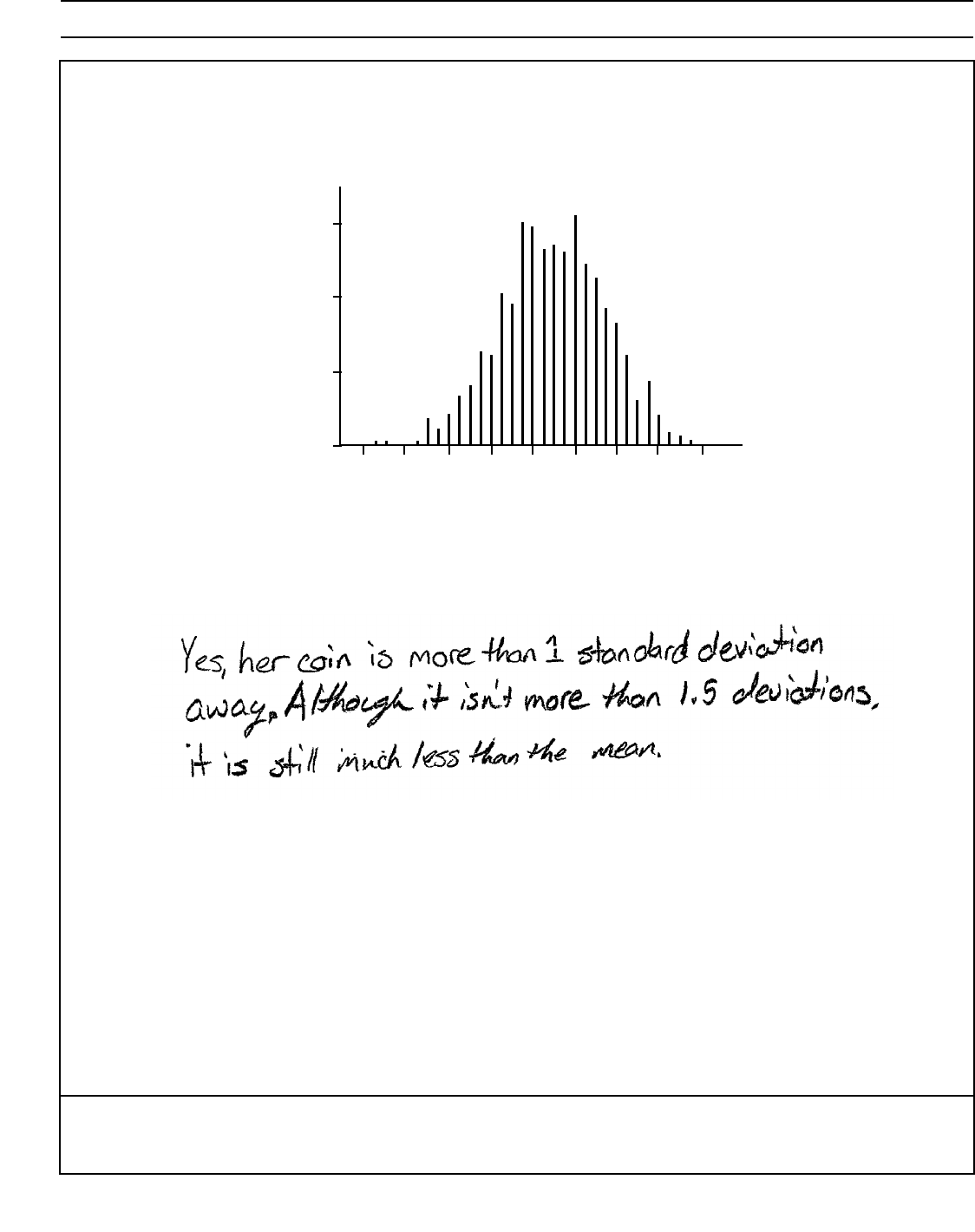
Algebra II – June ’19 [40]
Question 32
Score 0: The student did not show enough correct statistical evidence to receive any credit.
Do the results of the simulation provide strong evidence that Robin’s coin is unfair? Explain your
answer.
32 Robin flips a coin 100 times. It lands heads up 43 times, and she wonders if the coin is unfair.
She runs a computer simulation of 750 samples of 100 fair coin flips. The output of the proportion
of heads is shown below.
Mean 0.499
SD 0.049
0
20
40
60
0.32
0.36 0.40 0.44 0.48 0.52 0.56 0.60 0.64
Proportion of Heads
Frequency
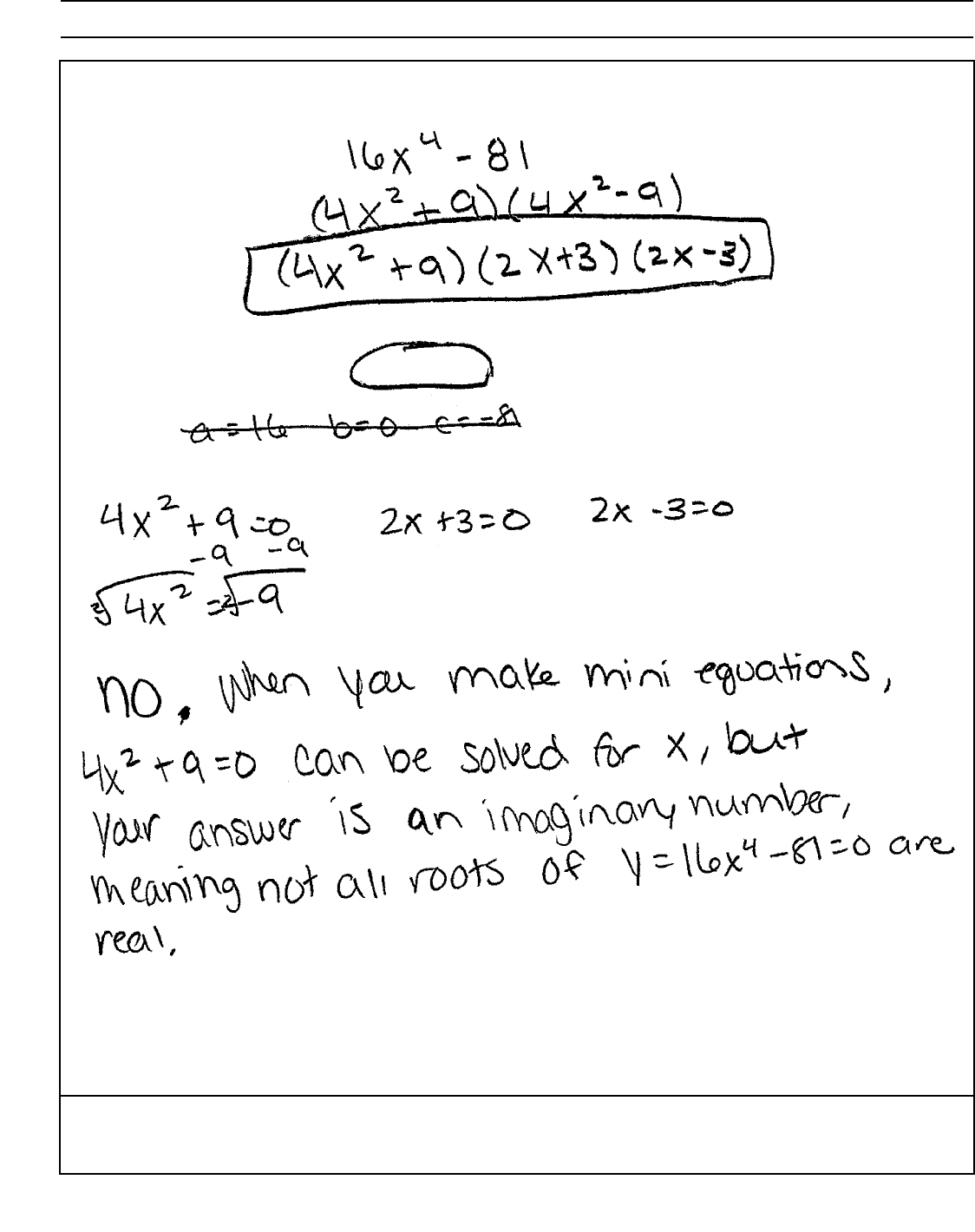
Algebra II – June ’19 [41]
Question 33
Score 4: The student gave a complete and correct response.
Sara graphed the polynomial y 16x
4
81 and stated “All the roots of y 16x
4
81 are real.”
Is Sara correct? Explain your reasoning.
33 Factor completely over the set of integers: 16x
4
81
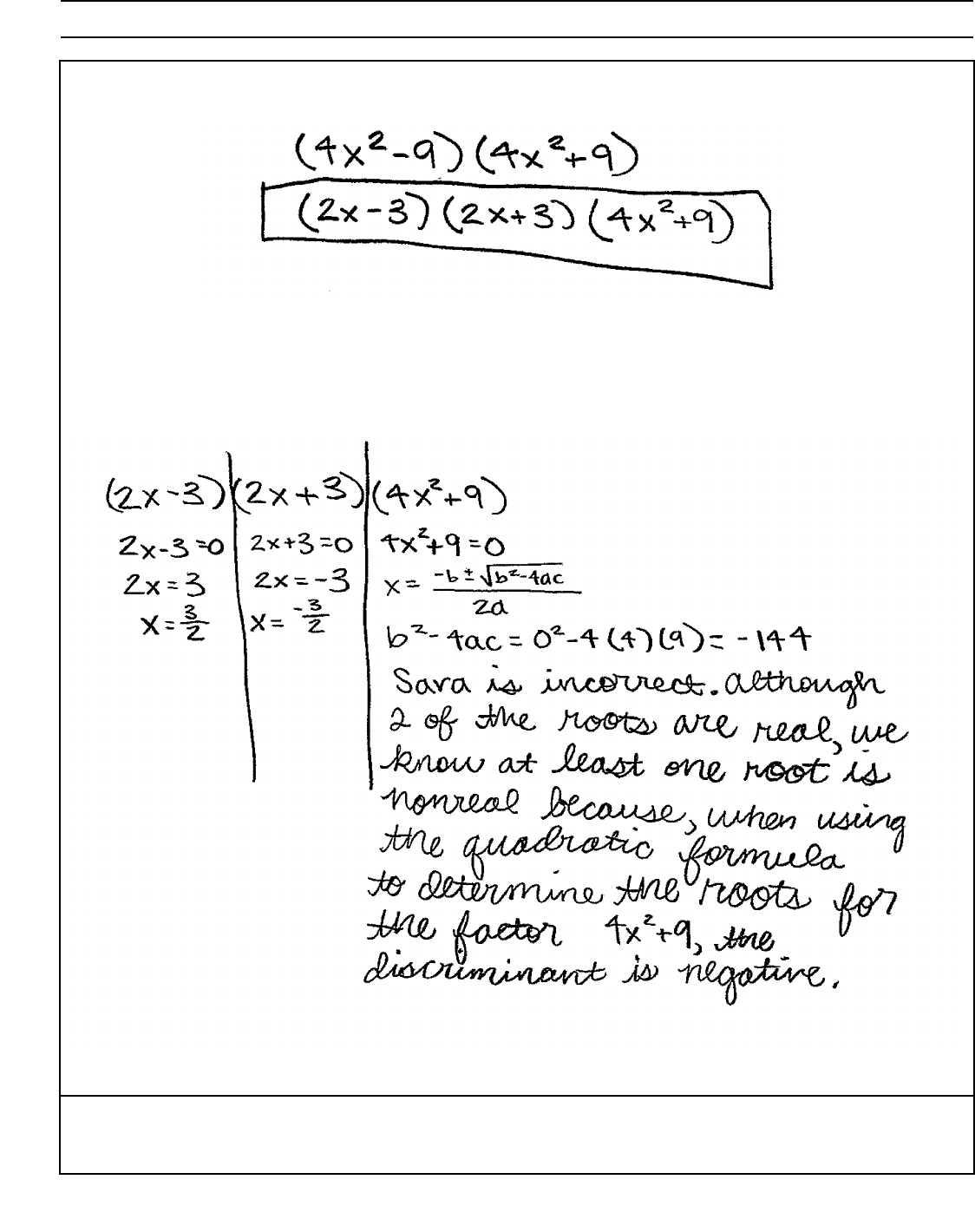
Algebra II – June ’19 [42]
Question 33
Score 4: The student gave a complete and correct response.
Sara graphed the polynomial y 16x
4
81 and stated “All the roots of y 16x
4
81 are real.”
Is Sara correct? Explain your reasoning.
33 Factor completely over the set of integers: 16x
4
81
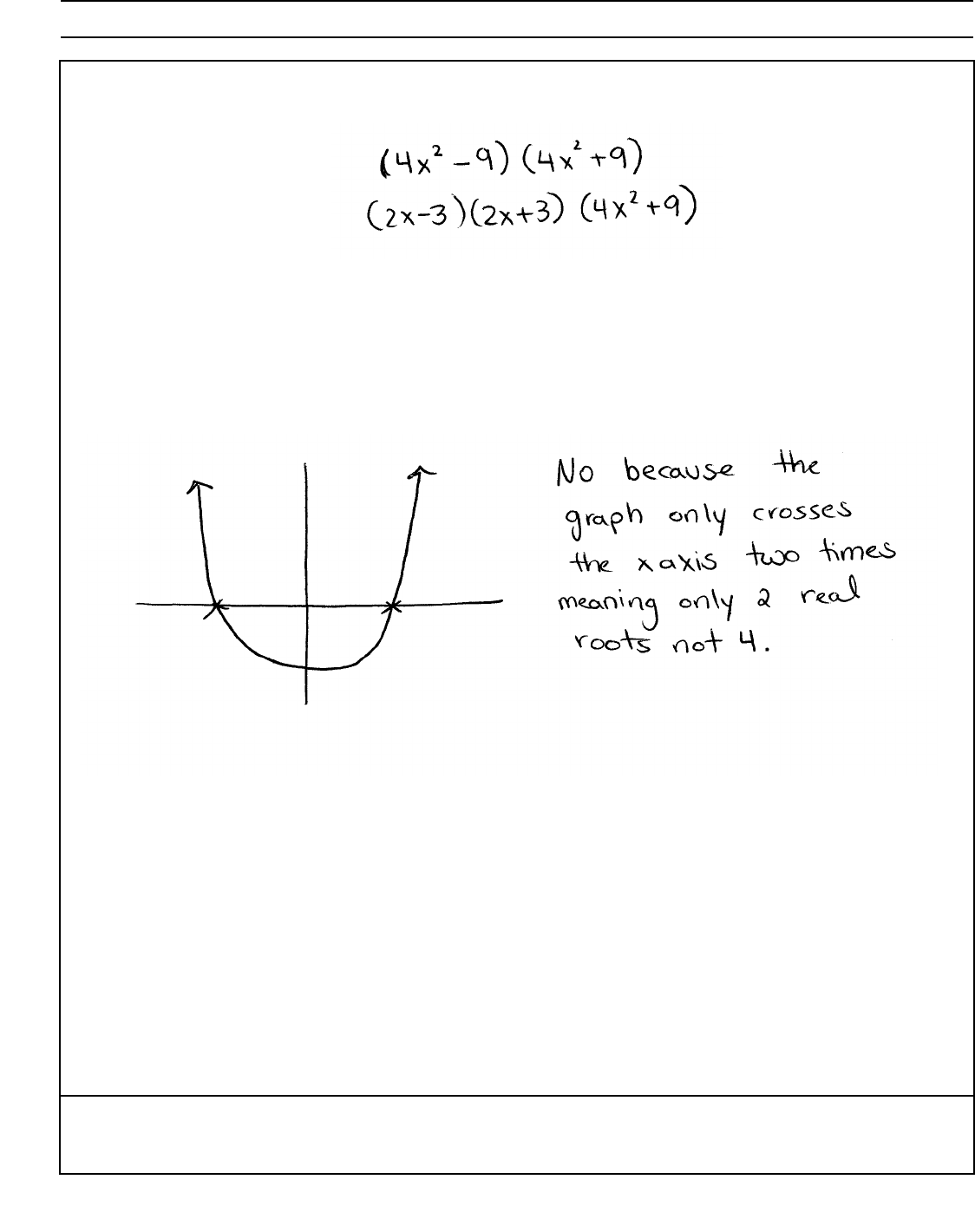
Algebra II – June ’19 [43]
Question 33
Score 4: The student gave a complete and correct response.
Sara graphed the polynomial y 16x
4
81 and stated “All the roots of y 16x
4
81 are real.”
Is Sara correct? Explain your reasoning.
33 Factor completely over the set of integers: 16x
4
81
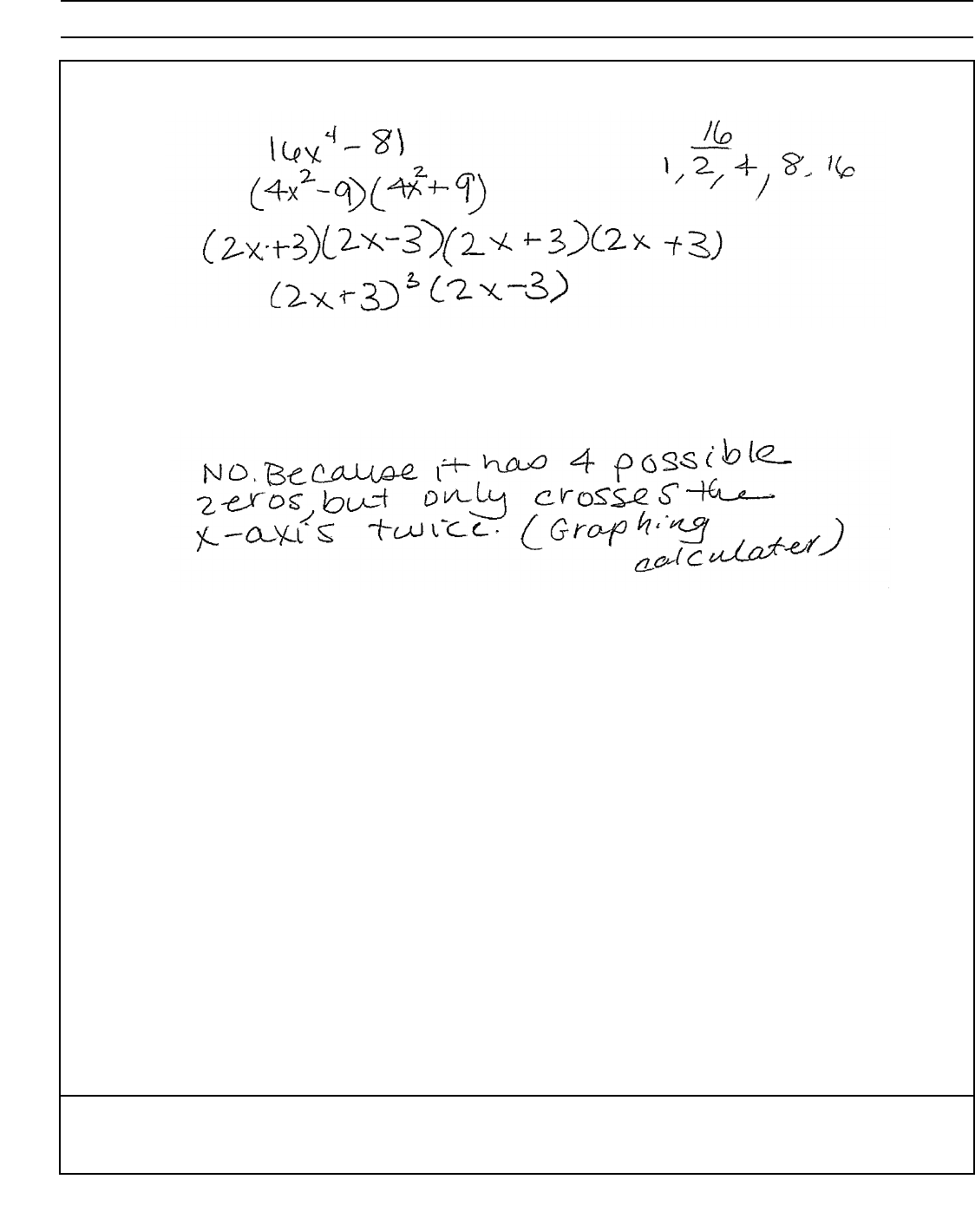
Algebra II – June ’19 [44]
Question 33
Score 3: The student made one factoring error.
Sara graphed the polynomial y 16x
4
81 and stated “All the roots of y 16x
4
81 are real.”
Is Sara correct? Explain your reasoning.
33 Factor completely over the set of integers: 16x
4
81
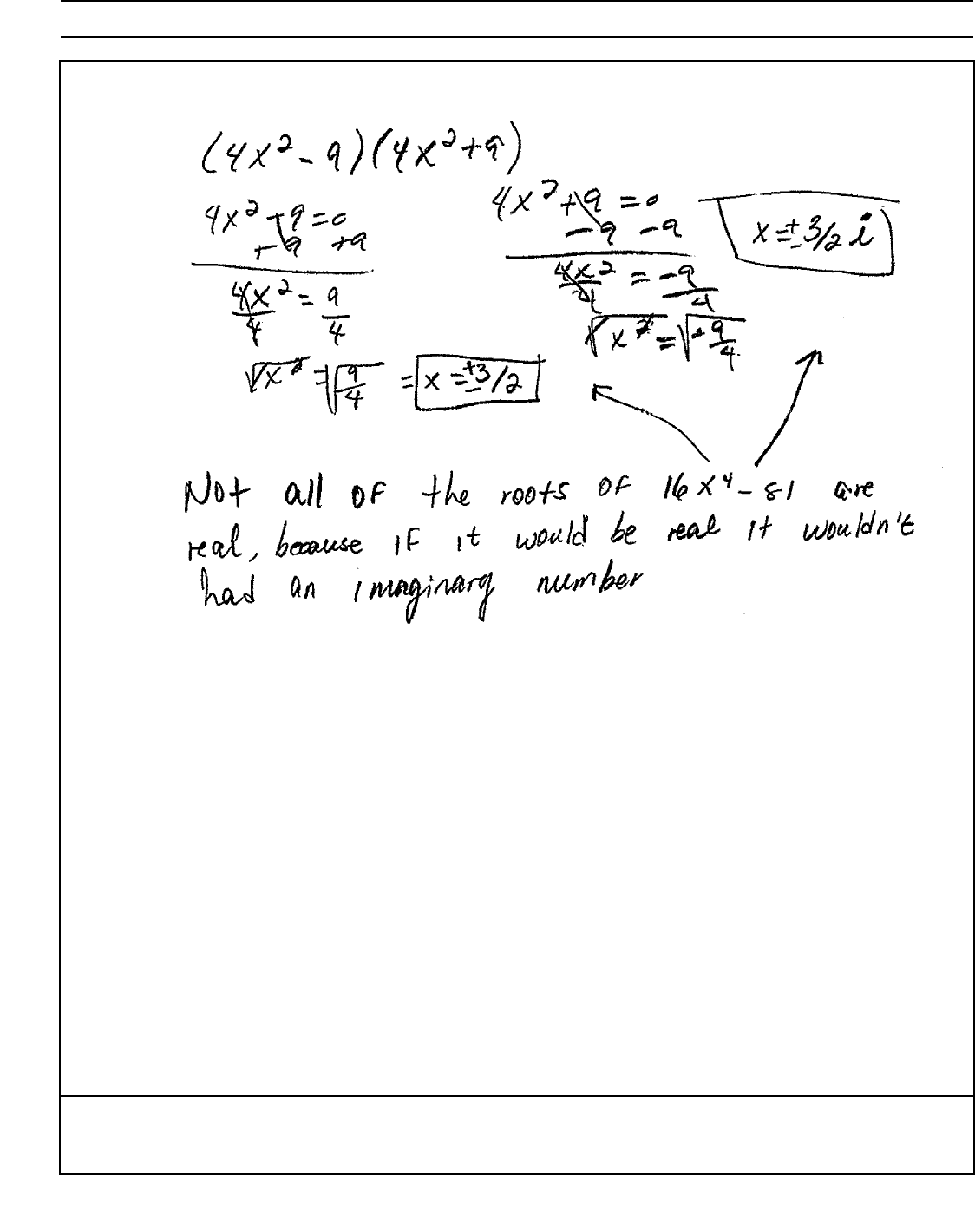
Algebra II – June ’19 [45]
Question 33
Score 3: The student did not factor completely.
Sara graphed the polynomial y 16x
4
81 and stated “All the roots of y 16x
4
81 are real.”
Is Sara correct? Explain your reasoning.
33 Factor completely over the set of integers: 16x
4
81

Algebra II – June ’19 [46]
Question 33
Score 3: The student did not factor over the set of integers.
Sara graphed the polynomial y 16x
4
81 and stated “All the roots of y 16x
4
81 are real.”
Is Sara correct? Explain your reasoning.
33 Factor completely over the set of integers: 16x
4
81
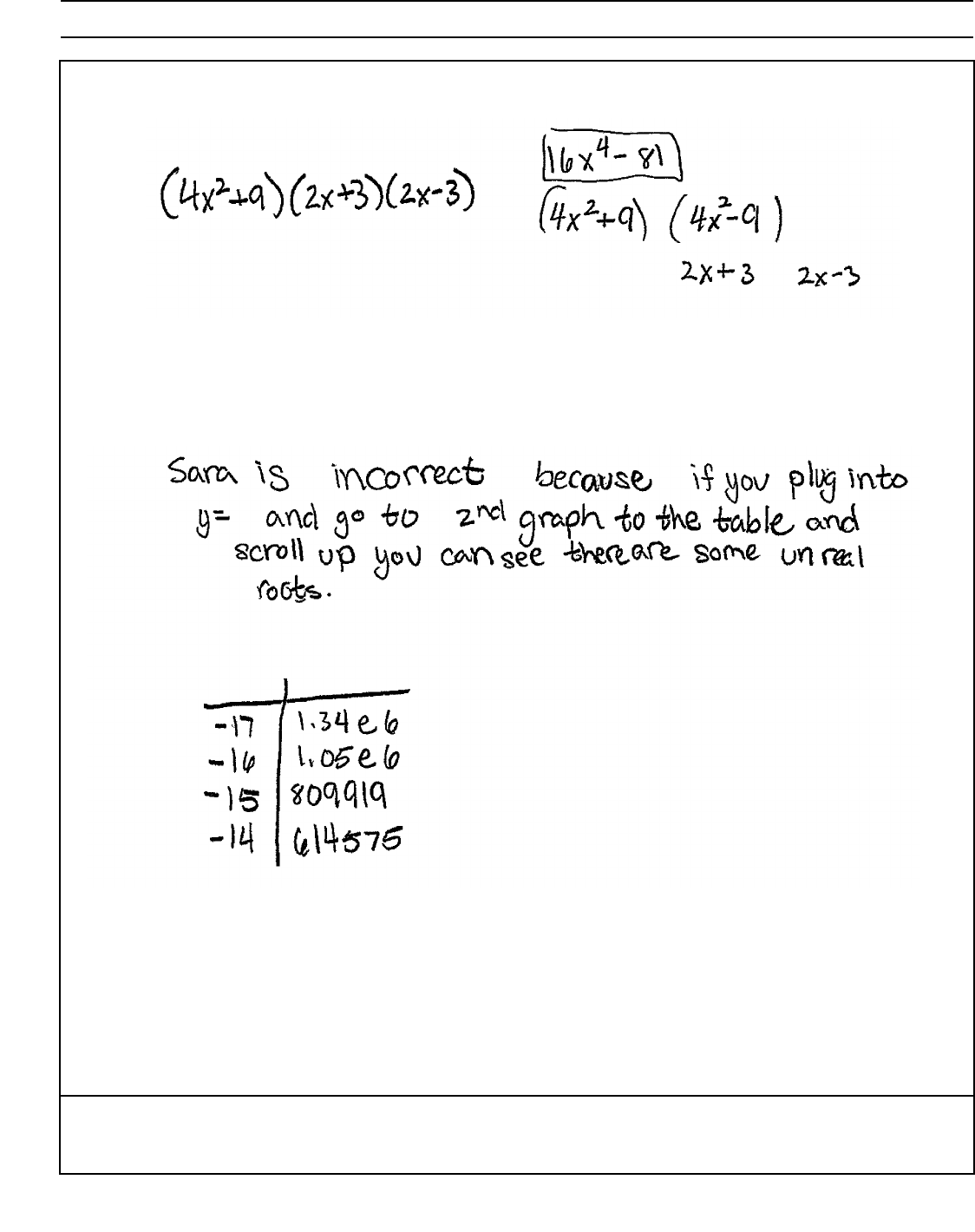
Algebra II – June ’19 [47]
Question 33
Score 2: The student only received credit for factoring completely.
Sara graphed the polynomial y 16x
4
81 and stated “All the roots of y 16x
4
81 are real.”
Is Sara correct? Explain your reasoning.
33 Factor completely over the set of integers: 16x
4
81
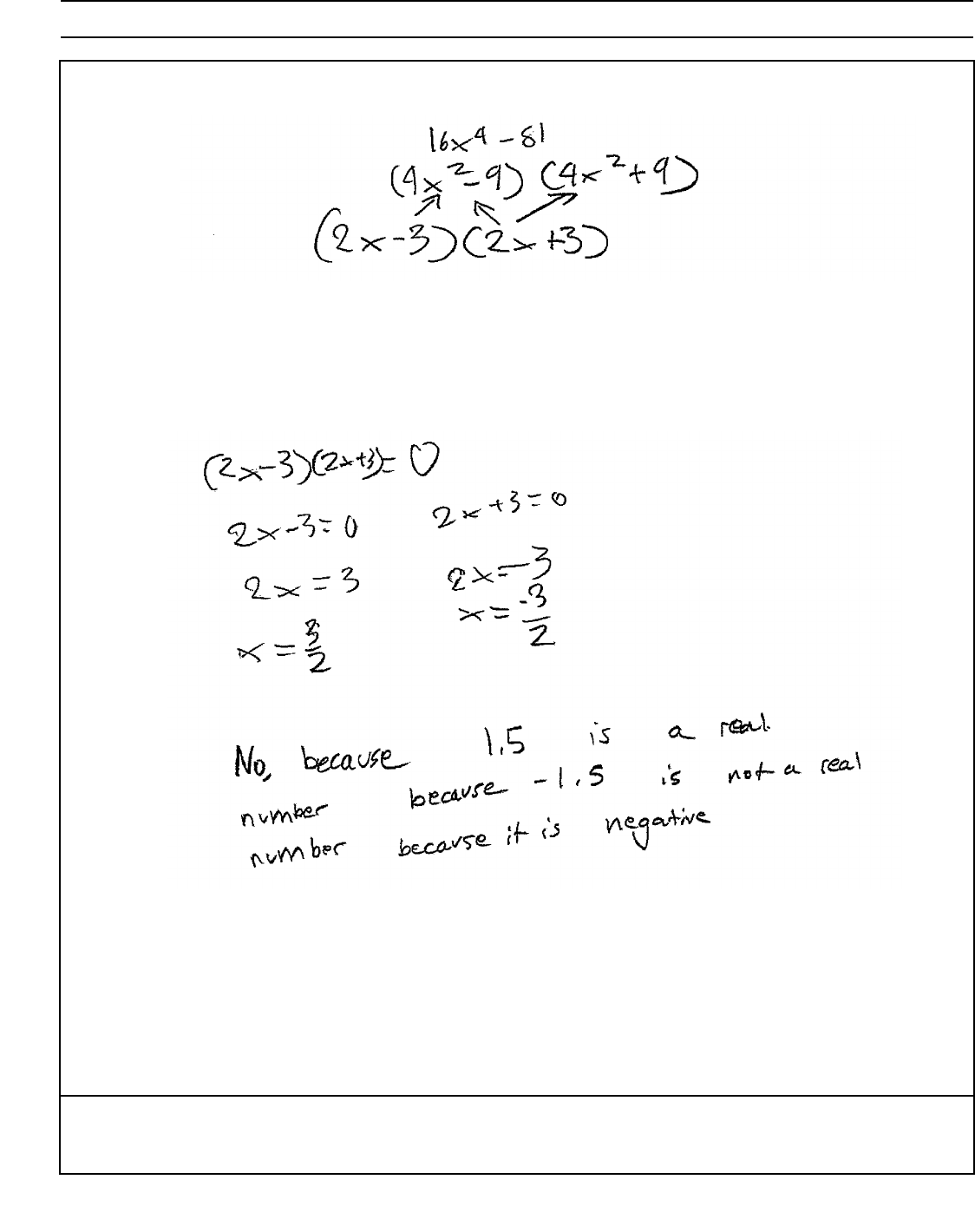
Algebra II – June ’19 [48]
Question 33
Score 1: The student made one factoring error and gave an incorrect explanation.
Sara graphed the polynomial y 16x
4
81 and stated “All the roots of y 16x
4
81 are real.”
Is Sara correct? Explain your reasoning.
33 Factor completely over the set of integers: 16x
4
81
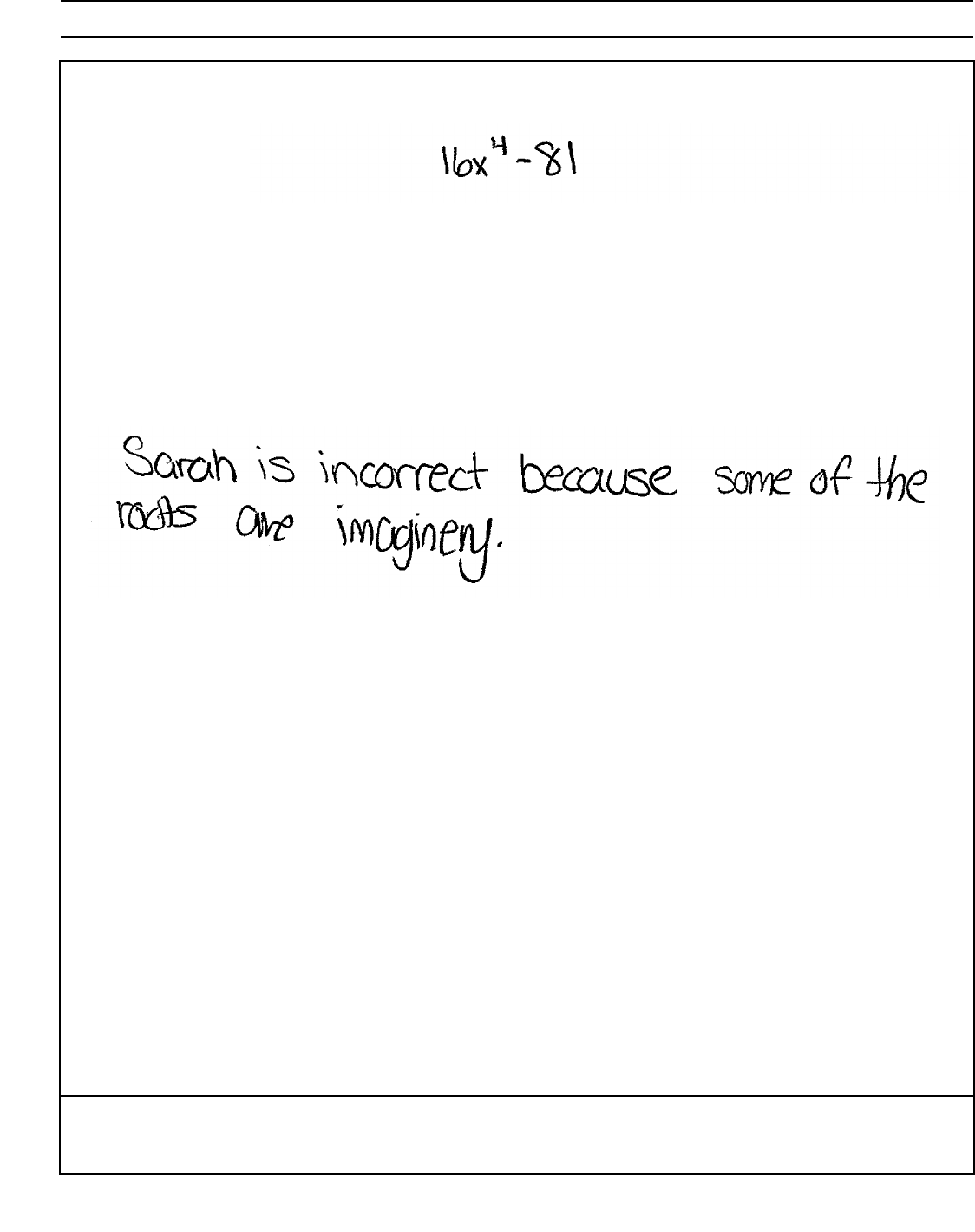
Algebra II – June ’19 [49]
Question 33
Score 0: The student’s explanation was not sufficient to receive any credit.
Sara graphed the polynomial y 16x
4
81 and stated “All the roots of y 16x
4
81 are real.”
Is Sara correct? Explain your reasoning.
33 Factor completely over the set of integers: 16x
4
81
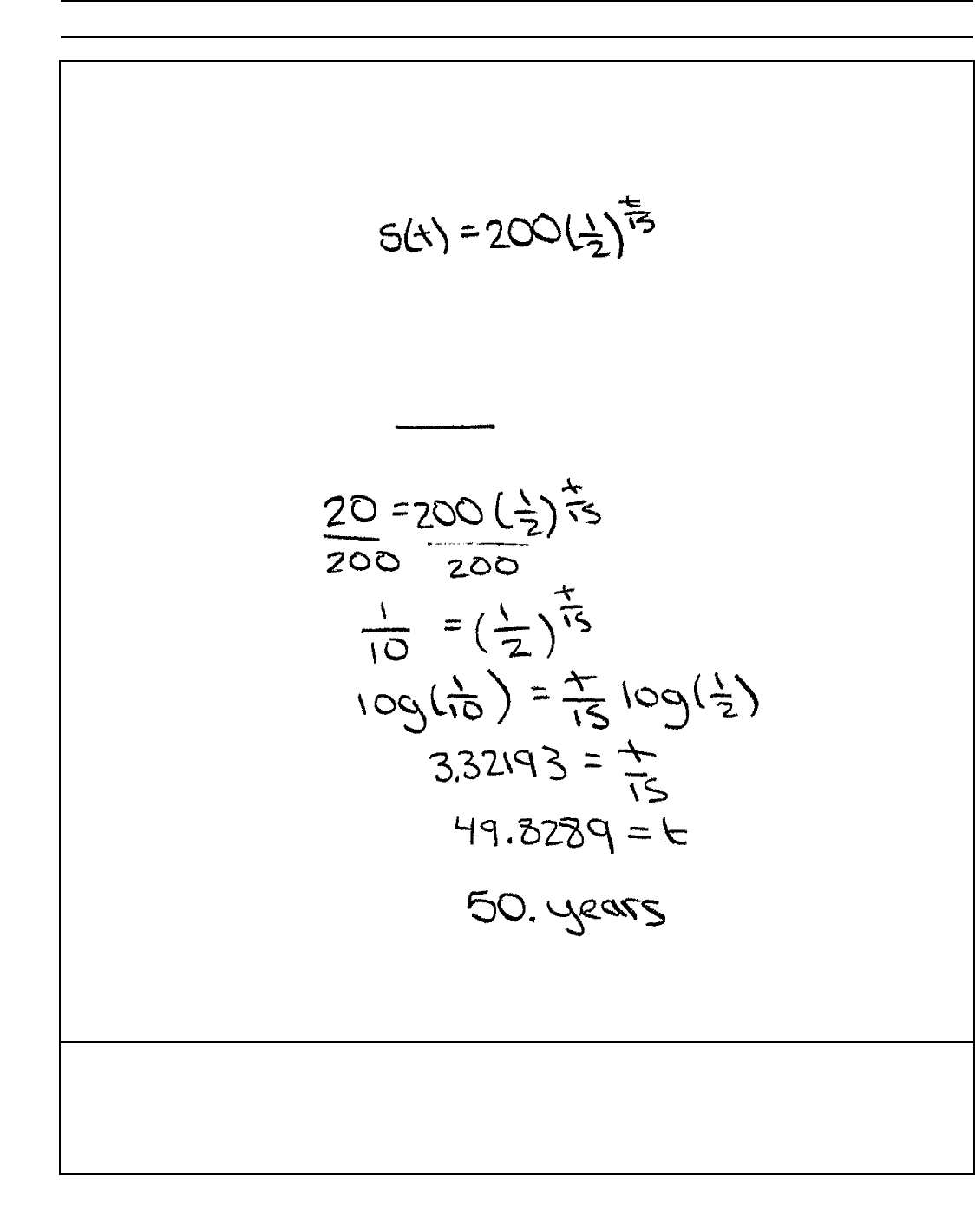
Algebra II – June ’19 [50]
Question 34
Score 4: The student gave a complete and correct response.
34 The half-life of a radioactive substance is 15 years.
Write an equation that can be used to determine the amount, s(t), of 200 grams of this substance
that remains after t years.
Determine algebraically, to the nearest year, how long it will take for
1
__
10
of this substance to
remain.
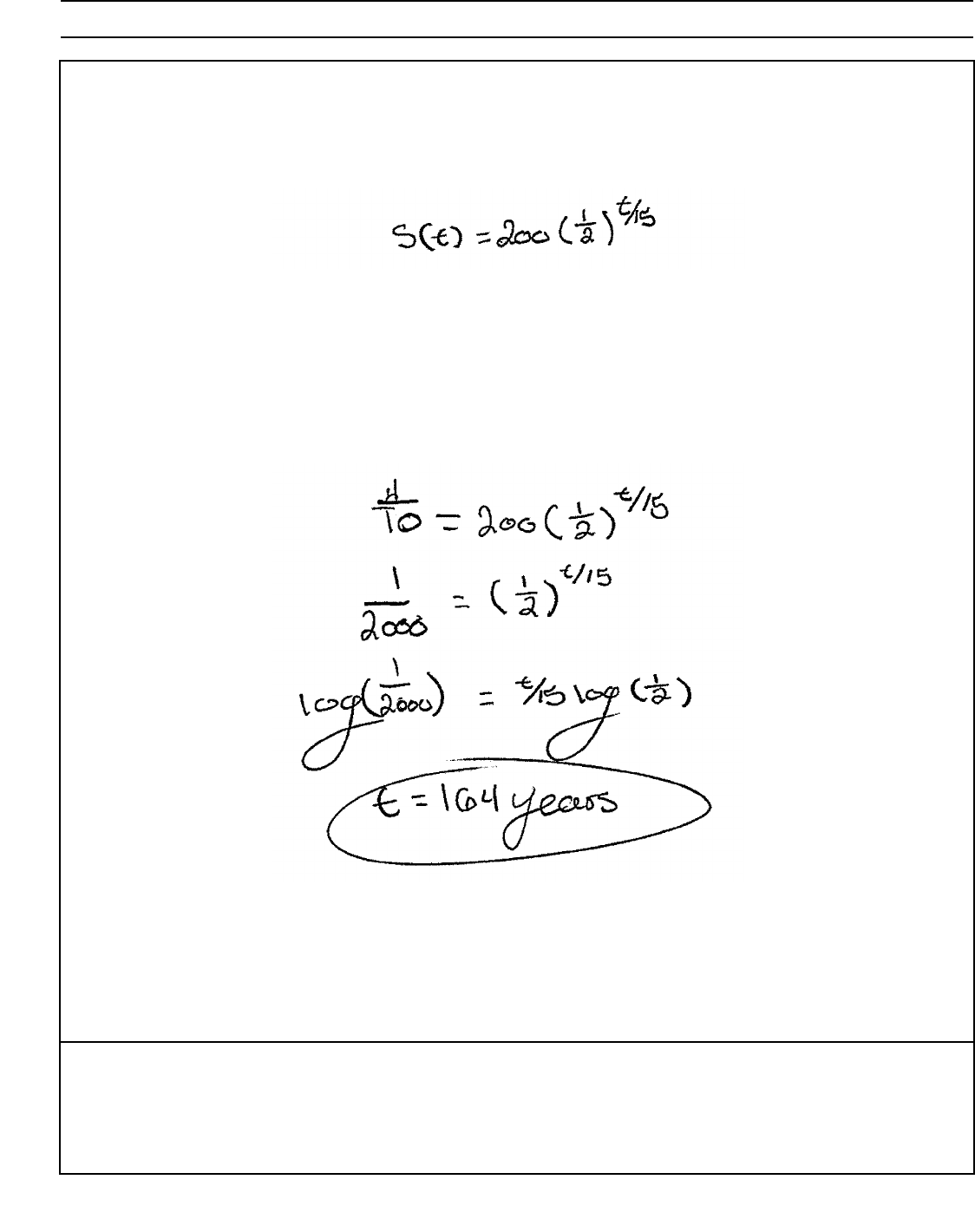
Algebra II – June ’19 [51]
Question 34
Score 3: The student made an error assuming that
1
__
10
of a gram of the substance remained.
34 The half-life of a radioactive substance is 15 years.
Write an equation that can be used to determine the amount, s(t), of 200 grams of this substance
that remains after t years.
Determine algebraically, to the nearest year, how long it will take for
1
__
10
of this substance to
remain.
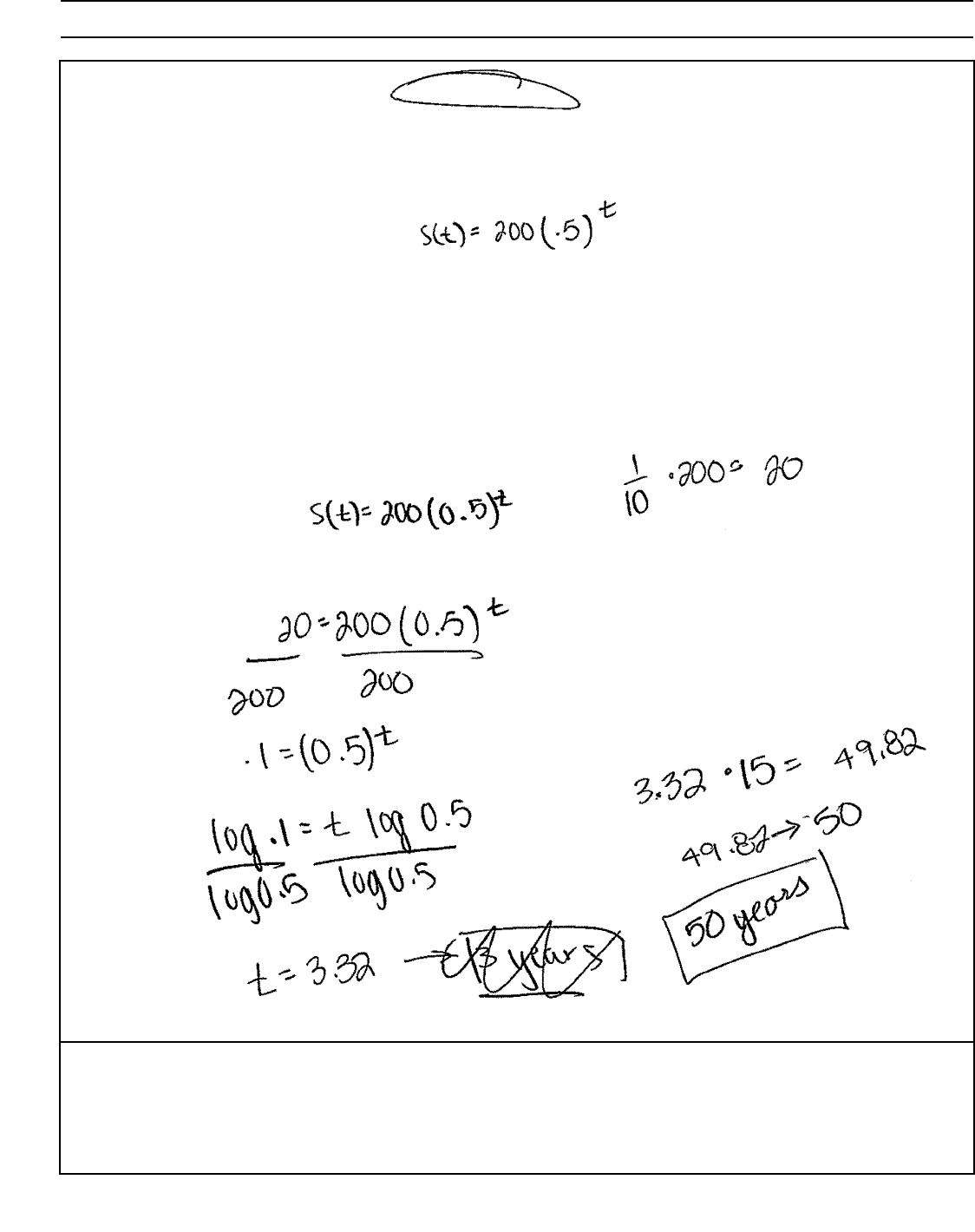
Algebra II – June ’19 [52]
Question 34
Score 3: The student made an error writing the equation for s(t), assuming t was the number of
half-lives.
34 The half-life of a radioactive substance is 15 years.
Write an equation that can be used to determine the amount, s(t), of 200 grams of this substance
that remains after t years.
Determine algebraically, to the nearest year, how long it will take for
1
__
10
of this substance to
remain.
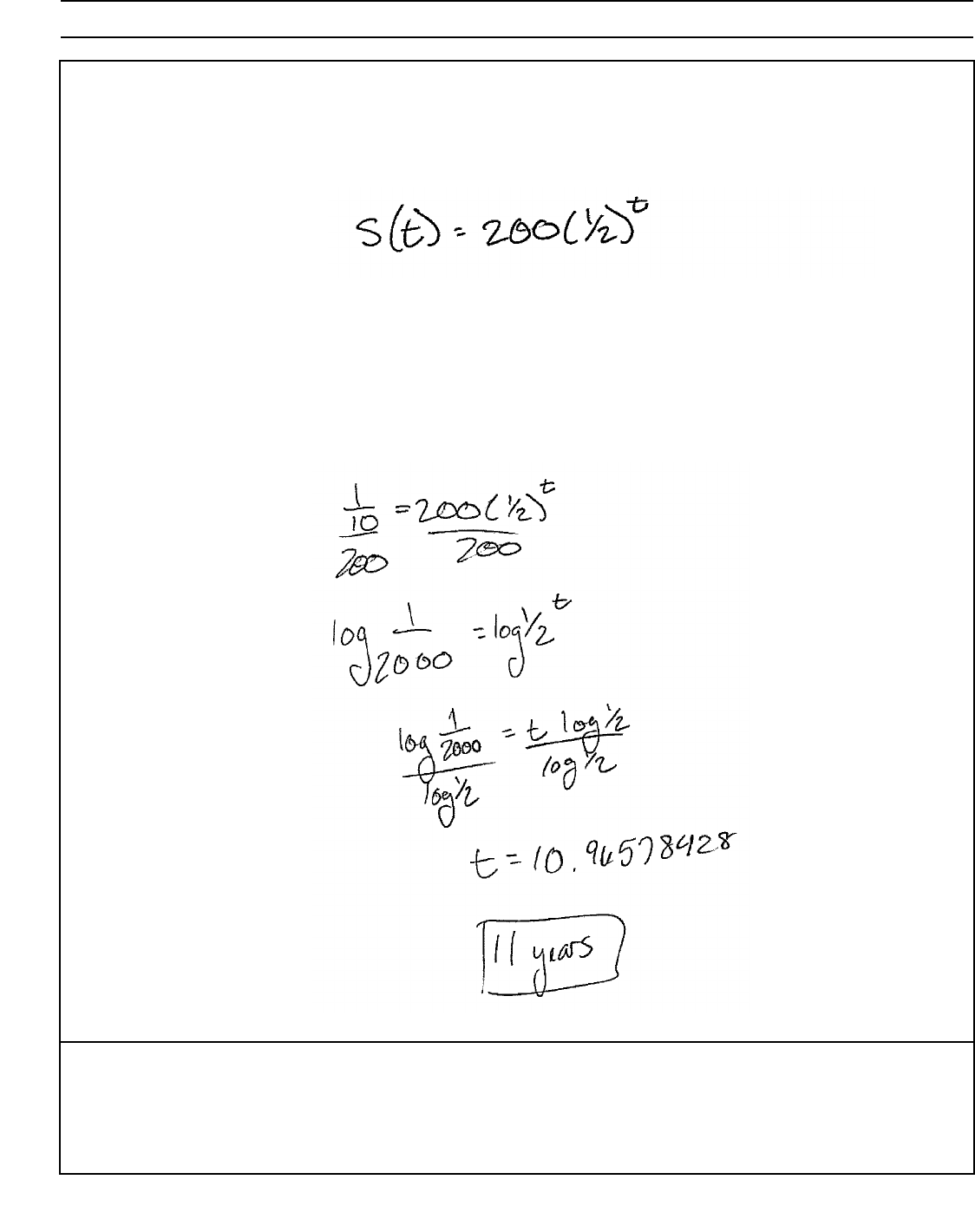
Algebra II – June ’19 [53]
Question 34
Score 2: The student wrote an incorrect equation and made an error assuming
1
__
10
of a gram of
the substance remained.
34 The half-life of a radioactive substance is 15 years.
Write an equation that can be used to determine the amount, s(t), of 200 grams of this substance
that remains after t years.
Determine algebraically, to the nearest year, how long it will take for
1
__
10
of this substance to
remain.

Algebra II – June ’19 [54]
Question 34
Score 1: The student received no credit for the first part and showed incomplete algebraic work
on the second part.
34 The half-life of a radioactive substance is 15 years.
Write an equation that can be used to determine the amount, s(t), of 200 grams of this substance
that remains after t years.
Determine algebraically, to the nearest year, how long it will take for
1
__
10
of this substance to
remain.
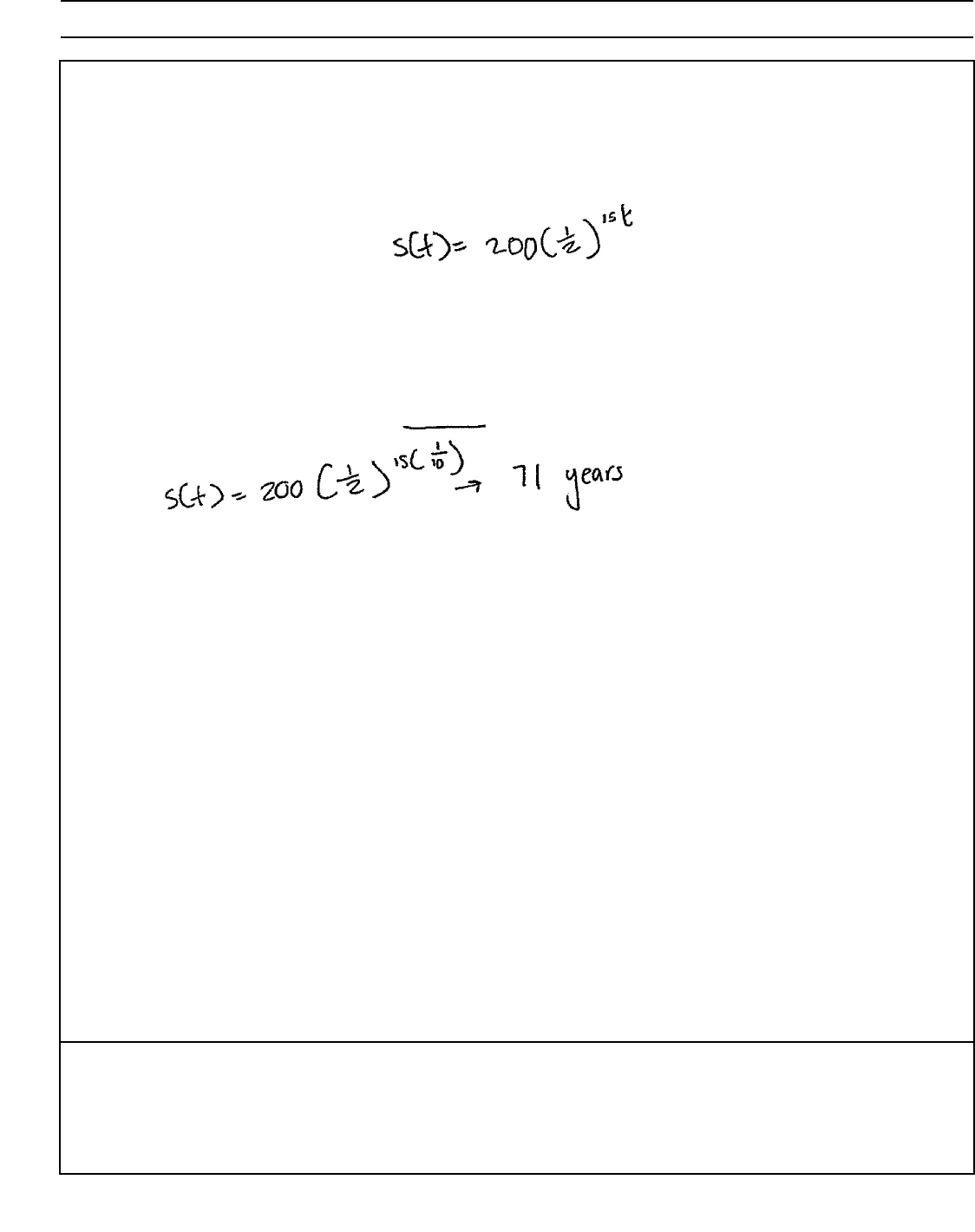
Algebra II – June ’19 [55]
Question 34
Score 1: The student received 1 credit for the equation.
34 The half-life of a radioactive substance is 15 years.
Write an equation that can be used to determine the amount, s(t), of 200 grams of this substance
that remains after t years.
Determine algebraically, to the nearest year, how long it will take for
1
__
10
of this substance to
remain.
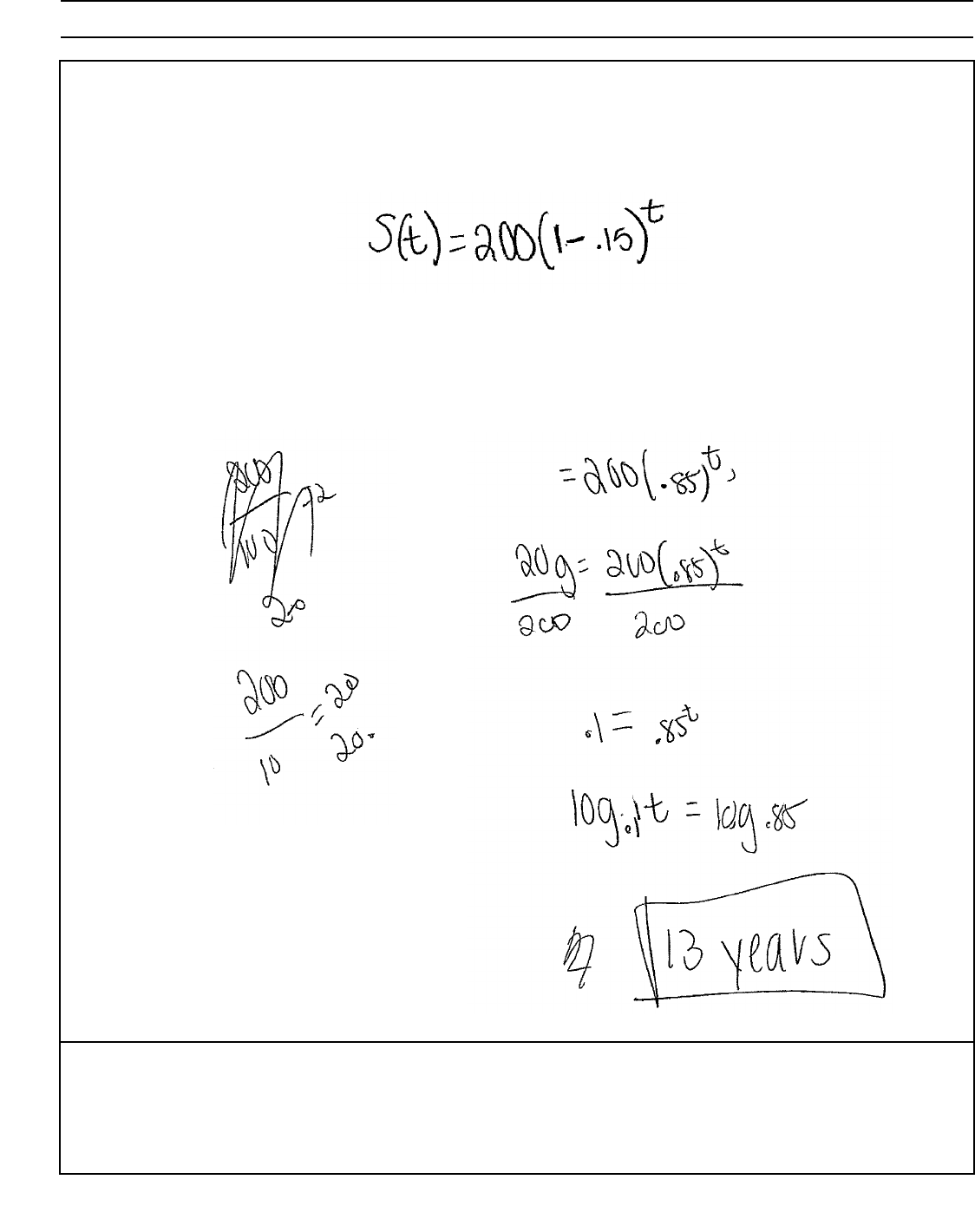
Algebra II – June ’19 [56]
Question 34
Score 0: The student did not show enough correct work to receive any credit.
34 The half-life of a radioactive substance is 15 years.
Write an equation that can be used to determine the amount, s(t), of 200 grams of this substance
that remains after t years.
Determine algebraically, to the nearest year, how long it will take for
1
__
10
of this substance to
remain.

Algebra II – June ’19 [57]
Question 35
Score 4: The student gave a complete and correct response.
35 Determine an equation for the parabola with focus (4, 1) and directrix y 5.
(Use of the grid below is optional.)
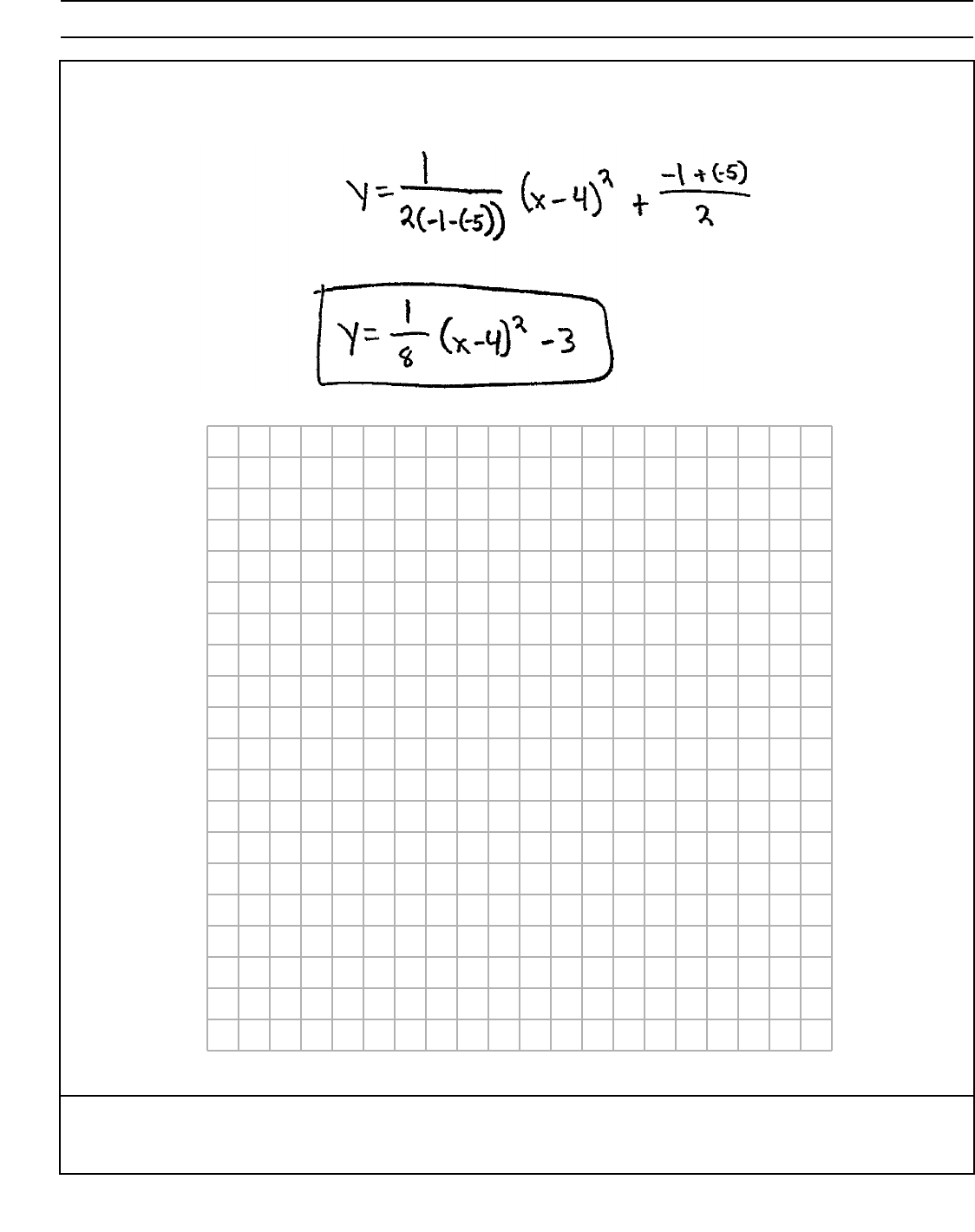
Algebra II – June ’19 [58]
Question 35
Score 4: The student gave a complete and correct response.
35 Determine an equation for the parabola with focus (4, 1) and directrix y 5.
(Use of the grid below is optional.)
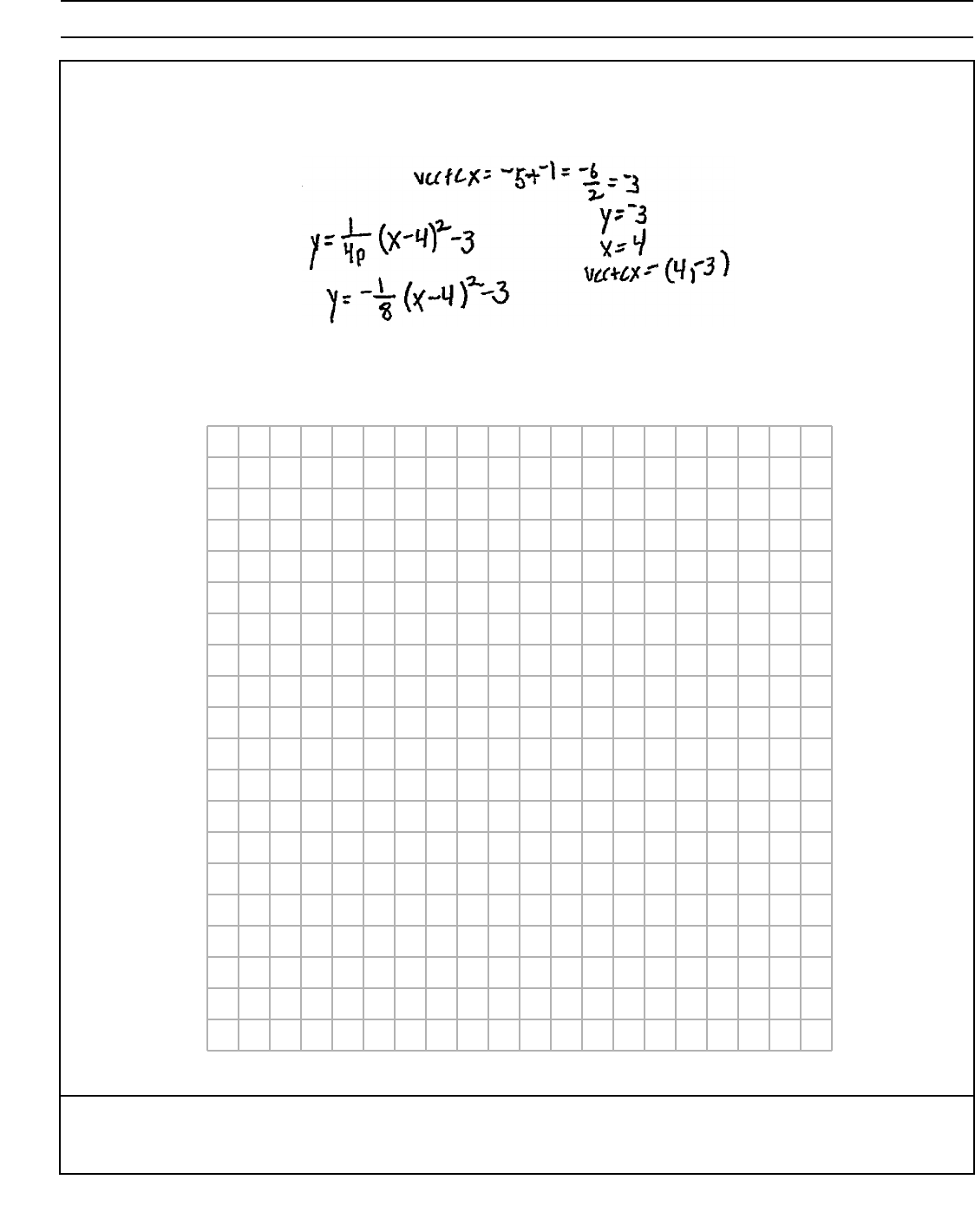
Algebra II – June ’19 [59]
Question 35
Score 3: The student used an incorrect value for p.
35 Determine an equation for the parabola with focus (4, 1) and directrix y 5.
(Use of the grid below is optional.)
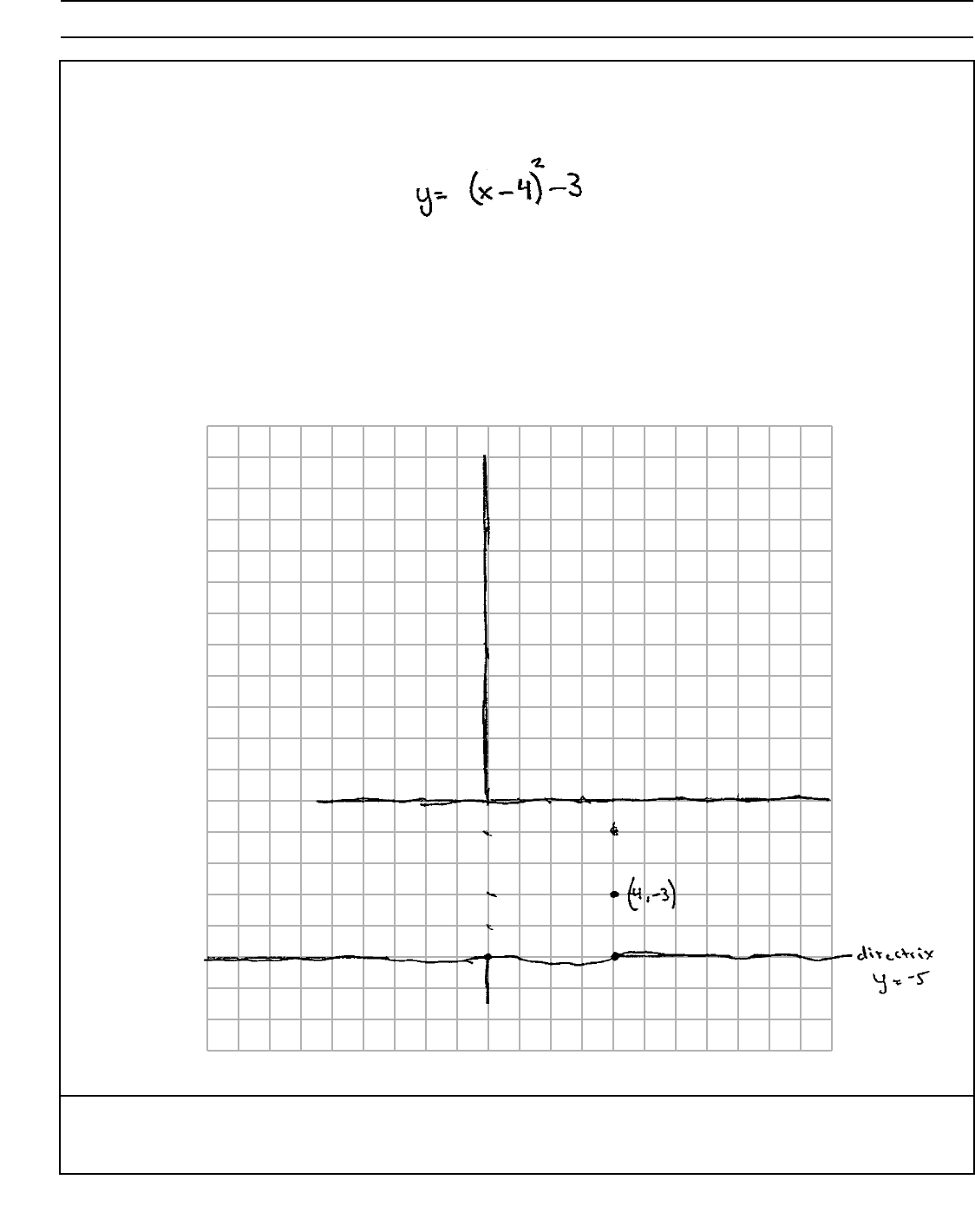
Algebra II – June ’19 [60]
Question 35
Score 2: The student correctly found the vertex and received 1 credit for the equation.
35 Determine an equation for the parabola with focus (4, 1) and directrix y 5.
(Use of the grid below is optional.)
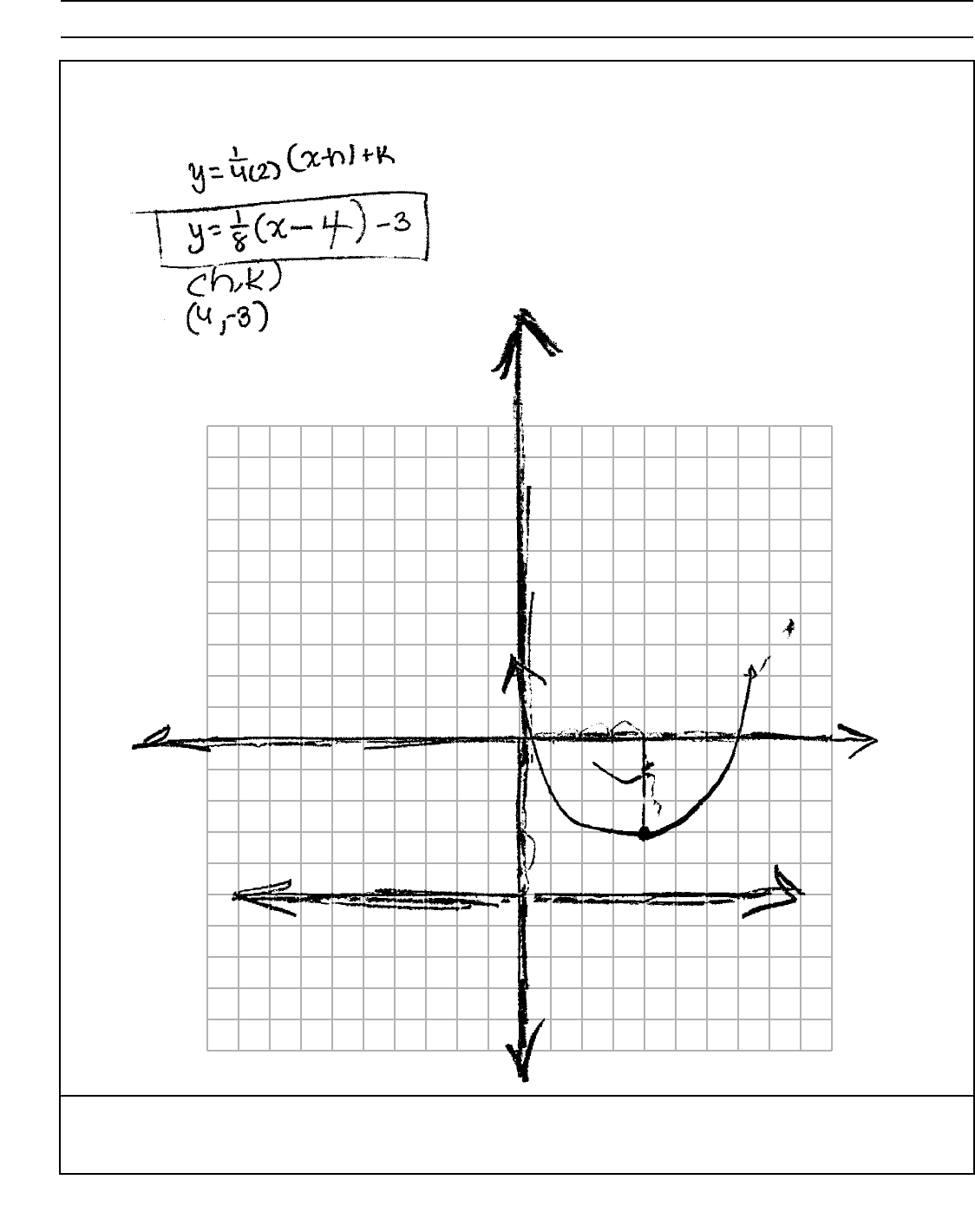
Algebra II – June ’19 [61]
Question 35
Score 2: The student correctly found the vertex and received 1 credit for the equation.
35 Determine an equation for the parabola with focus (4, 1) and directrix y 5.
(Use of the grid below is optional.)
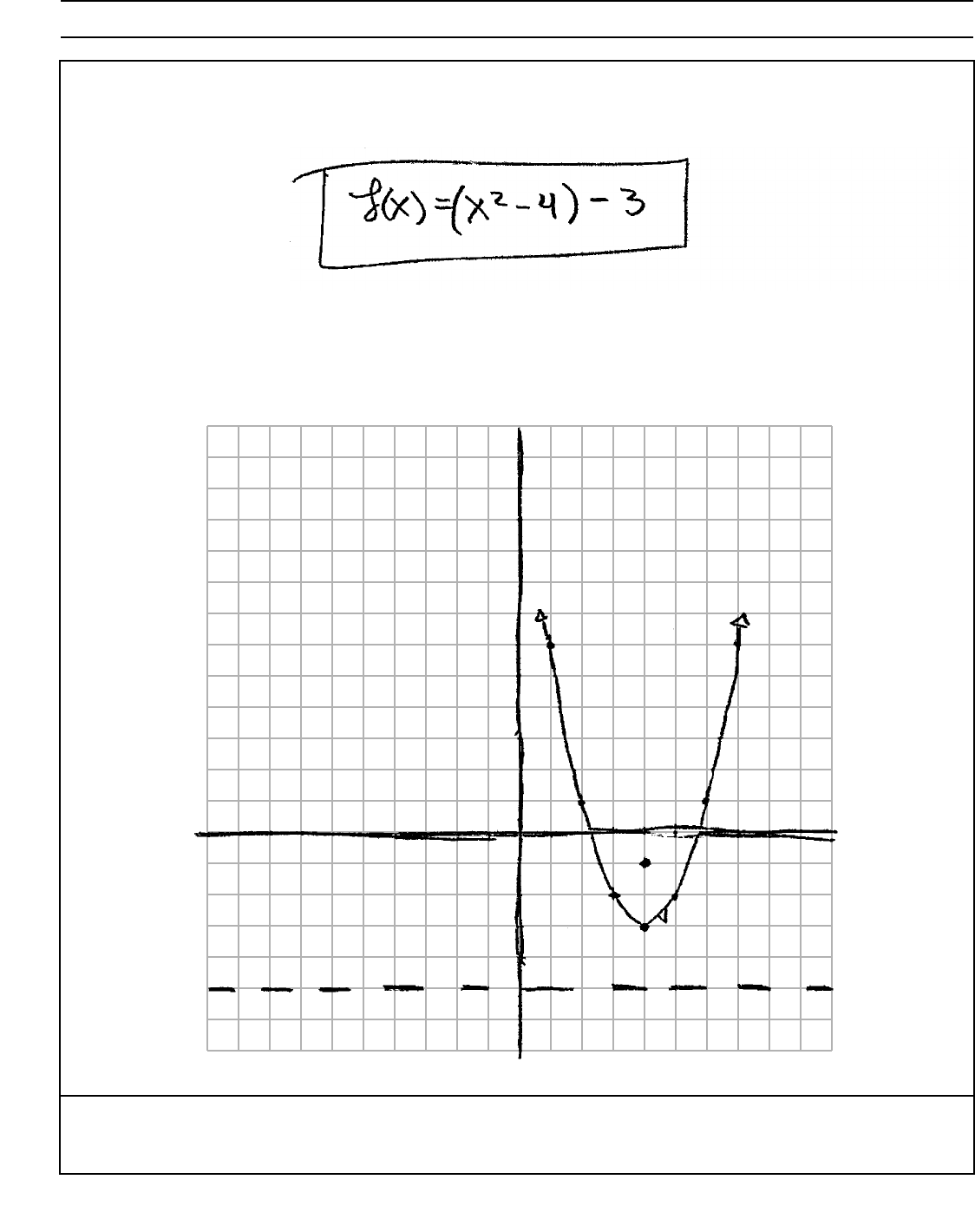
Algebra II – June ’19 [62]
Question 35
Score 1: The student correctly found the vertex, but made multiple errors writing the equation.
35 Determine an equation for the parabola with focus (4, 1) and directrix y 5.
(Use of the grid below is optional.)
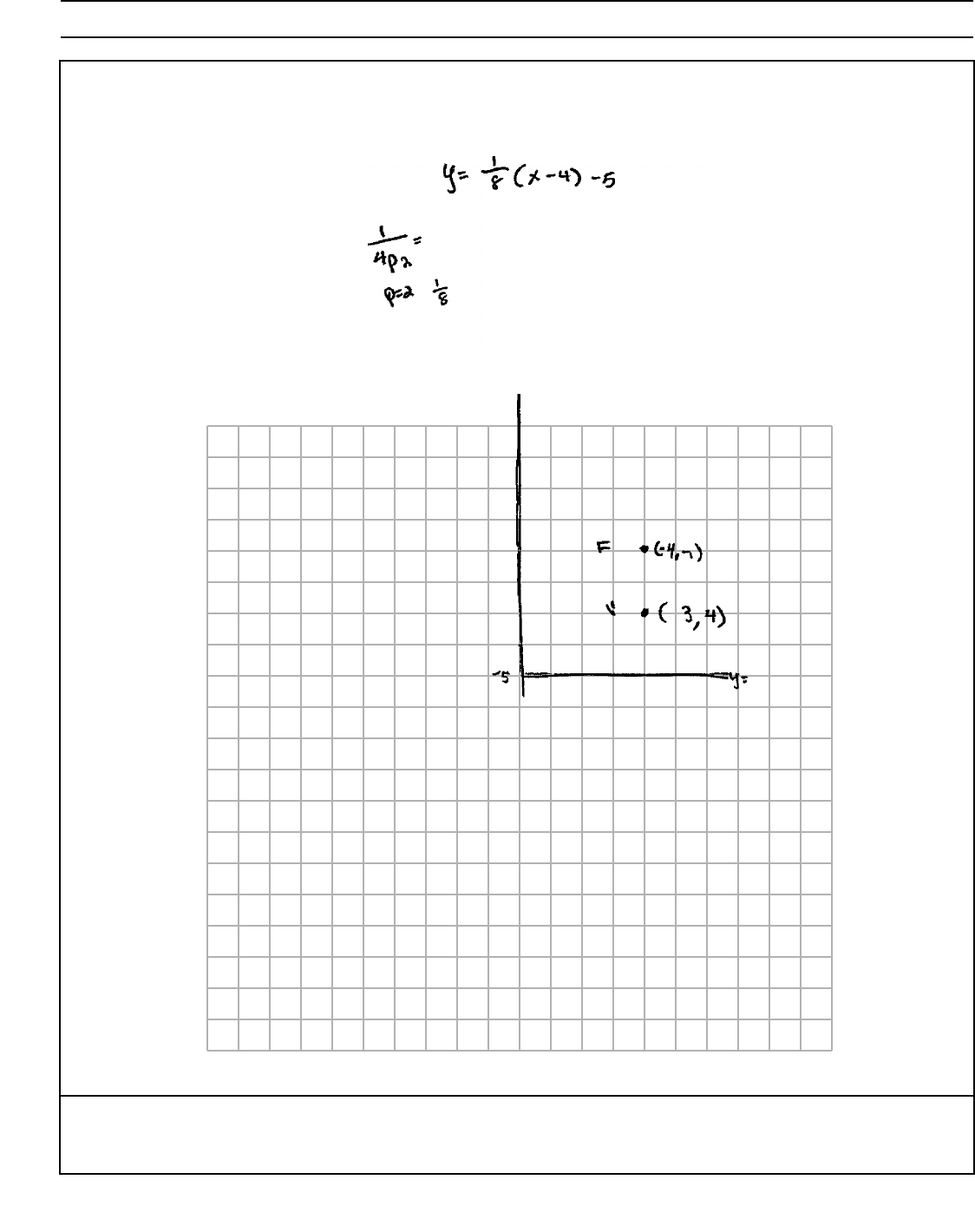
Algebra II – June ’19 [63]
Question 35
Score 0: The student did not show enough correct work to receive any credit.
35 Determine an equation for the parabola with focus (4, 1) and directrix y 5.
(Use of the grid below is optional.)
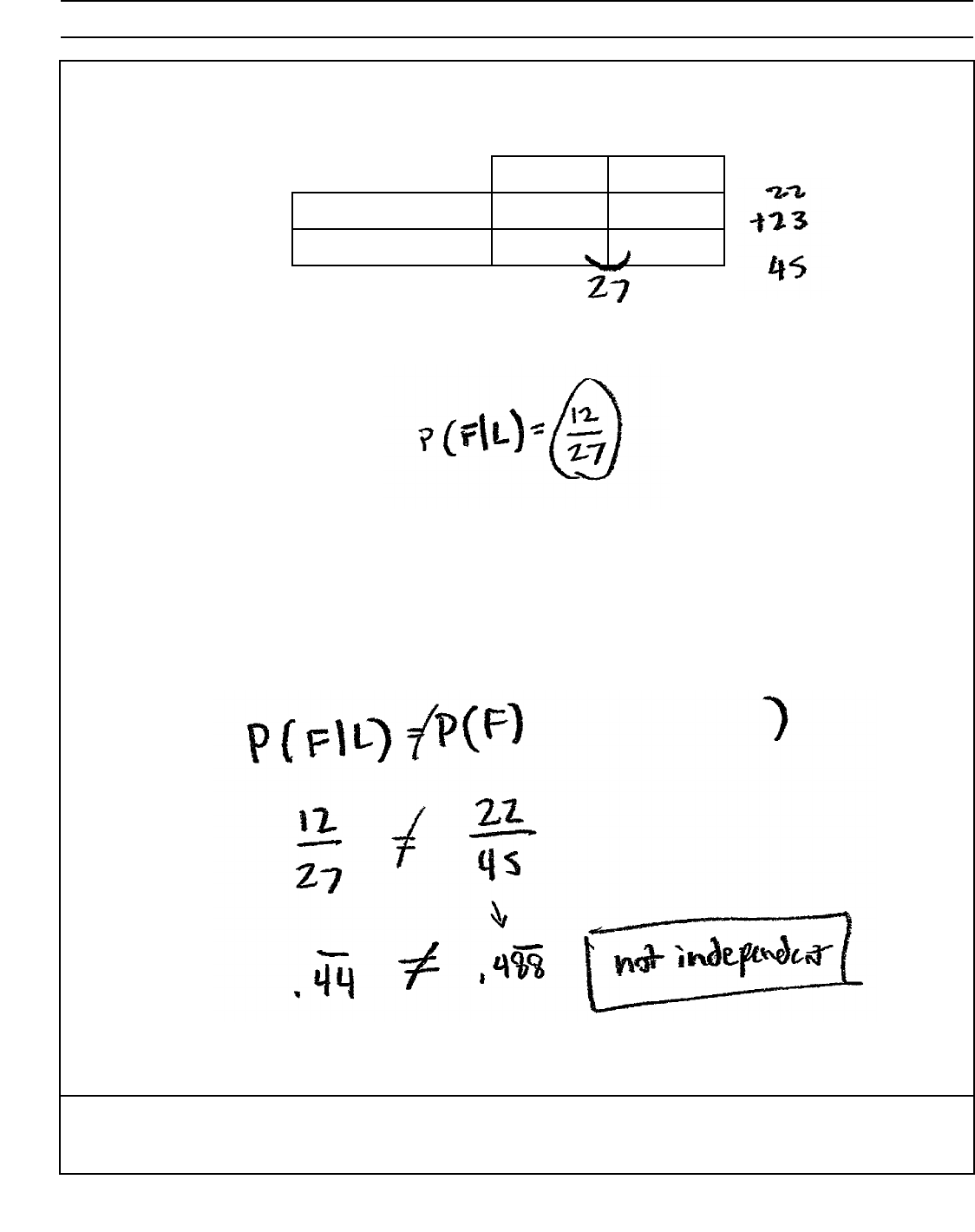
Algebra II – June ’19 [64]
Question 36
Score 4: The student gave a complete and correct response.
36 Juan and Filipe practice at the driving range before playing golf. The number of wins and
corresponding practice times for each player are shown in the table below.
Given that the practice time was long, determine the exact probability that Filipe wins the next
match.
Juan Wins Filipe Wins
Short Practice Time 8 10
Long Practice Time 15 12
Determine whether or not the two events “Filipe wins” and “long practice time” are independent.
Justify your answer.
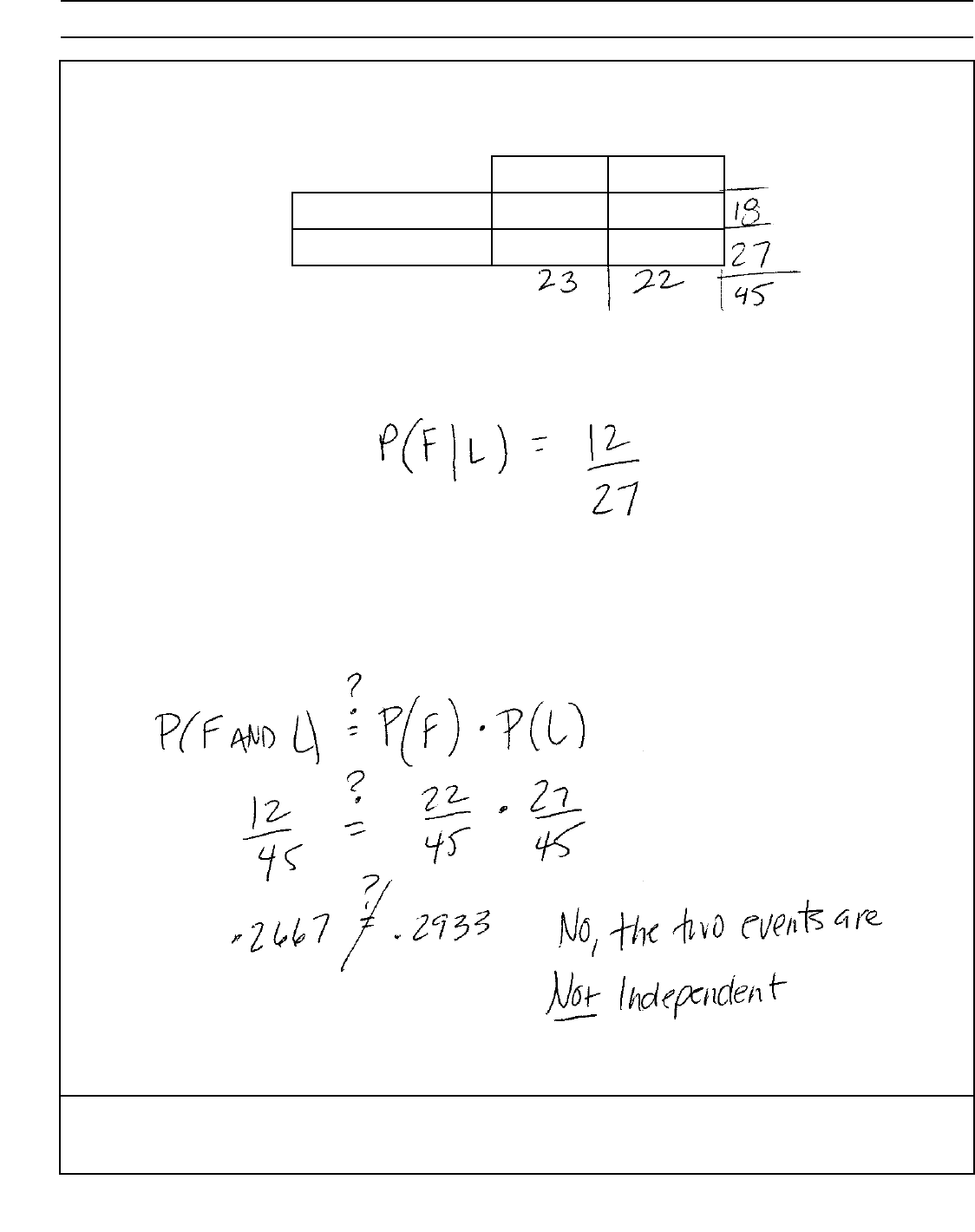
Algebra II – June ’19 [65]
Question 36
Score 4: The student gave a complete and correct response.
Given that the practice time was long, determine the exact probability that Filipe wins the next
match.
Determine whether or not the two events “Filipe wins” and “long practice time” are independent.
Justify your answer.
36 Juan and Filipe practice at the driving range before playing golf. The number of wins and
corresponding practice times for each player are shown in the table below.
Juan Wins Filipe Wins
Short Practice Time 8 10
Long Practice Time 15 12
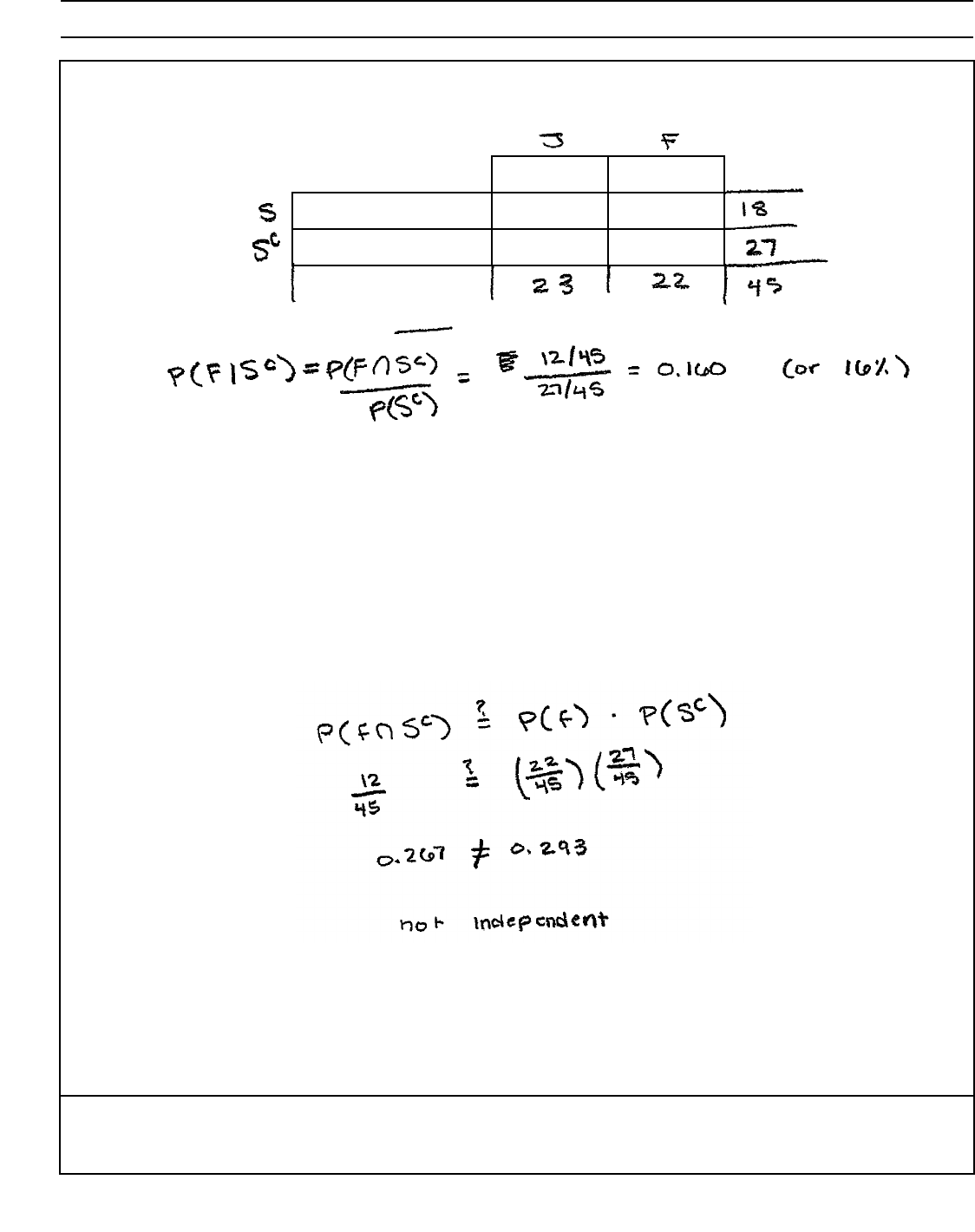
Algebra II – June ’19 [66]
Question 36
Score 3: The student made a computational error finding p
(
f |s
c
)
.
36 Juan and Filipe practice at the driving range before playing golf. The number of wins and
corresponding practice times for each player are shown in the table below.
Given that the practice time was long, determine the exact probability that Filipe wins the next
match.
Juan Wins Filipe Wins
Short Practice Time 8 10
Long Practice Time 15 12
Determine whether or not the two events “Filipe wins” and “long practice time” are independent.
Justify your answer.
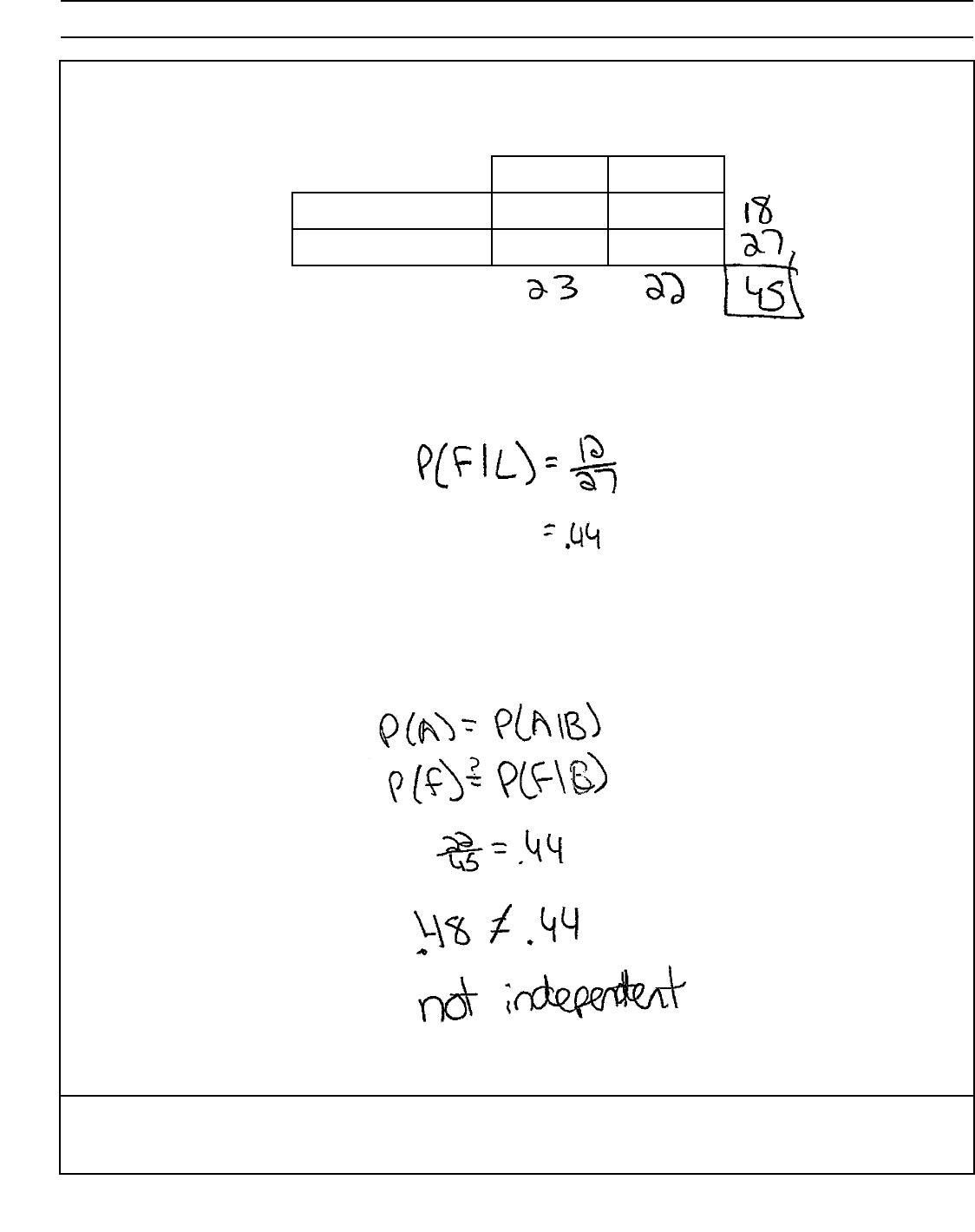
Algebra II – June ’19 [67]
Question 36
Score 3: The student made an error rounding to 0.48.
36 Juan and Filipe practice at the driving range before playing golf. The number of wins and
corresponding practice times for each player are shown in the table below.
Juan Wins Filipe Wins
Short Practice Time 8 10
Long Practice Time 15 12
Determine whether or not the two events “Filipe wins” and “long practice time” are independent.
Justify your answer.
Given that the practice time was long, determine the exact probability that Filipe wins the next
match.
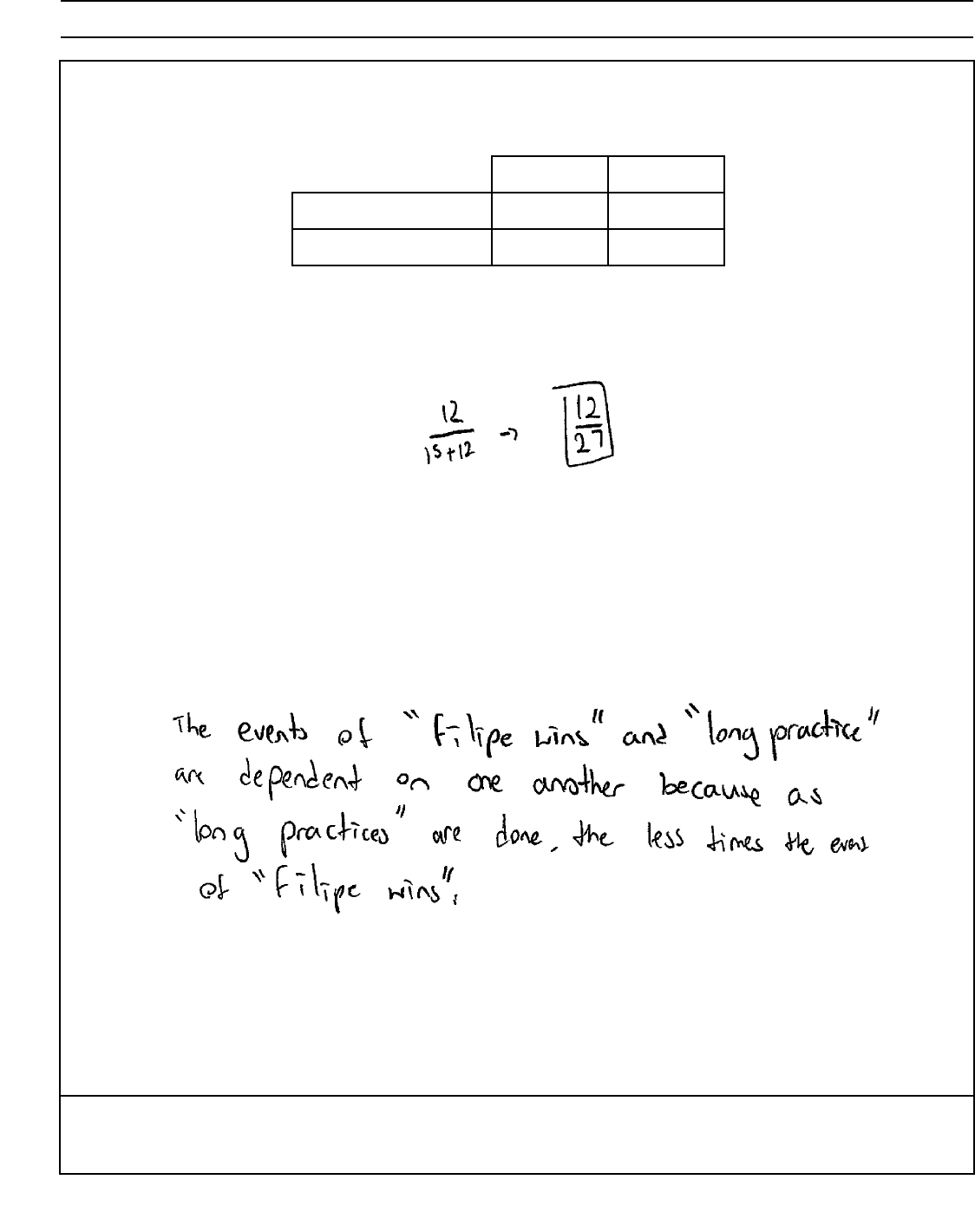
Algebra II – June ’19 [68]
Question 36
Score 2: The student only received credit for the first part.
36 Juan and Filipe practice at the driving range before playing golf. The number of wins and
corresponding practice times for each player are shown in the table below.
Given that the practice time was long, determine the exact probability that Filipe wins the next
match.
Juan Wins Filipe Wins
Short Practice Time 8 10
Long Practice Time 15 12
Determine whether or not the two events “Filipe wins” and “long practice time” are independent.
Justify your answer.
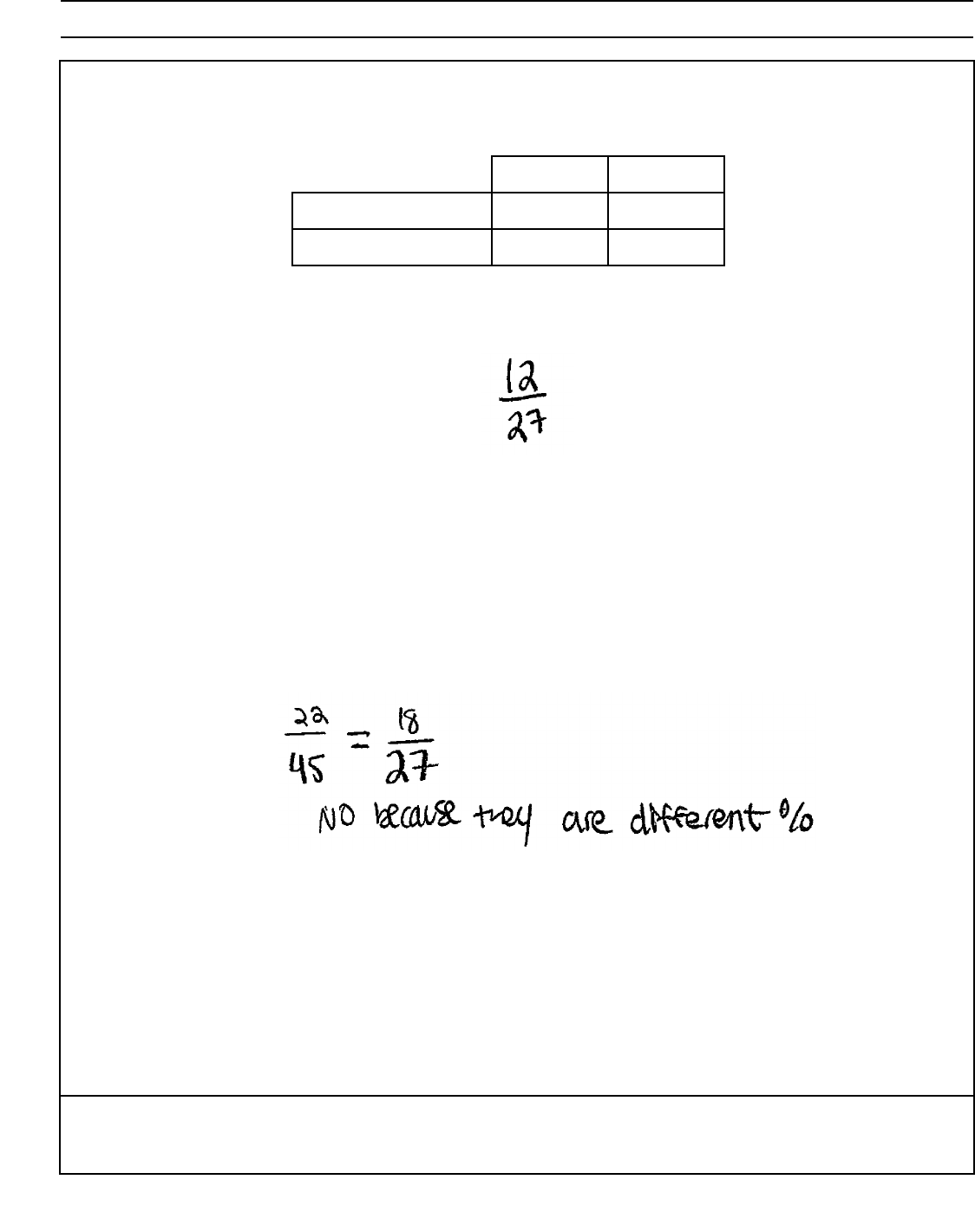
Algebra II – June ’19 [69]
Question 36
Score 1: The student received one credit for
12___
27
.
36 Juan and Filipe practice at the driving range before playing golf. The number of wins and
corresponding practice times for each player are shown in the table below.
Given that the practice time was long, determine the exact probability that Filipe wins the next
match.
Juan Wins Filipe Wins
Short Practice Time 8 10
Long Practice Time 15 12
Determine whether or not the two events “Filipe wins” and “long practice time” are independent.
Justify your answer.
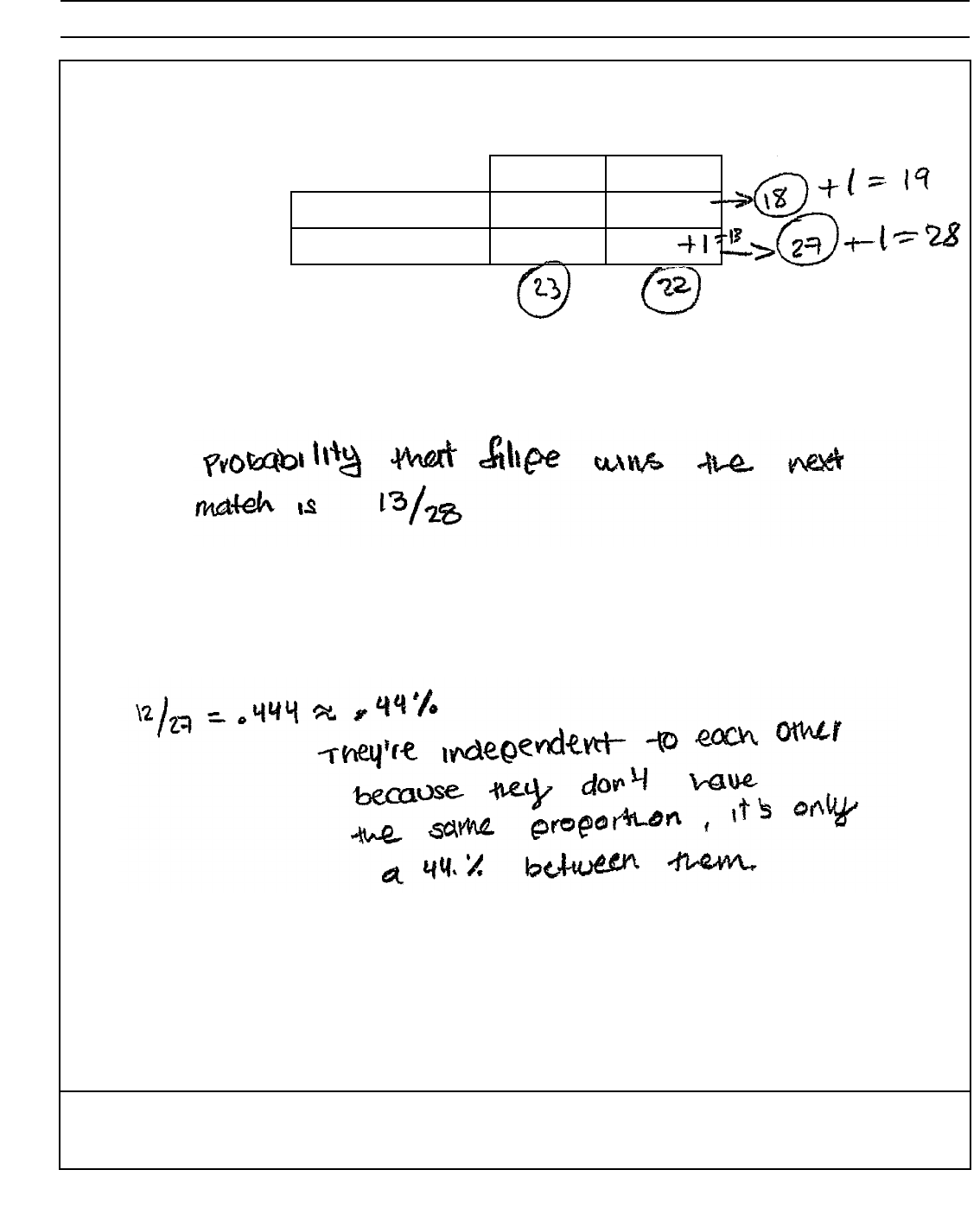
Algebra II – June ’19 [70]
Question 36
Score 0: The student did not show enough correct work to receive any credit.
36 Juan and Filipe practice at the driving range before playing golf. The number of wins and
corresponding practice times for each player are shown in the table below.
Juan Wins Filipe Wins
Short Practice Time 8 10
Long Practice Time 15 12
Determine whether or not the two events “Filipe wins” and “long practice time” are independent.
Justify your answer.
Given that the practice time was long, determine the exact probability that Filipe wins the next
match.

Algebra II – June ’19 [71]
Question 37
Interpret what the period represents in this context.
Score 6: The student gave a complete and correct response.
37 Griffin is riding his bike down the street in Churchville, N.Y. at a constant speed, when a nail gets
caught in one of his tires. The height of the nail above the ground, in inches, can be represented
by the trigonometric function f(t) 13cos(0.8πt) 13, where t represents the time (in seconds)
since the nail first became caught in the tire.
Determine the period of f(t).
Question 37 is continued on the next page.
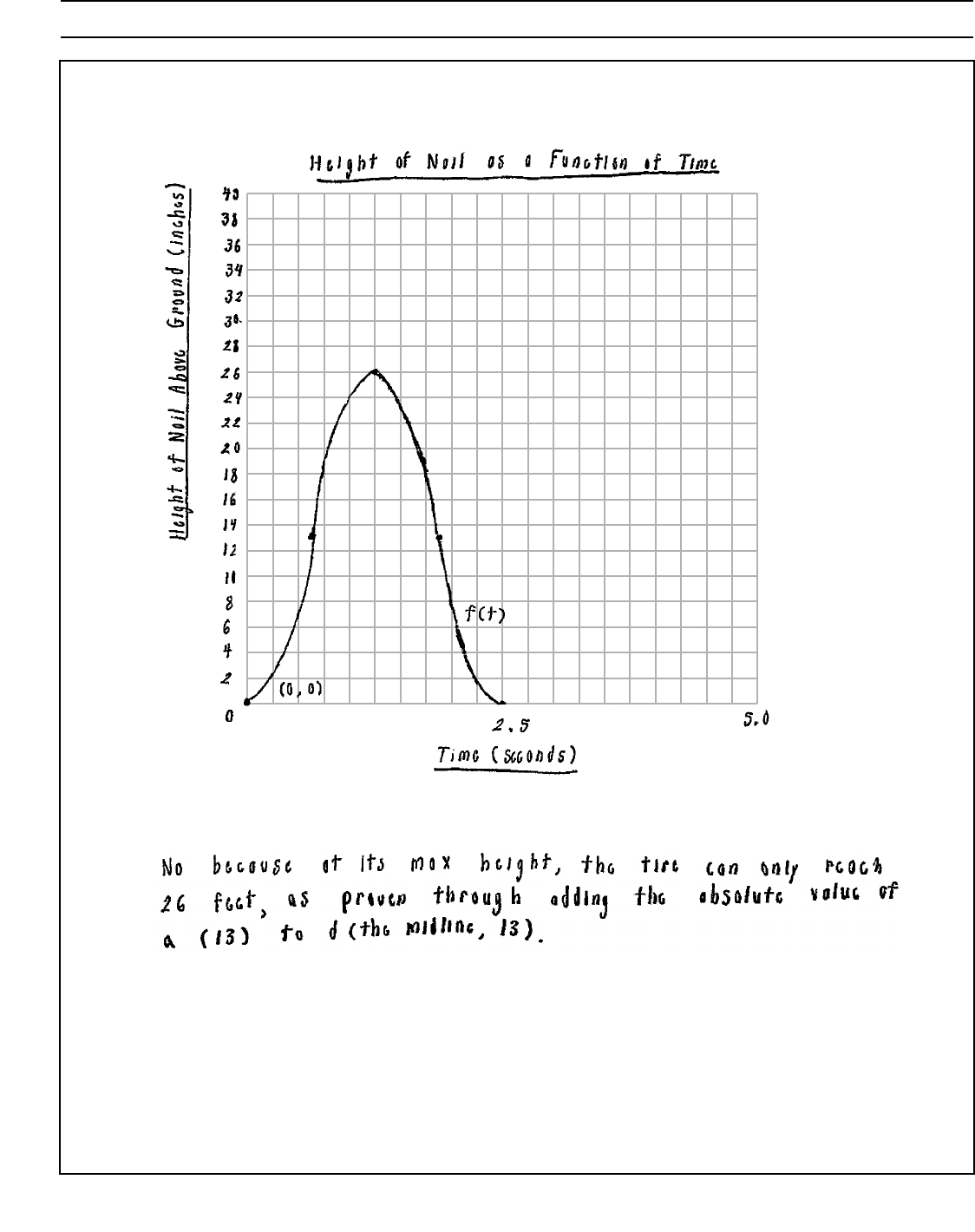
Algebra II – June ’19 [72]
Question 37 continued.
On the grid below, graph at least one cycle of f(t) that includes the y-intercept of the function.
Does the height of the nail ever reach 30 inches above the ground? Justify your answer.
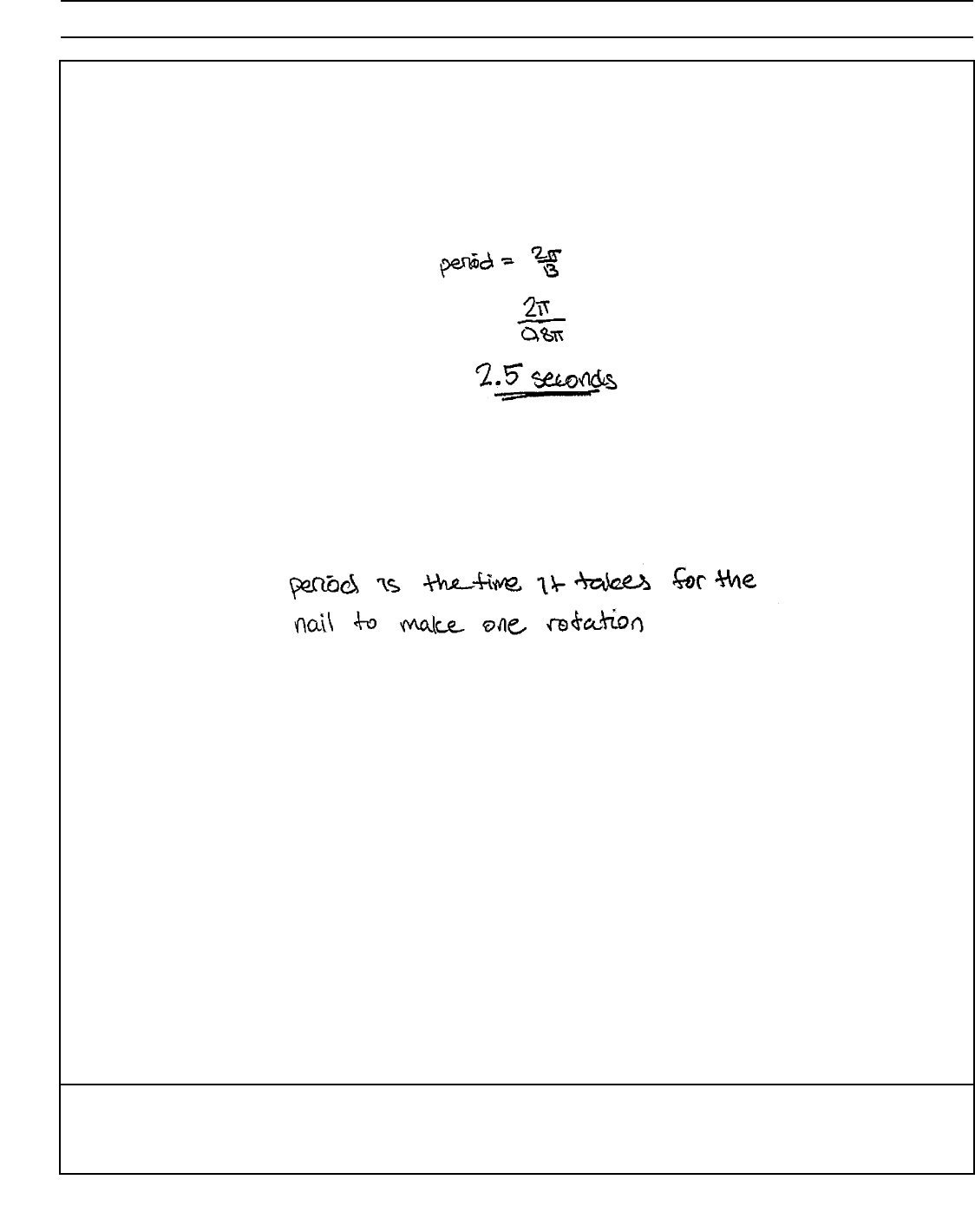
Algebra II – June ’19 [73]
Question 37
Interpret what the period represents in this context.
Score 6: The student gave a complete and correct response.
37 Griffin is riding his bike down the street in Churchville, N.Y. at a constant speed, when a nail gets
caught in one of his tires. The height of the nail above the ground, in inches, can be represented
by the trigonometric function f(t) 13cos(0.8πt) 13, where t represents the time (in seconds)
since the nail first became caught in the tire.
Determine the period of f(t).
Question 37 is continued on the next page.
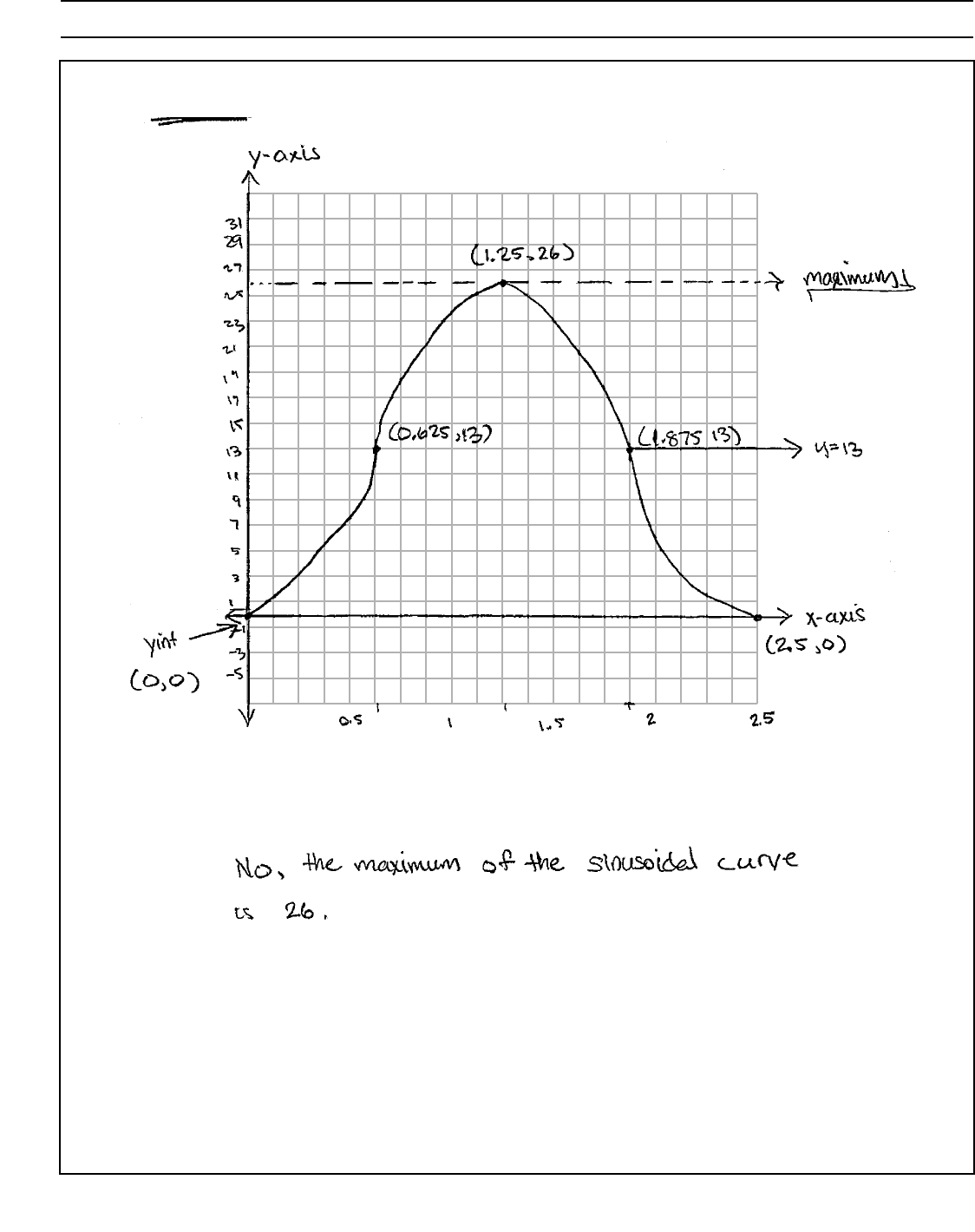
Algebra II – June ’19 [74]
Question 37 continued.
On the grid below, graph at least one cycle of f(t) that includes the y-intercept of the function.
Does the height of the nail ever reach 30 inches above the ground? Justify your answer.
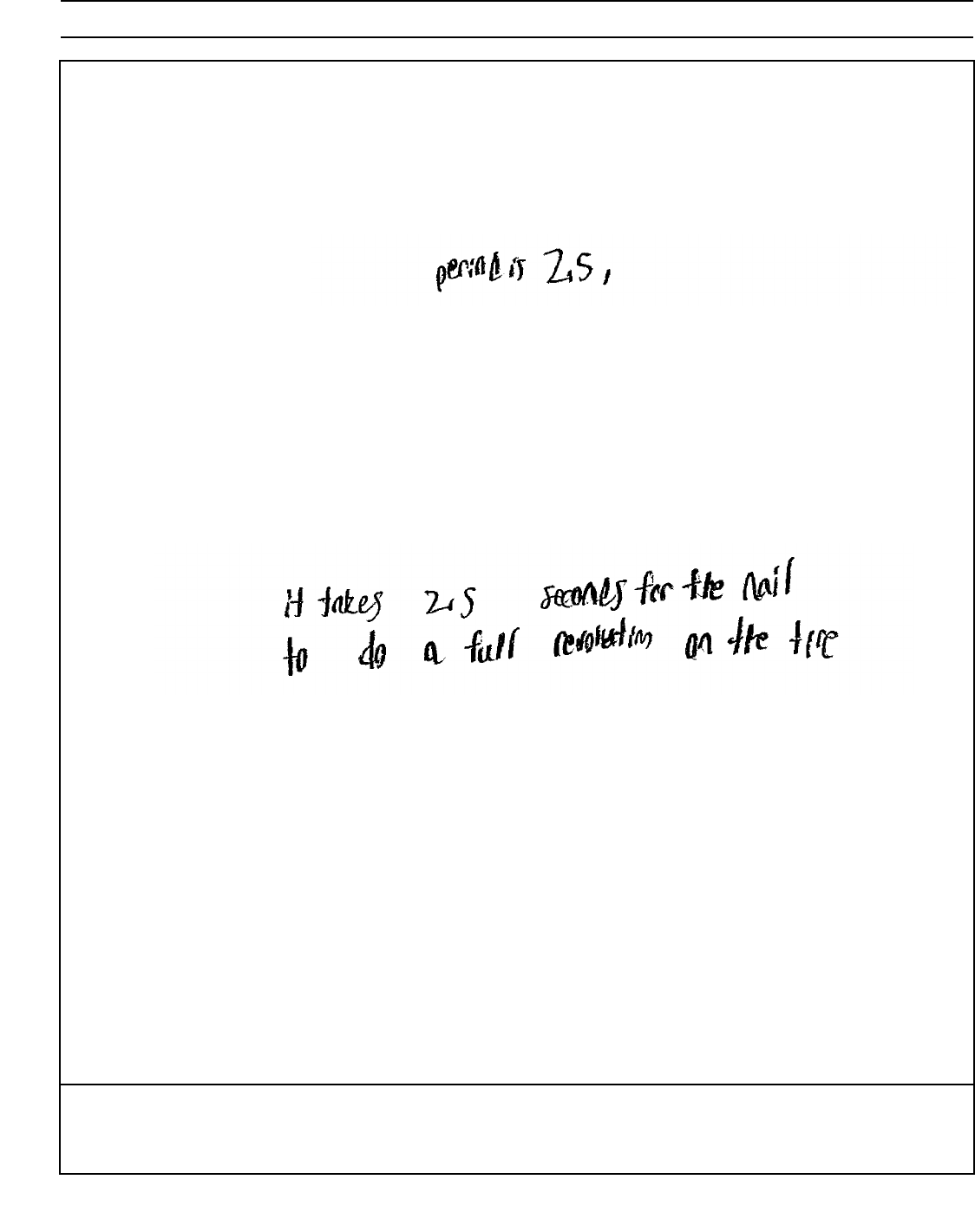
Algebra II – June ’19 [75]
Question 37
Interpret what the period represents in this context.
Score 5: The student made one graphing error.
37 Griffin is riding his bike down the street in Churchville, N.Y. at a constant speed, when a nail gets
caught in one of his tires. The height of the nail above the ground, in inches, can be represented
by the trigonometric function f(t) 13cos(0.8πt) 13, where t represents the time (in seconds)
since the nail first became caught in the tire.
Determine the period of f(t).
Question 37 is continued on the next page.
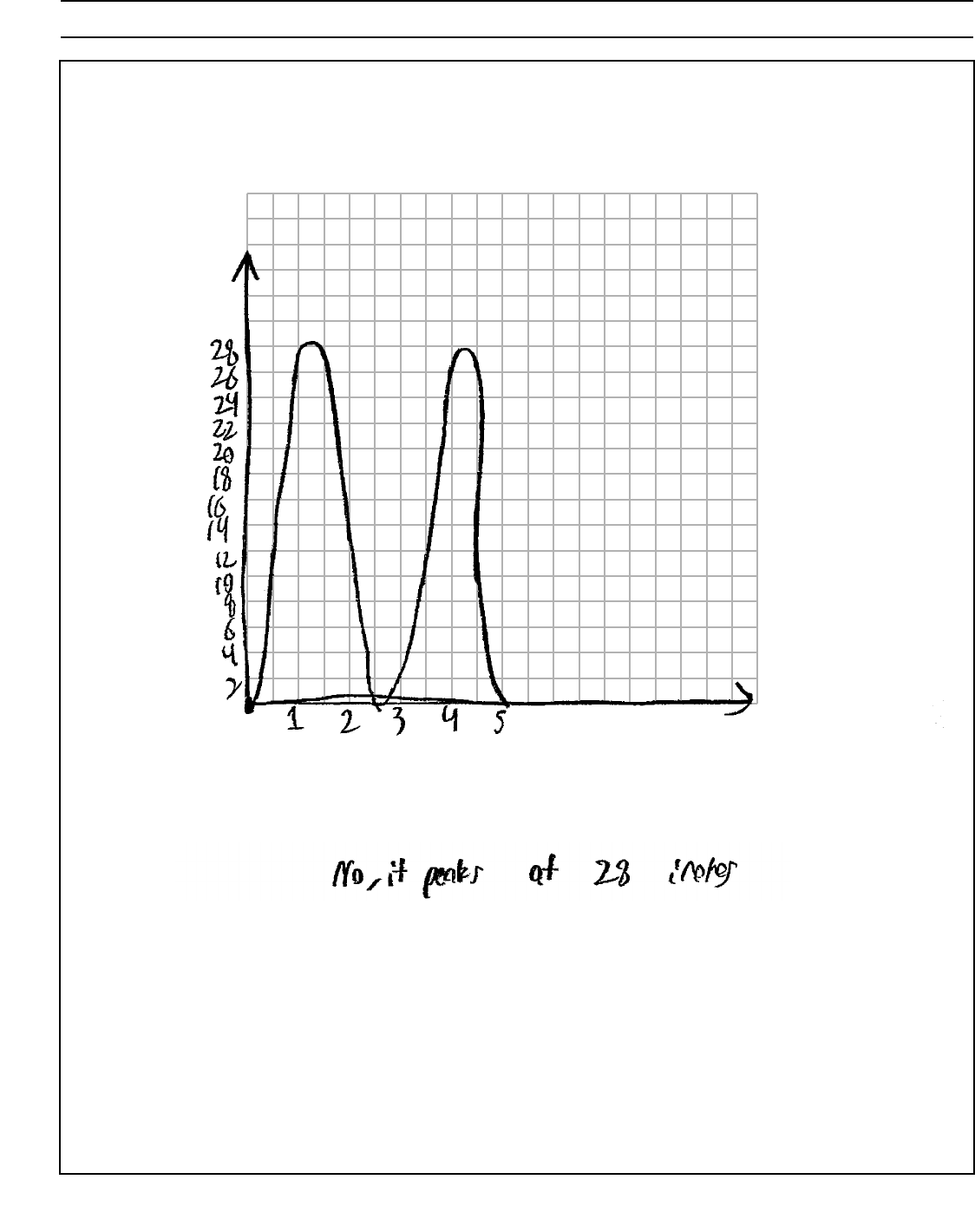
Algebra II – June ’19 [76]
Question 37 continued.
On the grid below, graph at least one cycle of f(t) that includes the y-intercept of the function.
Does the height of the nail ever reach 30 inches above the ground? Justify your answer.
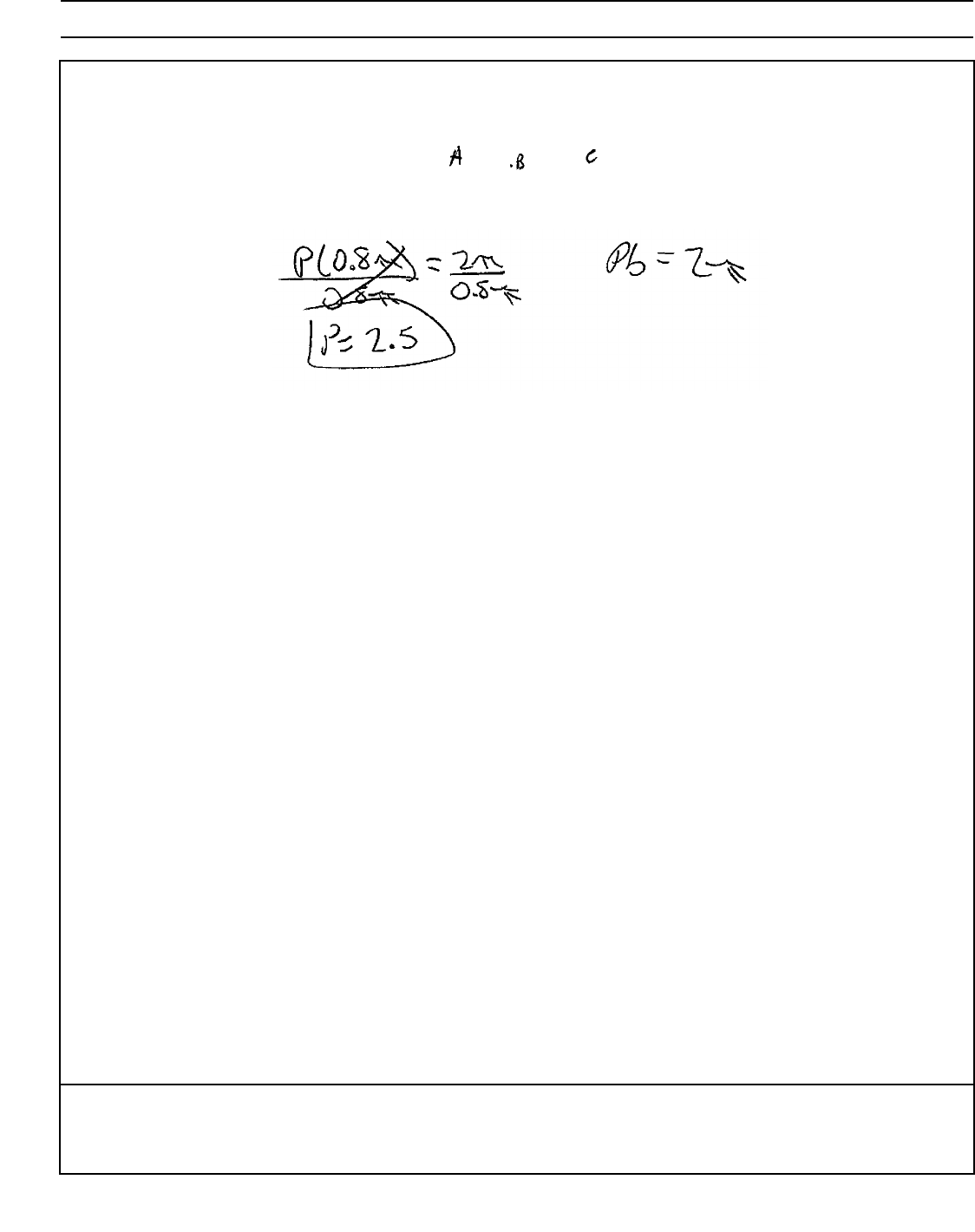
Algebra II – June ’19 [77]
Question 37
Interpret what the period represents in this context.
Score 4: The student did not interpret the period and gave an incomplete justification in the last
part.
37 Griffin is riding his bike down the street in Churchville, N.Y. at a constant speed, when a nail gets
caught in one of his tires. The height of the nail above the ground, in inches, can be represented
by the trigonometric function f(t) 13cos(0.8πt) 13, where t represents the time (in seconds)
since the nail first became caught in the tire.
Determine the period of f(t).
Question 37 is continued on the next page.
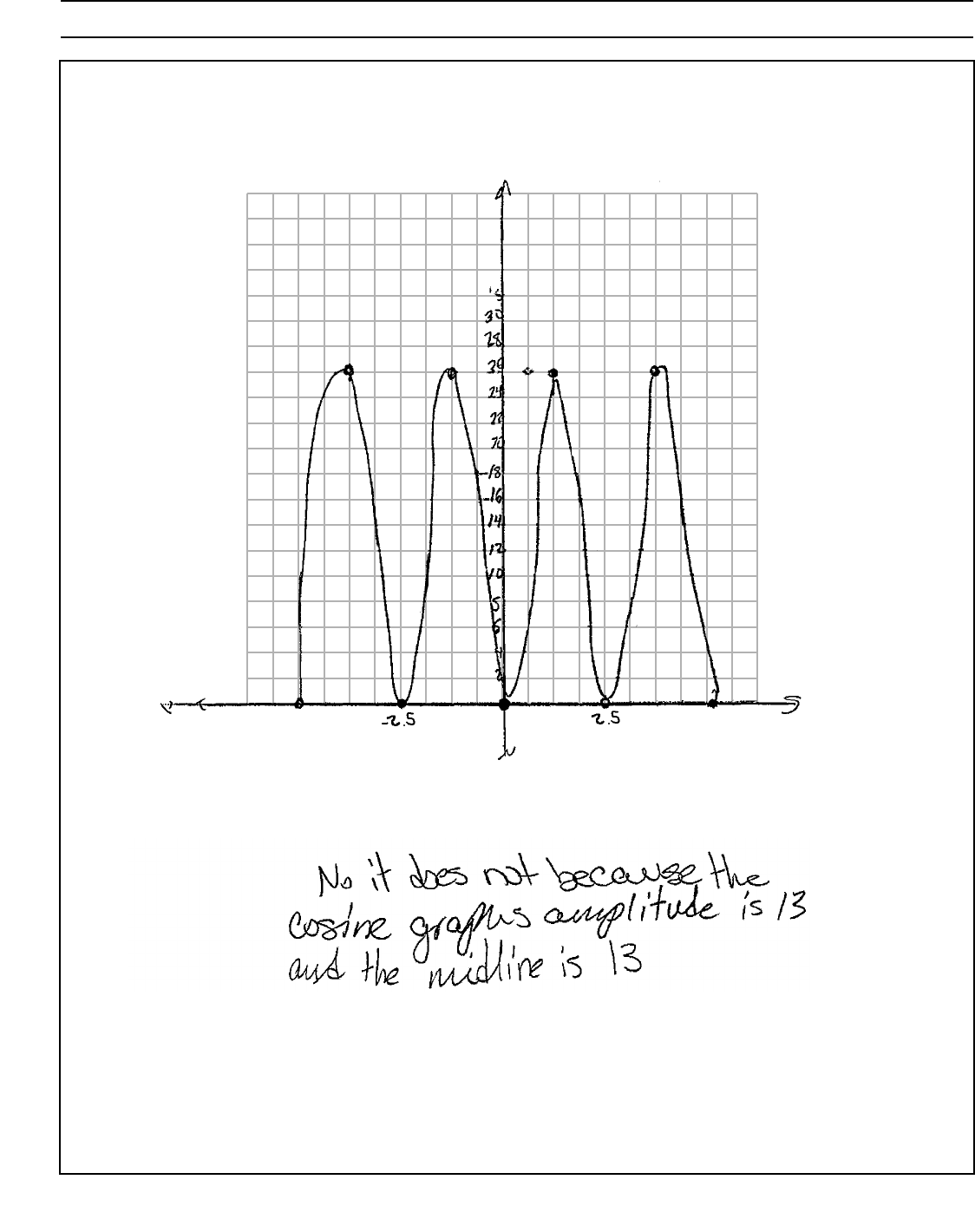
Algebra II – June ’19 [78]
Question 37 continued.
On the grid below, graph at least one cycle of f(t) that includes the y-intercept of the function.
Does the height of the nail ever reach 30 inches above the ground? Justify your answer.
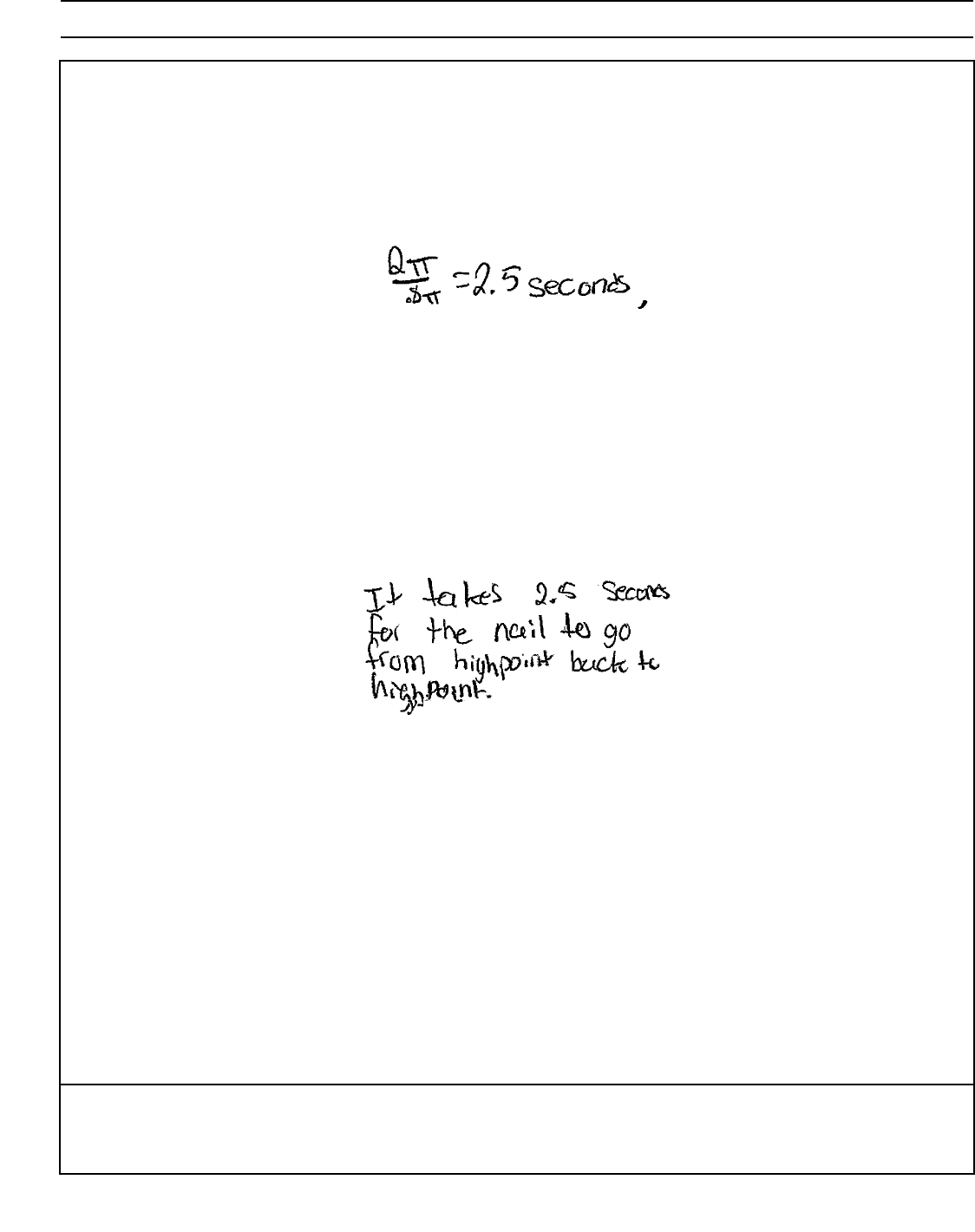
Algebra II – June ’19 [79]
Question 37
Interpret what the period represents in this context.
Score 3: The student made a labeling error on the graph and did not answer the last part.
37 Griffin is riding his bike down the street in Churchville, N.Y. at a constant speed, when a nail gets
caught in one of his tires. The height of the nail above the ground, in inches, can be represented
by the trigonometric function f(t) 13cos(0.8πt) 13, where t represents the time (in seconds)
since the nail first became caught in the tire.
Determine the period of f(t).
Question 37 is continued on the next page.
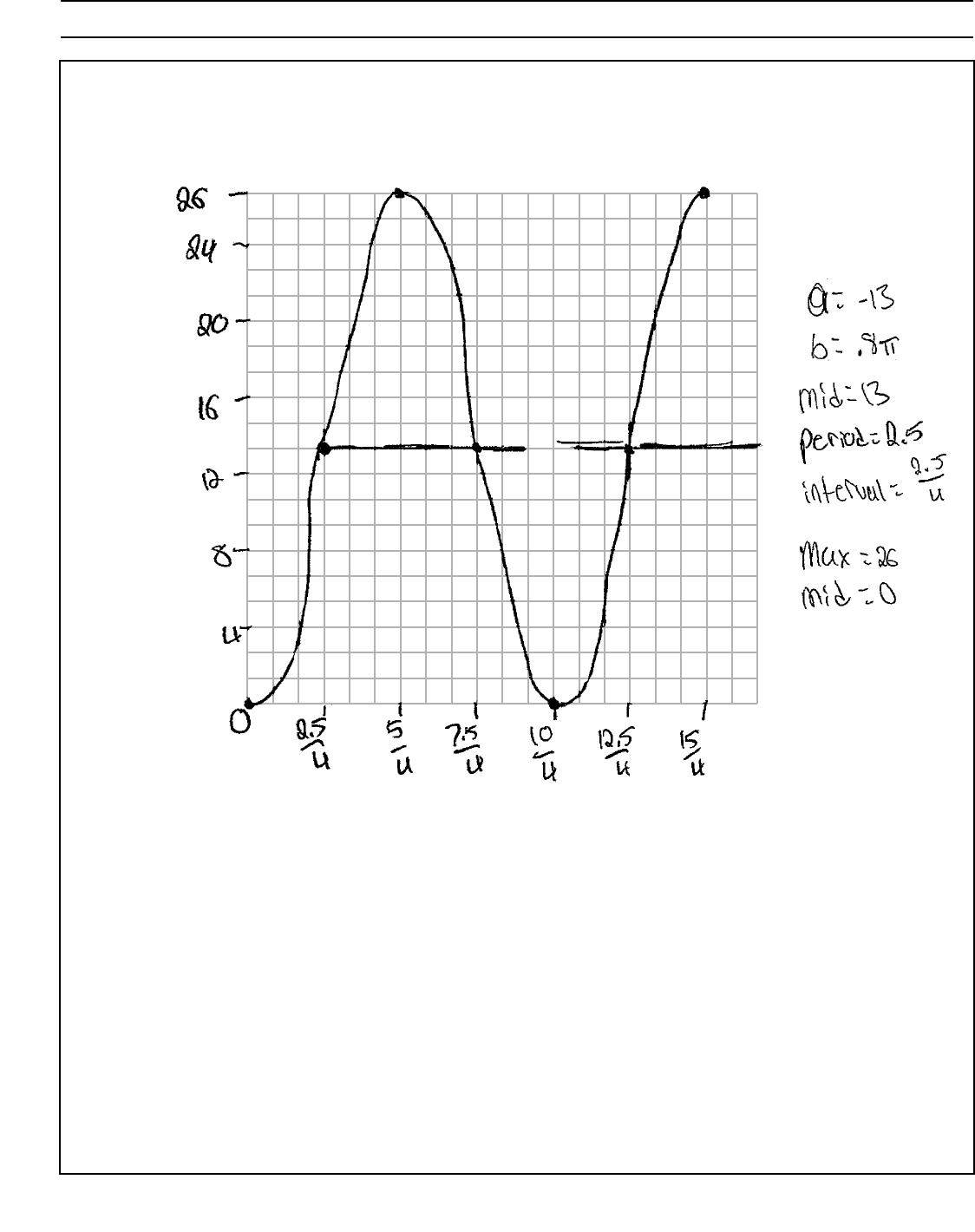
Algebra II – June ’19 [80]
Question 37 continued.
On the grid below, graph at least one cycle of f(t) that includes the y-intercept of the function.
Does the height of the nail ever reach 30 inches above the ground? Justify your answer.
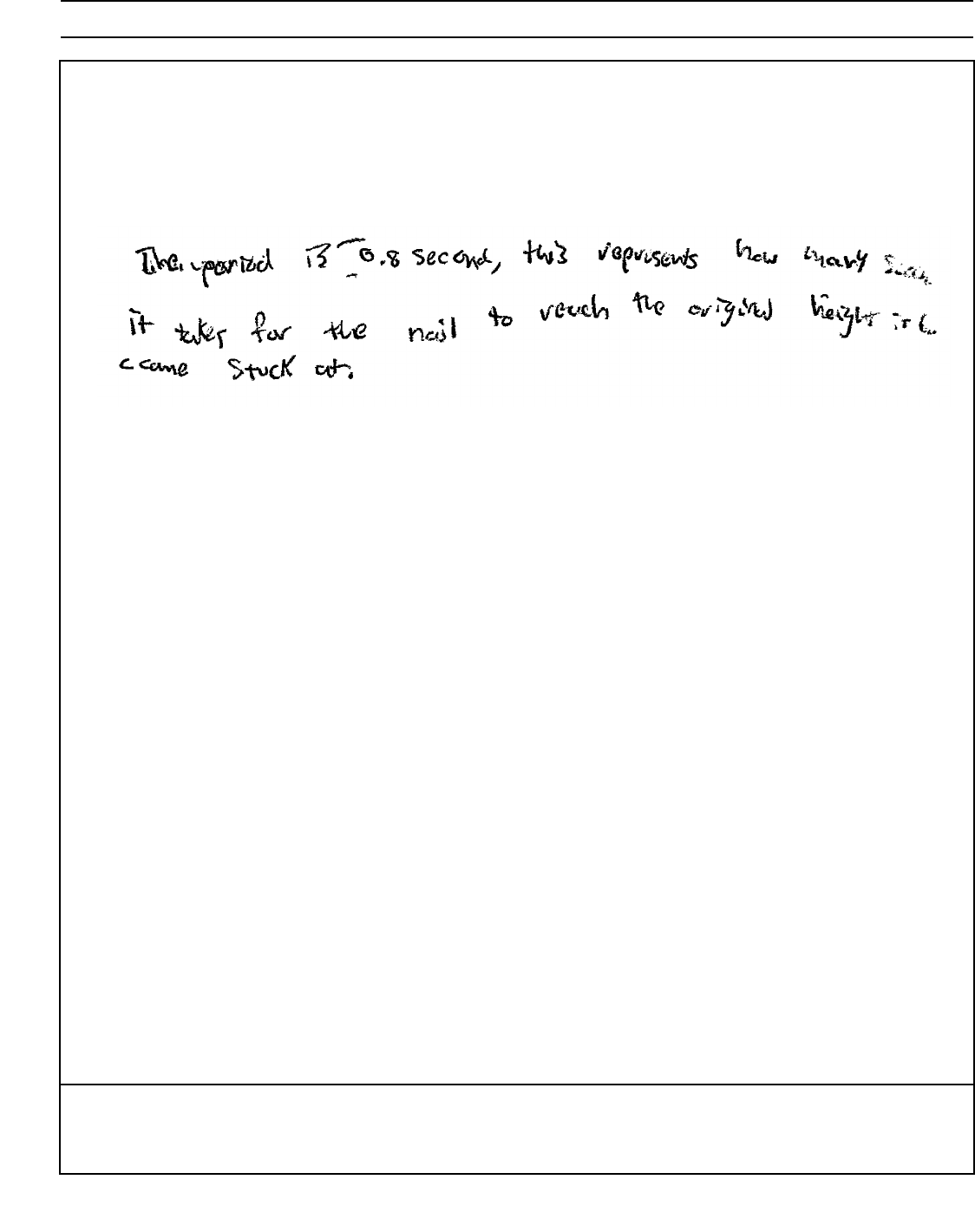
Algebra II – June ’19 [81]
Question 37
Interpret what the period represents in this context.
Score 3: The student gave a correct interpretation based on an incorrect period and received full
credit for the graph.
37 Griffin is riding his bike down the street in Churchville, N.Y. at a constant speed, when a nail gets
caught in one of his tires. The height of the nail above the ground, in inches, can be represented
by the trigonometric function f(t) 13cos(0.8πt) 13, where t represents the time (in seconds)
since the nail first became caught in the tire.
Determine the period of f(t).
Question 37 is continued on the next page.
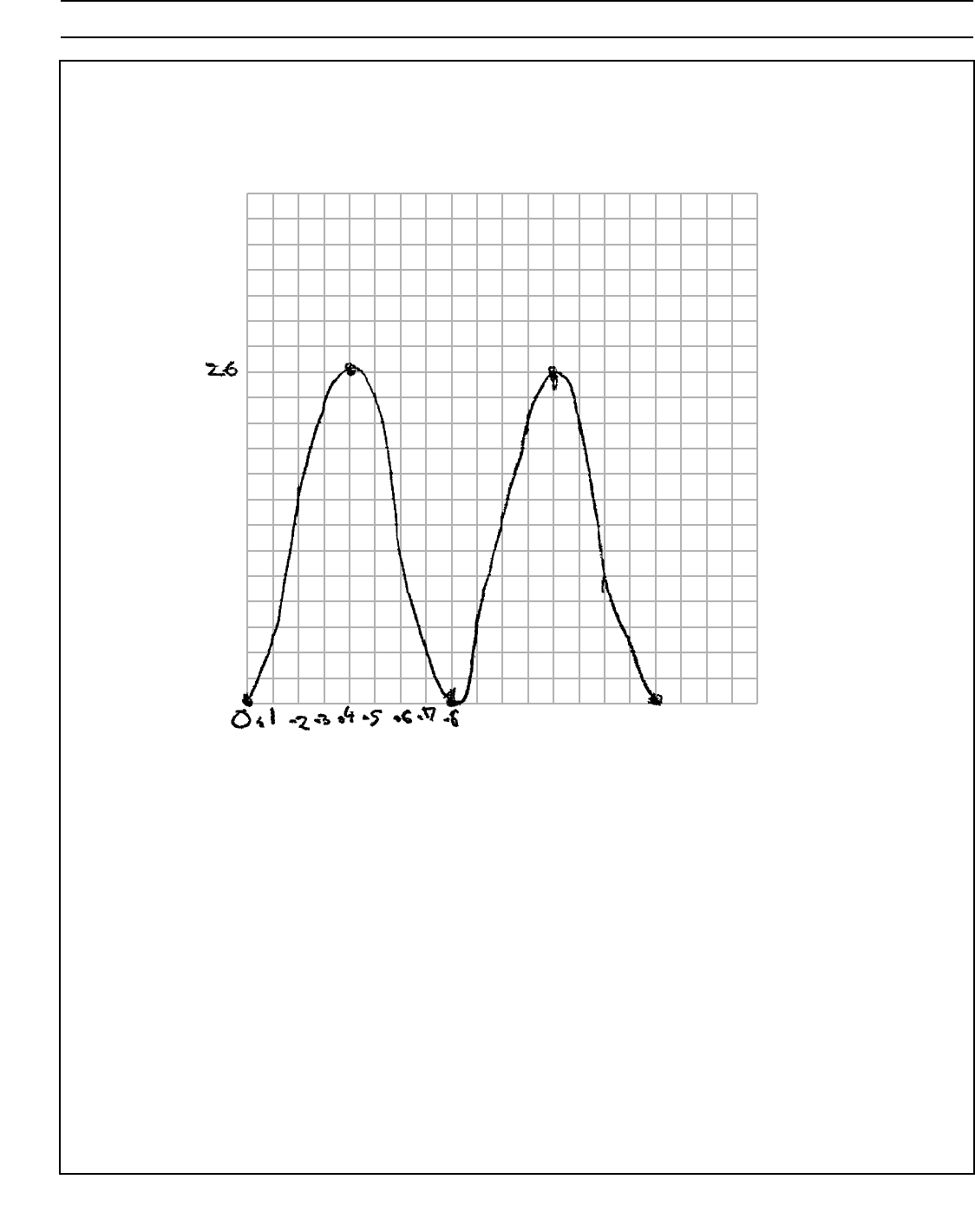
Algebra II – June ’19 [82]
Question 37 continued.
On the grid below, graph at least one cycle of f(t) that includes the y-intercept of the function.
Does the height of the nail ever reach 30 inches above the ground? Justify your answer.
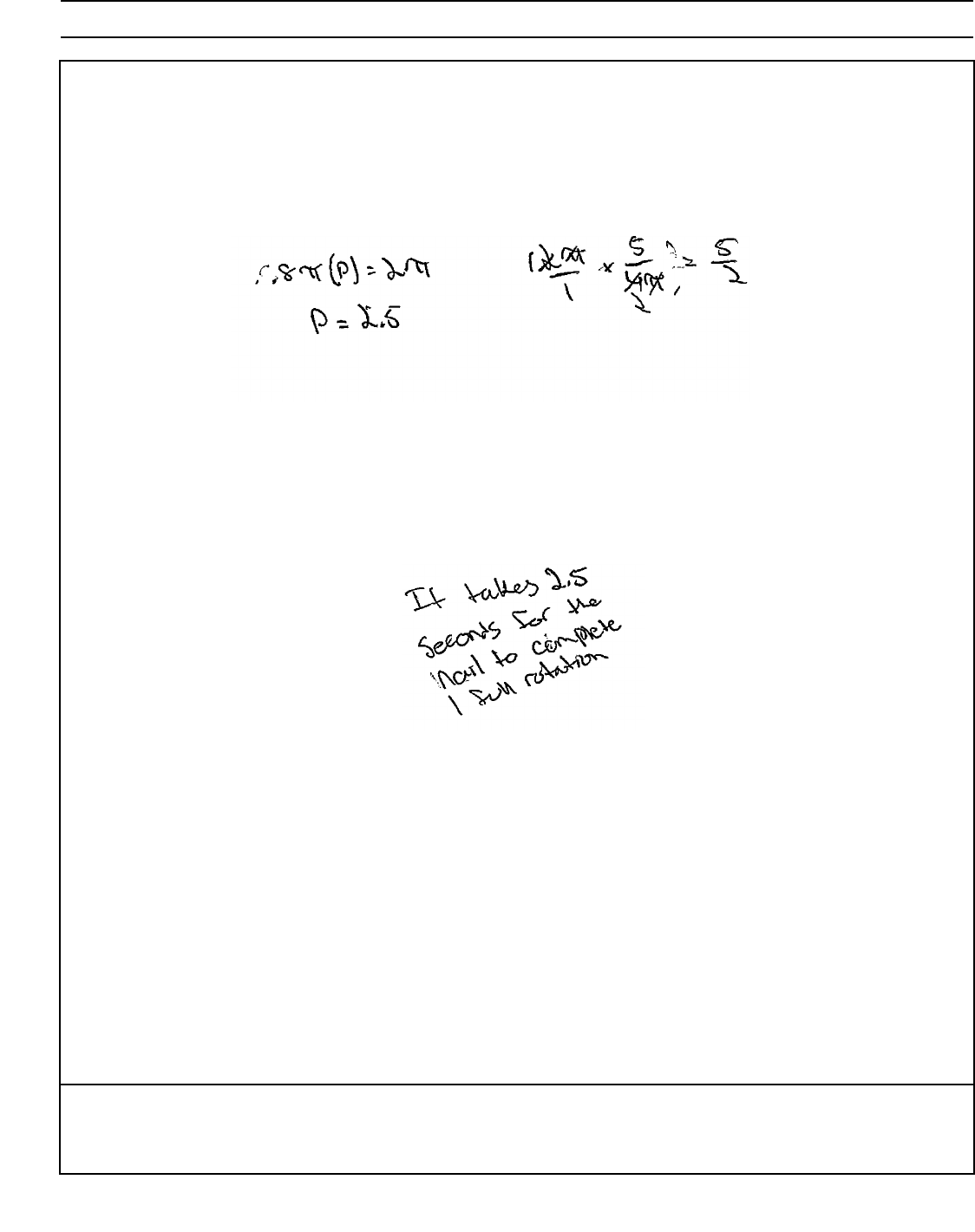
Algebra II – June ’19 [83]
Question 37
Interpret what the period represents in this context.
Score 2: The student received credit for the period and the interpretation.
37 Griffin is riding his bike down the street in Churchville, N.Y. at a constant speed, when a nail gets
caught in one of his tires. The height of the nail above the ground, in inches, can be represented
by the trigonometric function f(t) 13cos(0.8πt) 13, where t represents the time (in seconds)
since the nail first became caught in the tire.
Determine the period of f(t).
Question 37 is continued on the next page.
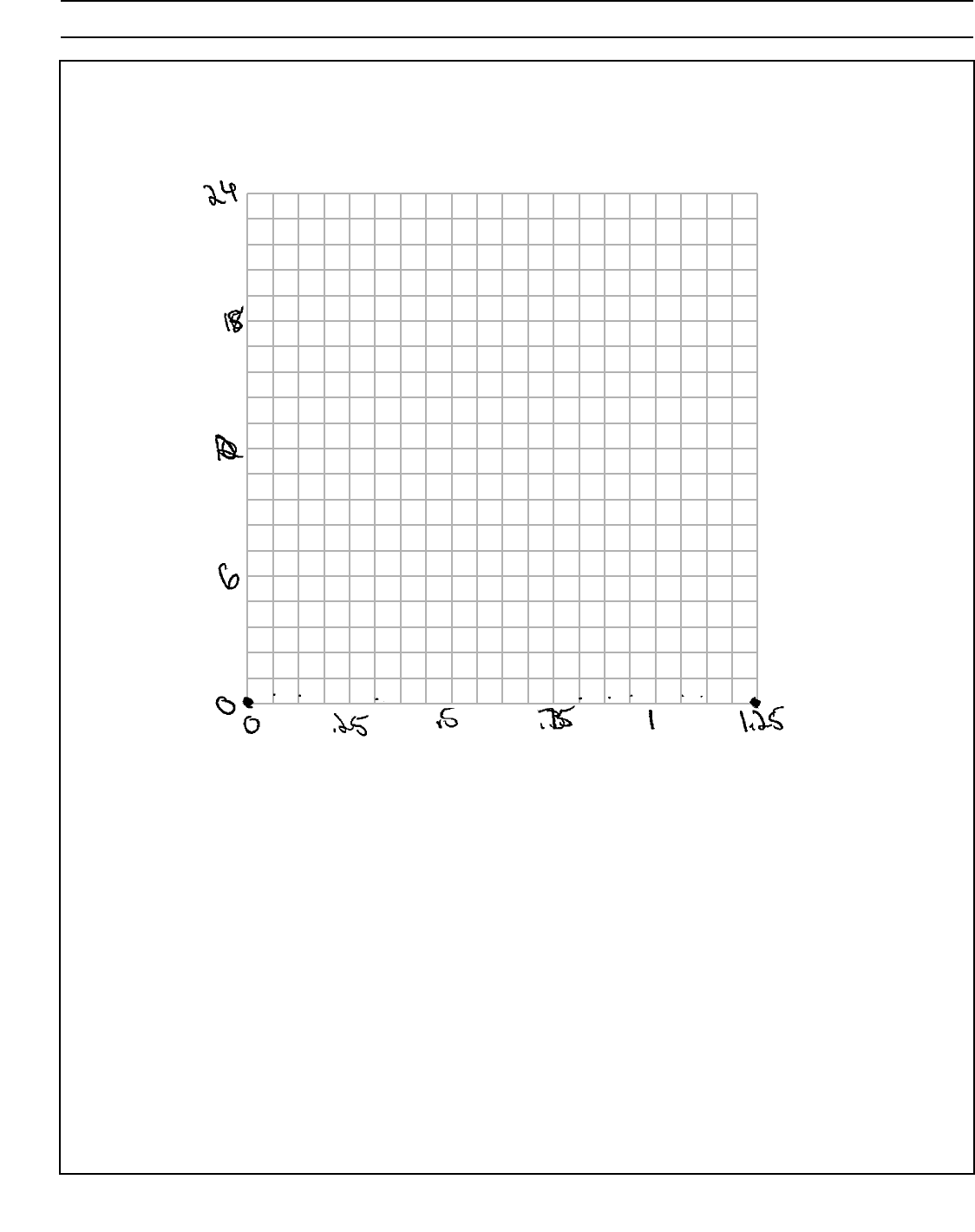
Algebra II – June ’19 [84]
Question 37 continued.
On the grid below, graph at least one cycle of f(t) that includes the y-intercept of the function.
Does the height of the nail ever reach 30 inches above the ground? Justify your answer.

Algebra II – June ’19 [85]
Question 37
Interpret what the period represents in this context.
Score 2: The student drew a correct graph.
37 Griffin is riding his bike down the street in Churchville, N.Y. at a constant speed, when a nail gets
caught in one of his tires. The height of the nail above the ground, in inches, can be represented
by the trigonometric function f(t) 13cos(0.8πt) 13, where t represents the time (in seconds)
since the nail first became caught in the tire.
Determine the period of f(t).
Question 37 is continued on the next page.
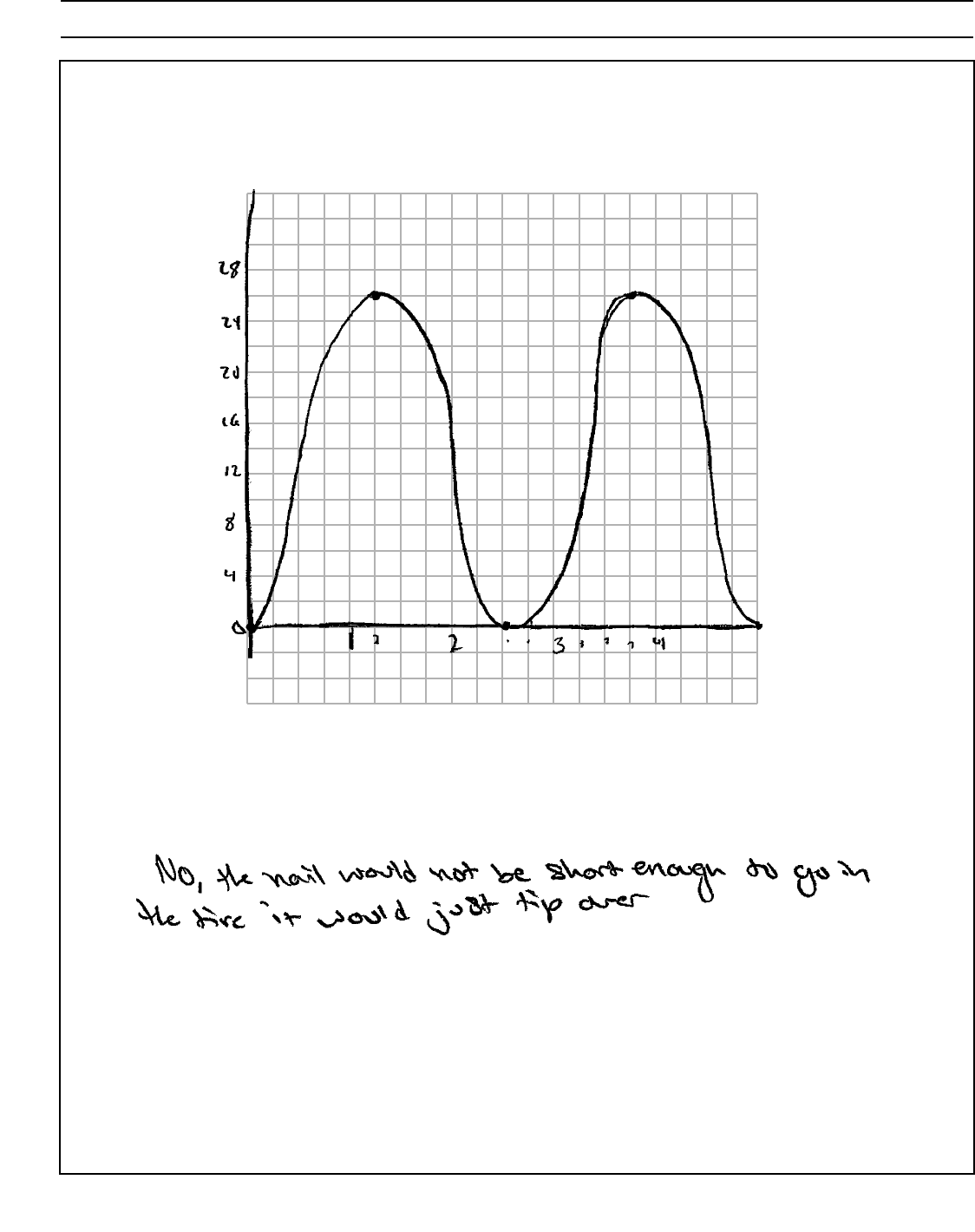
Algebra II – June ’19 [86]
Question 37 continued.
On the grid below, graph at least one cycle of f(t) that includes the y-intercept of the function.
Does the height of the nail ever reach 30 inches above the ground? Justify your answer.
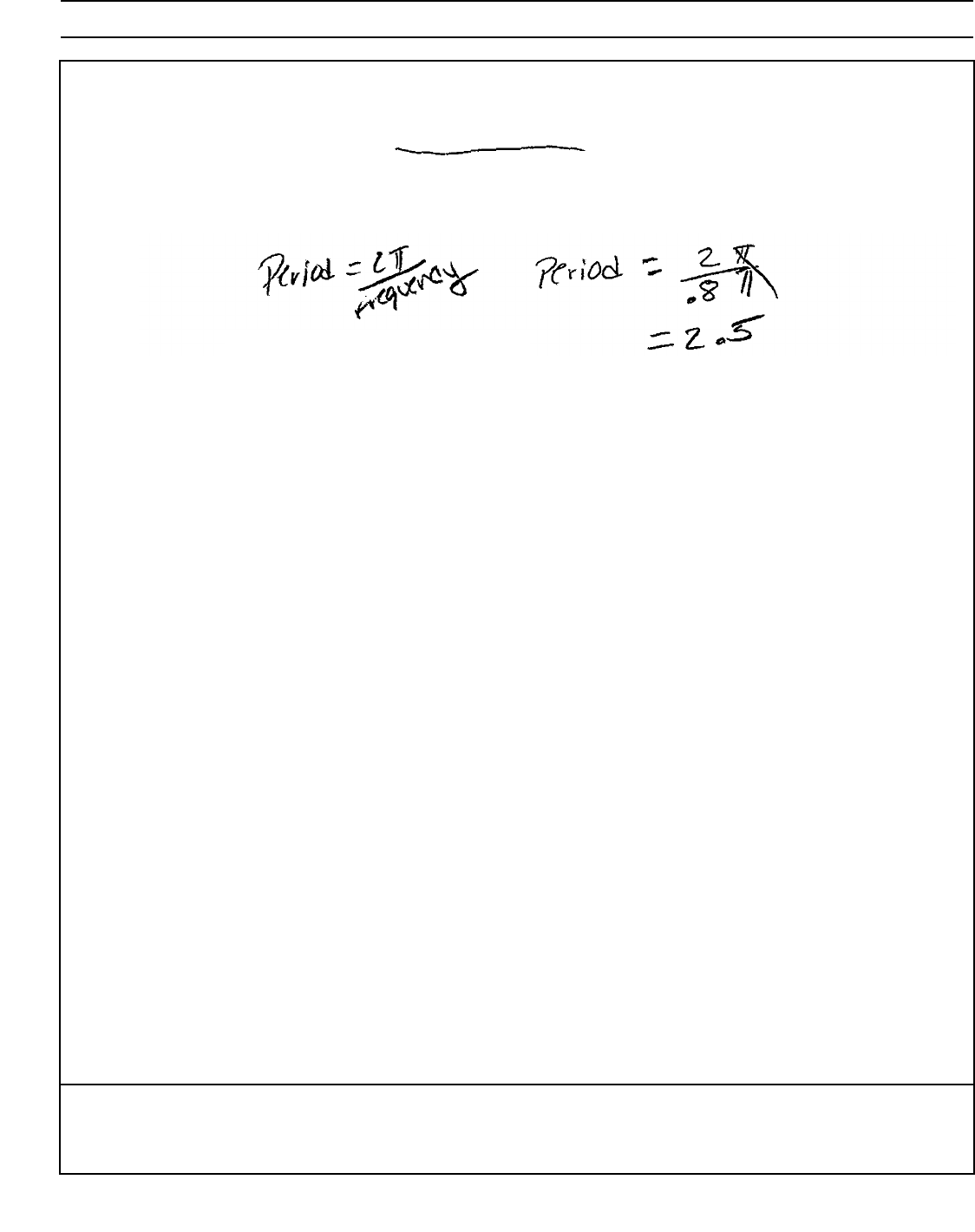
Algebra II – June ’19 [87]
Question 37
Interpret what the period represents in this context.
Score 1: The student received credit for correctly finding the period.
37 Griffin is riding his bike down the street in Churchville, N.Y. at a constant speed, when a nail gets
caught in one of his tires. The height of the nail above the ground, in inches, can be represented
by the trigonometric function f(t) 13cos(0.8πt) 13, where t represents the time (in seconds)
since the nail first became caught in the tire.
Determine the period of f(t).
Question 37 is continued on the next page.
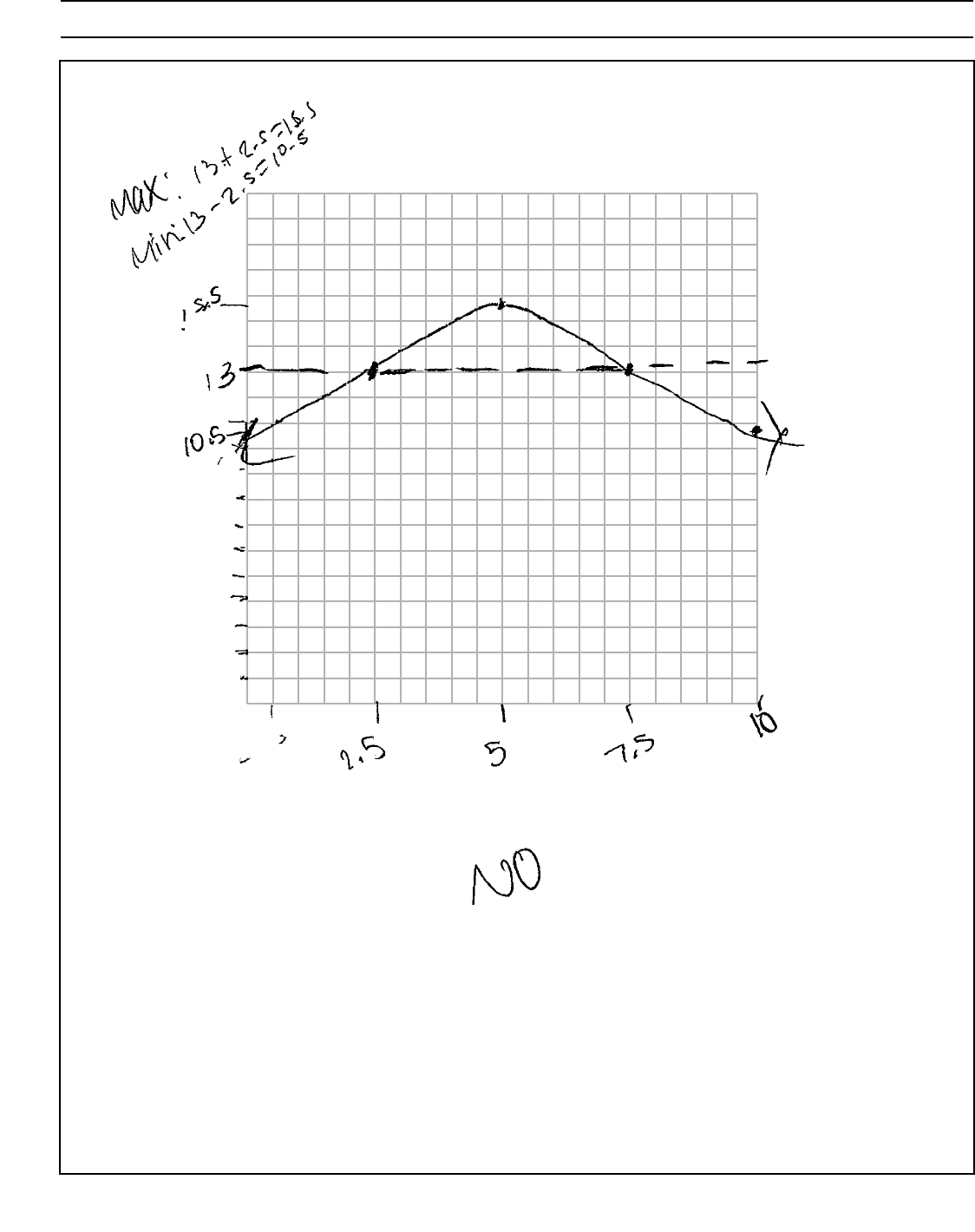
Algebra II – June ’19 [88]
Question 37 continued.
On the grid below, graph at least one cycle of f(t) that includes the y-intercept of the function.
Does the height of the nail ever reach 30 inches above the ground? Justify your answer.

Algebra II – June ’19 [89]
Question 37
Interpret what the period represents in this context.
Score 1: The student received one credit for the graph.
37 Griffin is riding his bike down the street in Churchville, N.Y. at a constant speed, when a nail gets
caught in one of his tires. The height of the nail above the ground, in inches, can be represented
by the trigonometric function f(t) 13cos(0.8πt) 13, where t represents the time (in seconds)
since the nail first became caught in the tire.
Determine the period of f(t).
Question 37 is continued on the next page.
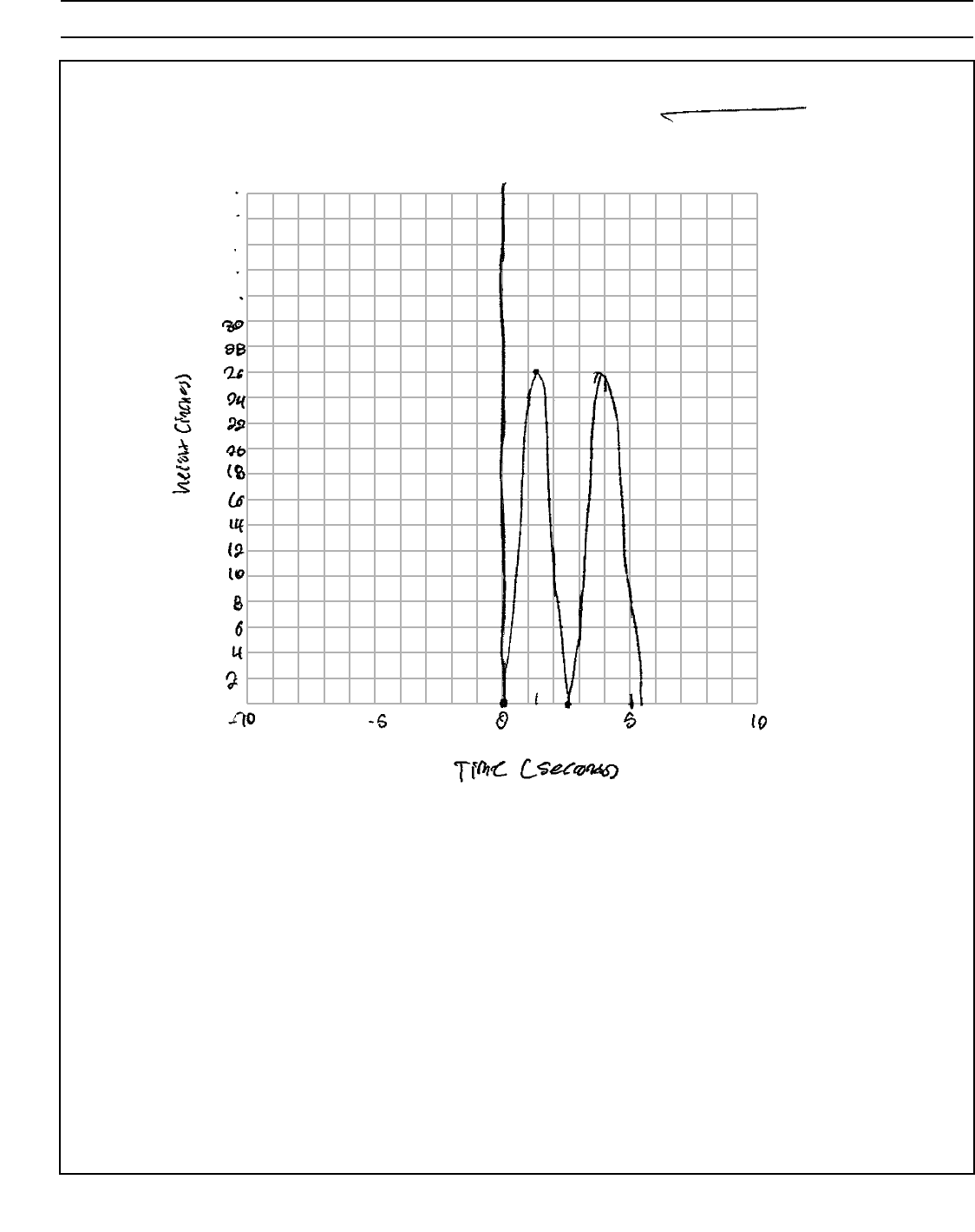
Algebra II – June ’19 [90]
Question 37 continued.
On the grid below, graph at least one cycle of f(t) that includes the y-intercept of the function.
Does the height of the nail ever reach 30 inches above the ground? Justify your answer.
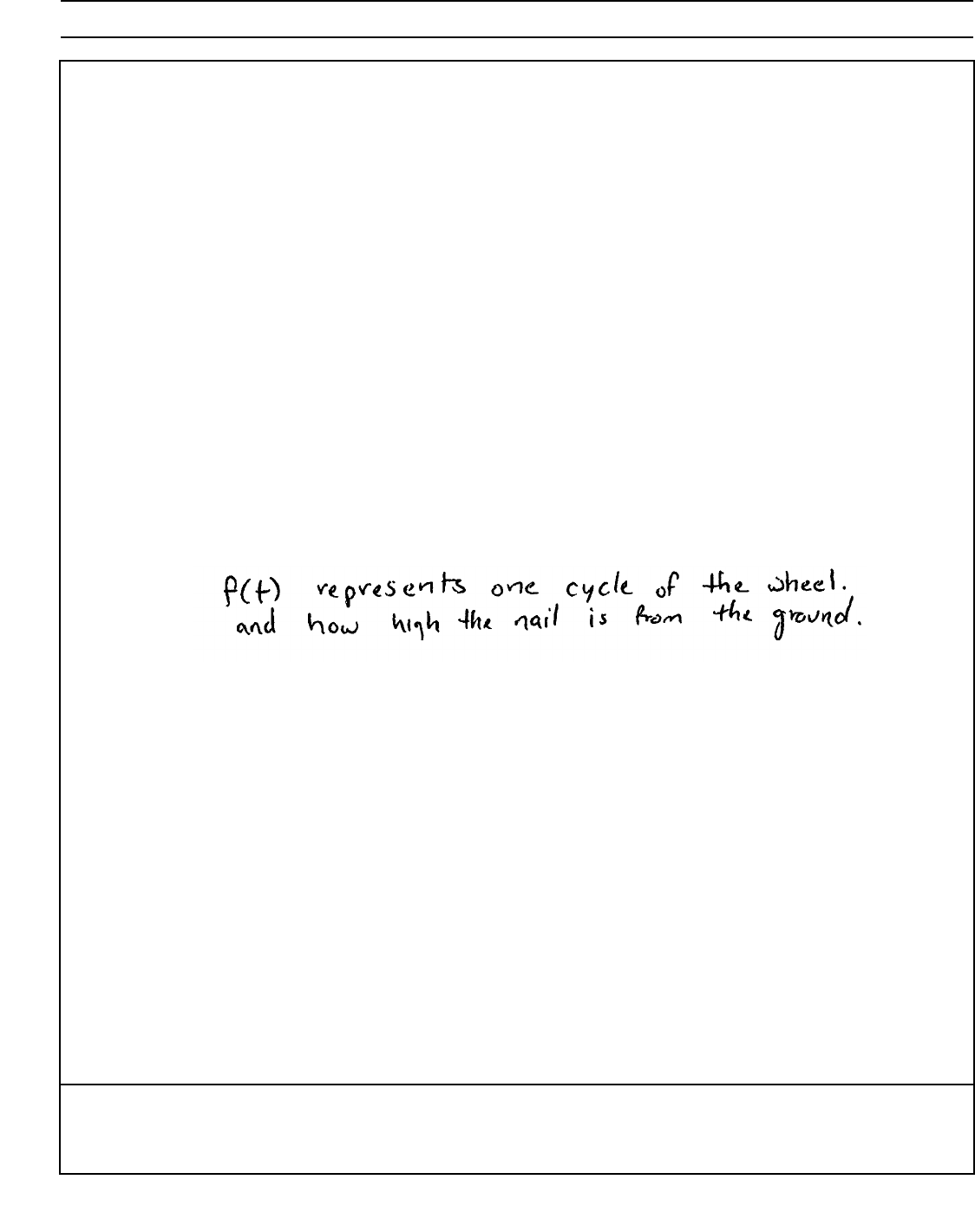
Algebra II – June ’19 [91]
Question 37
Interpret what the period represents in this context.
Score 0: The student did not show enough correct work to receive any credit.
37 Griffin is riding his bike down the street in Churchville, N.Y. at a constant speed, when a nail gets
caught in one of his tires. The height of the nail above the ground, in inches, can be represented
by the trigonometric function f(t) 13cos(0.8πt) 13, where t represents the time (in seconds)
since the nail first became caught in the tire.
Determine the period of f(t).
Question 37 is continued on the next page.
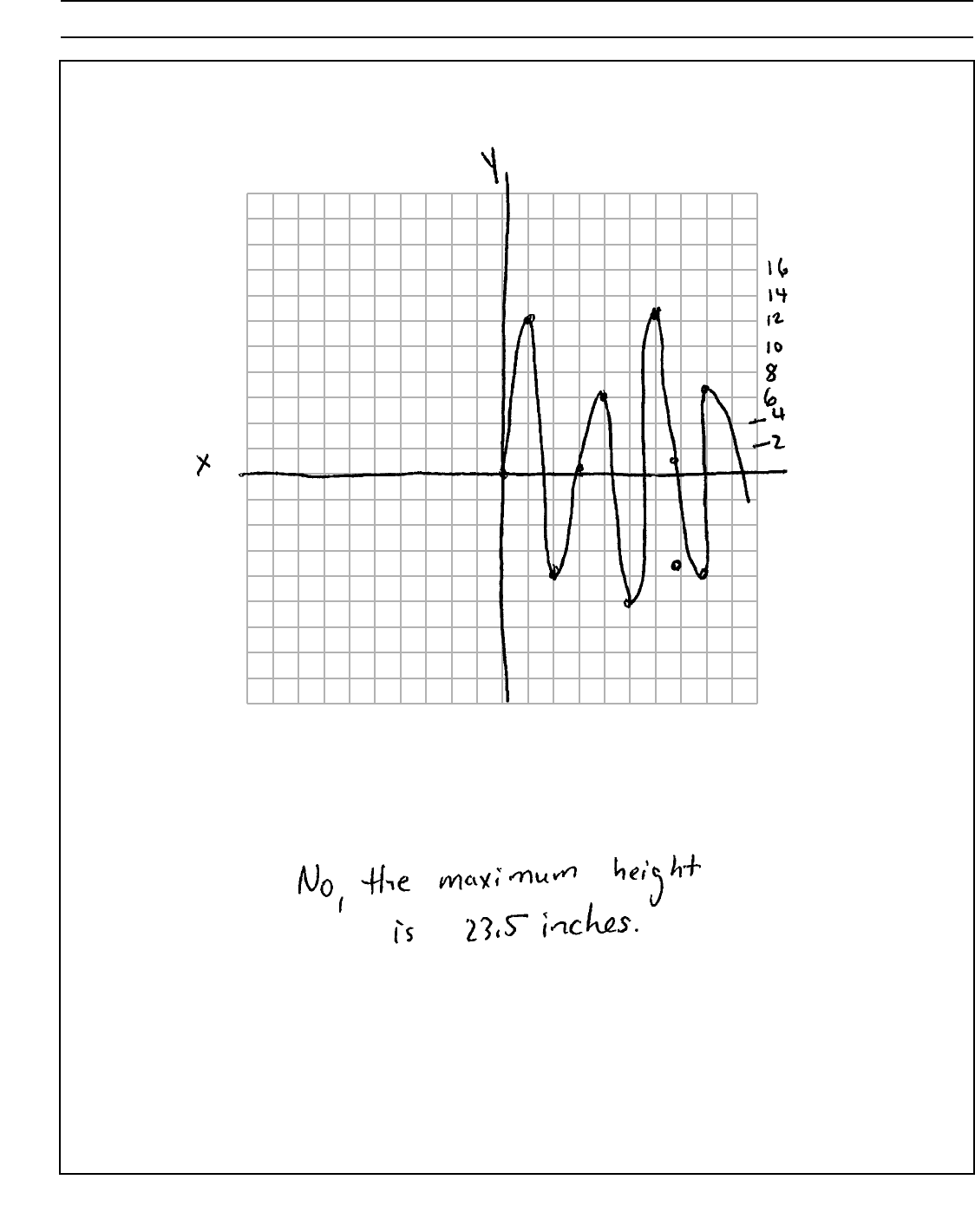
Algebra II – June ’19 [92]
Question 37 continued.
On the grid below, graph at least one cycle of f(t) that includes the y-intercept of the function.
Does the height of the nail ever reach 30 inches above the ground? Justify your answer.
